
- Best Hikes In The World
- Appalachian Trail
- European Hikes
- Nepal Hikes
- Patagonia Hikes
- See All Hikes
- Mount Kenya
- Mount Kilimanjaro
- Mount Toubkal
- See All Mountains
- South Africa
- New Zealand
- Switzerland
- United Kingdom
- Packing Lists

Annapurna Circuit Weather – What To Expect On Your Trek
Due to its location, the Annapurna circuit weather is considerably different than in the other major regions. This is fantastic as it makes trekking possible throughout the year! This is unlike much of Nepal where you need to factor in freezing conditions and the monsoon season.
Before planning any trek, it’s critical to understand the local weather and climate. This is very true in Nepal as, depending on the region and time of year, weather and temperature can vary drastically.
Annapurna Circuit – Climate And Landscape
Often considered to be one of the finest treks on earth, the Annapurna Circuit is second in popularity only to the Everest Base Camp trek . The trek is notable for its climatic changes, stunning views and wild scenery.
The trek begins at Besi Sahar and takes you through sub-tropical meadows and rice fields before heading up into the alpine peak section. The highlight is without doubt Thorung La Pass which, at 5,416m, provides one of the most spectacular views in all of Nepal.
After the pass, the climate changes again as you descend down into the much drier Mustang Region where the land becomes semi-arid.
Annapurna Circuit Weather By Location And Season
The Annapurna Region is actually situated in what is known as a ‘rain-shadow’ area. As such, it receives far less rain than most other regions in Nepal.
A rain-shadow area is protected from prevailing wind and rain by a large range of mountains – in this case the Himalayas . Although not sheltered from all rain, the northern section of the trek can actually get less than 10% of monsoon rainfall.
Annapurna Circuit weather can be separated into four distinct season. Below we look at each season in more detail.
Annapurna Circuit Weather – October to November
By far the most popular trekking season in the Annapurna region. Hikers flock to the region to experience the clean, fresh and vitalised area after the Monsoon period.
On the lower reaches of the Circuit the weather is generally warm with an average day temperature of 15 degrees Celsius and night temperatures remain above freezing.
As you get higher in altitude temperatures drop quite considerably. From about 4000m up the days have a cold nip to them and evenings / early mornings are freezing.
You will definitely need warm layered clothing and a 4-season sleeping bag. For a full Annapurna Circuit packing list, click here .
In Oct-Nov views are generally crystal clear, rain fall is very low and there are more sunny days during this period than any other.
The night sky is particularly good during this period and you’ll be amazed at the billion stars that appear every night in bright clarity!
Because of the favorable weather, this is the busiest period.
Annapurna Circuit Weather – December to February
This is the coldest weather period in the Annapurna region. Depending on your altitude, day temperatures will be very cool and night temperatures will drop well below freezing. Be prepared for delays or complete closure of the Thorung La Pass.
If the pass is closed you will have to back-track on yourself and won’t be able to complete the Circuit. We therefore suggest skipping this period of the year.
Nonetheless tea houses remain open during the cold winter period and if you do decide to trek in this season you’ll find a warm meal and place to rest your head each night.
The winter period generally consists of cloudy days that obscure views, there are frequently crystal clear days that are often more clear than mid-summer!
Towards the end of the winter period around March you’ll start to see the dazzling displays of Rhododendrons as they begin to bloom around Ghorepani . These are not to be missed and turn green hillsides into red, white and pink flames of colour!
Although cold during this period, rain is not frequent and neither are other trekkers.
This is also the period where avalanches are most common and you’ll need to be aware of this as you trek the higher passes covered in snow.
Annapurna Circuit Weather – March to May
The flowering Rhododendrons and warmer weather bring more trekkers during this period. This is the second most popular trekking season and the snow that plagued the route is all but dissipated on the lower sections.
April is a beautiful time for crystal clear views, especially when you combine them with the bright red hills of Rhododendrons. The average day time temperature at lower altitudes is around 10 degrees Celsius. Nights are usually freezing.
Obviously the higher you go the colder it gets. Over 4000m is usually freezing cold in the evenings and mornings, with a cold nip in the air during the day.
During May a strange haze often appears over the mountains that can be seen at low altitudes. At high altitudes the view is vividly clear and scientists are still a little confused by this strange phenomenon.
May is usually much warmer than April as the heat builds towards the Monsoon period.
Day time temperatures can get towards 20 degrees Celsius at lower latitudes and night temperatures are around 5 degrees (again, at higher altitudes you should expect freezing cold weather).
The lower sections of the Annapurna Circuit can get uncomfortably hot, particularly in the Mustang region where the climate turns arid. Drink plenty of water and remember to wear layers.
Annapurna Circuit Weather – June to September
Mid-June sees the arrival of the Monsoon period.
Because of torrential downpours, hordes of leeches and huge mud-slides, characterise this period.
However, thanks to the Annapurna’s location, much of the Circuit can be trekked during this period, particularly in the northern sections where rain fall is incredibly low. We however don’t recommend trekking in the monsoon season.
The southern section around Pokhara gets heavy rainfall and is best avoided in the wet season. However, the Mustang region lies within the rain-shadow area mentioned above and makes trekking perfectly possible during the Monsoon.
Whilst Pokhara get 800mm of rain per month during this period, areas such as Jomsom and Mapha get as little as 50mm!
You’ll encounter very few other trekkers and you’ll have the added benefit of seeing all the beautiful flora species flower at this time which makes the trek particularly lovely.
Be warned though that rain clouds will obscure much of the landscape and you’ll still need to be watchful of mud-slides.
If you have further questions about the Annapurna Circuit weather, please just leave a comment below and we’ll get back to you shortly.
Thank you and happy trekking!
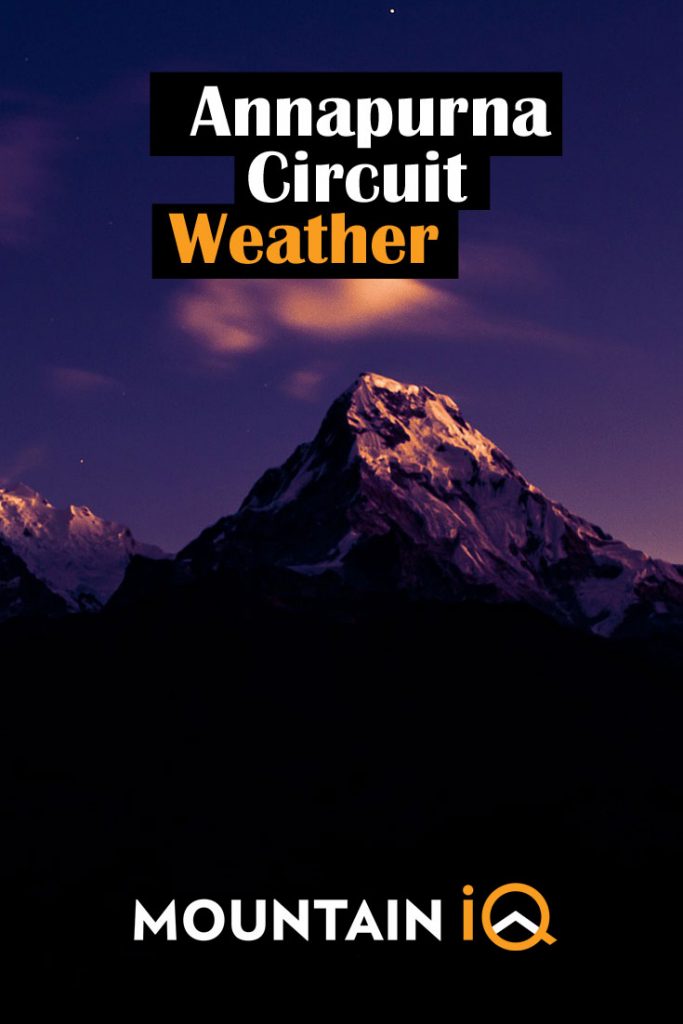
References : Government of Nepal, Department of Hydrology and Meteorology, Meteorological Forecasting Division
About the author
Andrew Roux
Andrew is one of the senior writers at Mountain IQ. A native of South Africa, Andrew has hiked and climbed all over the world. His favourite destination is Nepal and his most memorable hike was to the summit of Mount Kilimanjaro!
Leave a Reply
Your email address will not be published. Required fields are marked
Hello, I am a college student and I have a study abroad in Southern Africa until May 25th at which point I plan to fly to Nepal to do this trek. Will the monsoon detract from the experience enough to warrant me postponing this trip indefinitely? I plan on trekking the Anapurna circuit to Kagbeni, then going to Lo Manthang before finishing the Anapurna circuit.
Hi David, the monsoon in the Annapurna region is generally lighter than in the southern and eastern sides of Nepal. That being said you are still likely to encounter rain, lots of cloud cover and unpleasant weather conditions in the monsoon season. Personally I haven’t trekked in the Annapurnas during this time so have no first hand experience, but would say that if you are restricted to this timeframe the Annapurnas provides the best chance for avoiding the worst of the monsoon. Hope this helps!
Hi David, thanks for your great information on the Annapurna circuit (and Annapurna packing list guide!). I’m heading over with a mate on the 22nd April for 3 weeks. We’re starting at Kathmandu, heading up to Thorung High Camp, up to Muktinath then back down around to Pokhara, finishing off in Chitwan. I have quite a lot of gear already, including a 2 month old 5 degrees celsius rated Denali mummy sleeping bag. We’ll be staying in tea houses for most of the trek (hotels before and after trek), do you think a 5 degrees rated synthetic sleeping bag suffice for April/May?
Hi Tony, Sounds like you have an awesome adventure lined up. You should be fine with your current sleeping bag. Almost all teahouses have extra blankets if you are cold and you can always wear your thermals in bed! All the best!
Great, thanks David
Hey Tony, Wonderful information! Thanks for posting this. I am planning to do the same hike end of Jan. I have 11 degrees C Quechua sleeping bag and plan to sleep in tea houses. I have Patagonia thermal inners and other winter gear from Columbia and Patagonia. Is it possible to hike during the end of Jan? Will my sleeping bag do the work? Warmly, raghu
hi,tony , good luck for your adventure journey. hope to meet you there, we too heading at same day.
Hi, me and my friend are planning to hike Annapurna Circuit In mid-June. I was wondering how low does the temperature go? Does it go below zero? Do we need very warm clothing? Thanks!
Hi Agne, yes, you need warm layered clothing for the Annapurna Circuit. Once you get above 3,500m the evenings and early mornings are very cold. Crossing the Thorung La can also be very cold. For a detailed packing list see: https://www.mountainiq.com/resources/annapurna-circuit-packing-list/
Super! Thanks. We’re just thinking if we really need that super thick third layer. Could it be a lighter jacket if we have a thermal clothing first layer, then a fleece for the second layer?
Hi, I’m heading off on the circuit in a few days and wondering if it’s necessary to take a sleeping bag? I have a warm down jacket and several pairs of thermal underwear and am happy to sleep in it all – would prefer this to lugging a sleeping bag around. But I also don’t want to spend the whole trip freezing!!
Hi Trish, I would recommend taking a warm sleeping bag. Teahouse rooms can get super cold! Most teahouses have blankets but these are typically not very warm or hygienic. All the best!
I’m confused how warm my clothes have to be when I walk Annapurna Circuit in the end of April/May. YOu say at days it’s warm, so it sounds like there is no down-jacket necessary when I wear a layering consisting of long underwear, fleece pullover and rain jacket. 5 degrees at night sounds like I don’t need a down-sleeping bag, but a light one and get a wool blanket in the tea houses. On some other websited it’s written that when one reaches high altitudes it’s very cold so one definitely need a down-sleeping bag and down-jacket. But is it in the end of April and May really that cold in high altitudes??
Thank you a lot! Adele
Hi Adele, yes you definitely need warm clothes, including a warm winter jacket (down or synthetic) and a four season sleeping bag). As you get higher up on the Circuit temperatures drop dramatically. Nights will be freezing all year round at altitudes over 4000m. All the best!
I was hoping to ask a quick question about the circuit. I have read that a guide is required, but my wife and I were hoping to not use a guide as we like to travel at our own pace and not have someone rushing us along. We are more of the slow walking type, with no real need to rush from point to point. Does anyone know if the law went into effect or is still in effect about needing to have a guide for the circuit? Sorry, I realize this is a bit off topic for this page, but I have not found anywhere better to post it. Thanks!
Hello, I’ll be hiking the Annapurna Circuit this July, so I’m expecting to hike in rain. Would you please advise whether a lightweight rain jacket is better or should I get a warmer rain jacket? I plan to layer, and I’m concerned about my rain jacket being too hot at the lower elevations. (I live in the mojave desert, so I have no experience hiking in rain. )
Hi Jennifer, I would take a lightweight hard shell rain jacket that you can wear over your layers. This will allow you to use the jacket lower down on the trail where temperatures are higher, and high up on the Circuit, where you can wear the hard shell over your warm winter jacket. The Patagonia Torrentshell is an affordable waterproof jacket, or jackets from Berghaus, Montane, Arc’Teryx or The North Face are all good. Just Google: Waterproof hard shell jacket to get recommendations. Cheers!
Hey there. I’m starting my trek 24 September from Bhulbhule, heading up to the Nar Phu Region. As it’s the end of the monsoon season, did you still have any issues with leeches/mossies?
Hi Daf, you should be absolutely fine by late September. All the best!
Hi Mountain IQ,
We’ll be trekking the Annapurna Circuit in August. Do you think ski wear e.g. jacket and trousers would be sufficient? Also would you recommend leech socks?
Hi Paula, you should be fine with ski wear for the higher reaches. Just make sure you have a number of layers to compliment your ski wear. Leech socks are probably a little overkill, but better prepared than not. All the best!
Hi, A few friends and I are planning to trek part of the circuit late this August clockwise (understanding that most do it counterclockwise) but because we have limited time we will only be doing parts of it. Unfortunately, I will need to turn back early (between Jomsom and Muktinath) to go back to Pokhara. I am trying to figure out if I need to either trek back to the beginning or will there be accessible buses/jeeps to catch near Jomsom or Muktinath? Will the monsoon season play a major role on how accessible the road conditions will be? Any help would and advise be greatly appreciated. Thanks!
Hi Nico, There are transport options from Jomsom and Muktinath so you should be able to arrange a bus back to Pokhara. See the section below suggested itinerary here: https://www.mountainiq.com/guides/trekking-in-nepal/routes/annapurna-circuit/
I am reading everywhere leeches, leeches and leeches. What can I expect during the monsun period. Will they climb my hiking boots and crawl into my trousers?
Best regards, Paul
Below the tree line during the monsoon season there are leeches, generally you can steer clear by wearing long trousers and just being vigilant when you pass through a highly vegetative area. All the best!
It’s me again. Sorry for so many questions. In the Internet it is written that people disappear on the A/C. Is it because people get lost by taking the wrong route or they get kipnapped?
Almost certainly lost, not kidnapped! Although I wouldn’t say many people get lost every year and those that do usually find their way back to the main towns. Cheers!
Hello, thinking of trekking the Annapurna Circuit in May – what is the avalanche risk like at this time of year? Has it mostly dissipated by this point of the year? (This is my main concern other than altitude sickness!)
Avalanche risk for trekkers in the Annapurnas is very low as you will not be exposed to snowny pistes, like climbers in the region. Landslide risk is however quite high in the Annapurnas. May is usually a stable month, higher risks is around the monsoon season. Hope this helps!
Hello – I am considering the Annapurna circuit in mid-September (starting on the 11th or 12th). Unfortunately I can’t start later than this. How do you think the weather will be during the early/mid-September period, will it still be rainy and cloudy? Thank you!
Weather in mid-September can be a little wet still, but in general you shouldn’t be hit by monsoon rains. That being said, the monsoon season seems to be getting later and later in recent years. All the best for your trek!
Me and my fiancé have planned to trek from Jomsom down to Phokara from mid-may to end of May. How do do you think the weather be like? I’m a bit concerned about the “haze” you mentionned…many thanks.
Hi Tiffany, it is possible that it will be foggy and quite wet, but generally mid-May is okay. By June though the Monsoon arrives and the likelihood of wet weather is relatively high. All the best!
I’m planning on doing this trek within the next couple weeks. Have any idea on the weather and etc?
Expect very cold weather on the higher reaches of the trek and possibly a lot of snow. I would take yak tracks just in case and make sure you pay attention to weather forecasts as you approach the Thorung La pass as weather can change rapidly at this altitude and you don’t want to find yourself in a snowstorm. All the best!
Has anyone hiked the AC without a guide? Is it legal? I know we still have to pay for the permit, etc. We’re going mid May, and are experienced hikers! Thanks!
Hi Sarah, it used to be legal, although I think the rules changed after the 2014 snowstorm: https://www.mountainiq.com/2014-annapurna-circuit-snowstorm/ . I might be wrong and you may still be able to trek without a guide. Can anyone else chime in?
Can Annapurna Circuit be done safely and enjoyably in late monsoon months, August to first half of September?
Hi Susan, yes, late August into September is generally fine. All the best!
Hi, a friend and I are thinking of hiking the AC in the time frame between May 20 and June 6th. If possible maybe even starting a week later. What is the weather like during this time? I know it is the beginning of monsoon season and wonder if you can speak to whether we will encounter many leeches and what views will be like.
Hi Rachel, it is possible to trek the Annapurna Circuit in a shorter time frame but it could mean you have to skip sections at the beginning and from Muktinath, and instead take a car. Also you need to consider altitude sickness risks if you don’t give yourself enough time to acclimatise before the Thorung Pass. In terms of weather you should be okay as the monsoon season can arrive late in the Annapurna region. All the best!
Hello! My friend and I will be hiking the circuit this year. I am pro, lets start in October, and she is no lets start mid September to avoid the crowds. Just curious as to how much of a difference with people there will be. Also realistically can you still get great view in September. Cheers!
Hi Abby, the difference in trekker numbers is not significant enough to notice. Mid September is usually fine for views, especially as you get higher up the trail. Of course, if the monsoon season drags on for a bit then a later start in September / early October is ideal.
Hi, I am going to do the ABC trek mid August next month. I was advised that it will be less rain at that time. Is it correct? I try not to carry a rain coat. Also, can you please advise how cold it will be in the base camp area? I will bring a good sleeping bag which is good at 0 – 4 degree, however I am wondering if I should still need a thermal reactor up in that high altitude. Also, will the base camp get very windy? Thanks very much.
Cheers, James
Hi James, mid August is towards the end of the monsoon season in Nepal so encountering rain is still quite likely. As a precaution I would recommend bring wet weather gear. The temperatures at night and in the early mornings as you get higher up the ABC trail can get very cold. A good winter (4 season sleeping bag is a must). It can also get quite windy so layered clothing with a warm winter jacket is important. I recommend checking out our packing list for the Annapurna Circuit as it applies to ABC as well. https://www.mountainiq.com/resources/annapurna-circuit-packing-list/
Hi, we’re looking at doing the trek in early May. your write up mentions the snow being mostly cleared from lower altitudes but how much snow might be wexpected over the higher sections? do you think that we would we need particular kit for this part?
Hi Jon, it is difficult to predict weather so far out, especially since things can change quickly and dramatically at altitude. In generally there shouldn’t be much snow in May, although you may encounter snow on the Thorung La Pass. In terms of kit, here is a detailed packing list: https://www.mountainiq.com/resources/annapurna-circuit-packing-list/ .
Hi – I’ve been spending a bit of time looking through comments to posts on various blogs following on from my trek on the Annapurna Circuit and as I recognise many of the questions I had up to leaving five weeks back I thought it might be useful to offer my thoughts.
I trekked through November and due to what I thought were time constraints essentially did half the circuit on foot, taking the bus from Jomsom to Pokhara after eleven days. That was a mistake and I wish I’d given myself more time, though you will find sections of road that are just unpleasant to walk due to high levels of dust. From Jomsom, many caught the bus to Tatipani to pick up the older trails again and I should have done the same.
But to the question of gear which was mostly my concerns and puzzlement before leaving. I’m always on a tight budget so despite drooling over all the fancy North Face/Rab gear online, I have to find cheaper kit to cope. As Mark says, the early mornings and evenings get pretty cold as you head higher and you’d be a fool not to have a down jacket of some description, even with the extra hassle of carrying something so bulky at the lower altitudes (I certainly found it awkward). However, by the time you’re over 4,000m you’ll be wearing most of that extra gear and pleased you have it with you. Don’t forget the fleece-lined trousers! I found an old Alpha Industries down parka on eBay for $50 which has now become my go-to jacket of choice due to being so reliable. This, along with a wicking base layer, thin fleece top and a casual Uniqlo ultralight high street down jacket that stuffs down really small became my daily dress in various combinations as the day progressed. By the time you hit base camp, you’ll be wearing all of this! Footwear is another thing and whilst I certainly did see people in trainers, it’s ill-advised. Sure, much of the trail is pretty flat but other sections most certainly are not and you’ll be glad of the extra thick soles of proper walking boots and ankle protection they offer to avoid a bad foot placement becoming something much more serious. It’s an exhausting journey and as the air thins so your legs become increasingly tired and simple missteps become more of a hassle. I overcompensated for a missed step, shot my other foot forward for balance and promptly penalty kicked a rock that hasn’t moved for millions of years and certainly wasn’t going to make an expection in my case. Result? A seriously painful toe for the next hour but at least one which was adequately cushioned from something far worse which might have stopped me in my tracks from continuing.
On the sleeping bag issue. I took the risk of going with a three-season down bag, which packed down much smaller than my older, heavier and warmer bag. With a silk liner and whatever blanket you’ll get at a teahouse, I was never outside my comfort rating. No one has asked about trekking poles but I’ll comment here; They’re something of a mixed bag personally. I couldn’t use them initially because I was having to carry my down jacket until I figured a way of hanging it off my rucksack, but then decided I didn’t really feel the need for them for most of the route. It’s worth bearing in mind they add a 25% energy deficit to your exertions as you’re using muscles not intended for walking, so bear this in mind when feeding yourself. They most definitely are needed once you’re heading for base camp, if only to hang off and struggle for air on the steep climb. I found they’re more useful to control your descent (and it’s a long one once over the pass), acting as brakes. So I was glad to have them for the final push but didn’t feel a real need to use them beforehand.
Apologies for hijacking your blog, Mark but I thought as someone who has been back less than two weeks from the trek, my observations might be useful.
Thanks Tony!
Hi! Yesterday me and my brother booked our flights for february 23rd up and until april 22nd 2019. Now I read that this will be the overflow from winter to spring. How cold can we expect around this time of the year? Are we still more in the winter season or already spring season you think? Not sure what we should prepare for. Thank you very much in advance. Bianca
Hi Bianca, February is the tail end of the winter season. April is early Spring in Nepal. Both periods are fine for trekking the Annapurna Circuit, but if you can I would start a little later than your arrival date, say mid to late March to give yourself the best chance of good weather. Here’s a detailed packing list: https://www.mountainiq.com/resources/annapurna-circuit-packing-list/
How will the Annapurna circuit be in this first week of Jan 2019? Is it safe to trek?
It is safe to trek but there could be a lot of snow – the Thorung La Pass may be closed. It is worth checking with locals as you proceed up the trail to get a sense of the conditions and make sure to keep a close eye on the weather.
I will be trekking the circuit from march 19 though the first week of April. I tend to run very hot ( I usually have two layers less than everyone else I’m with). My question is that I have a Patagonia nanopuff (warm when wet – and it is!!!) jacket and both merino and capilene base layers, plus a fleece layer. The guide company ” provides down jackets.” Should I go ahead and trust that they will be warm enough or bring my own?
The caveat is that I’m larger (women’s size 12/14 top) and I’ve found in Asia sizes are not made for us ?
Hi Teresa, to err on the side of caution I would bring your own jacket.
Thanks for your great article, it helped me a lot!
I am going to trek the Annapurna Circuit soon, starting the 26th August. I have read that the northern area of the circuit is rain-shadow, but I don’t know what villages this northern area correspond to. We are thinking on shortening a bit the trek, what villages do you think are rain-safe to start and finish our trek? Do you think there will be snow at all? In the Thorong La pass maybe?
Thank you so much for your great help!
Hi Berta, yes, much of the Annapurna Circuit is in a rain shadow. Unfortunately you still need to start your hike lower down the trail, unless you are pre-acclimatised. The villages further up the trail are at high altitude and many are not accessible by road. Most people start the Annapurna Circuit from Besisahar and finish their trek in Jomsom, where you can fly back to Pokhara. Encountering snow higher up the trail is possible, but generally alte August and September are clear. The most likely point to encounter snow would be the Thorung La. Hope this helps!
Thanks for the info. Appreciate your detailed write up and pics.
Hello, my husband and I are thinking of doing the ABC trek with our two kids aged 11 and 9 during late November, spilling over to the first few days of December. We have previously done EBC but for our kids, this will be their first major trekking experience. Would anyone know if kids this age could handle the ABC trek?
And even though historically Oct-Nov is supposed to be the dry season, has there been a shift in the monsoon season this year? Is it still raining? And if raining, would we have to deal with leeches? Any advice/ comments would be a great help! Thanks!
Thanks for this great blog and your expert answers. I‘m planning on doing the Annapurna circuit from 1st to 15th March this year with two friends and couldn‘t find a lot of information about this time period. We‘re wondering how many snow we should expect and how cold it‘ll be. Do you think the pass could be still closed at that time? Is there a high risk of avalanches? Would you recommend to take yak tracks?
Thanks for your help!
Hi Hanna, thanks for getting in touch. It’s difficult to predict weather conditions this far out, but March is a relatively good time to trek the Annapurna Circuit. My advice is to have a plan B but expect plan A to play out. In other words there may still be lots of snow from the winter and it is possible that the pass could be closed, so being flexible with your itinerary is key. But I suspect the pass will be open. I would take yak tracks just in case. Hope this helps!
Thank you so much for you quick response, this helps a lot.
Thanks for the info.
Hi everyone,
I am currently doing Annapurna circuit, sitting in the guest house as you read this.
My and friend has taken the advice of this article and realised that it has not been inaccurate. We have experienced rain on the trek from dharapani onwards.
We experience chilly winds constantly and from 3000m onwards, there was snow fall.
We at our lodging at 3200m right now and the town is caked in snow. We were cold when we reached. And we have yet to even reach the highest point.
Our guide has told us that the weather has been consistently like this above 3000m. So this was not unique weather.
Stay safe everyone, and pack for cold. The silver lining is that there are outdoor shops around you as you hike.
Month: April
Hi, How is the weather at the beginning of March?
Hi Simona, the weather in the Annapurna region is generally stable, and the days are usually clear and sunny inn March.
We work with local guides to offer great value adventures at unbeatable prices.

Radiant Treks
Annapurna Circuit Temperature and Weather Guide
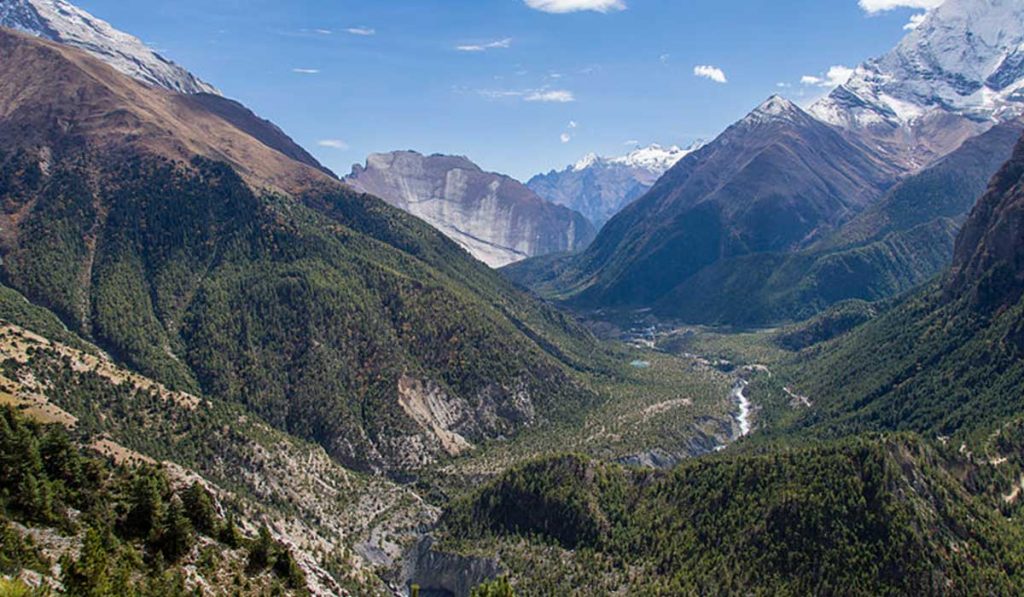
Annapurna Circuit Trek is full of wonder, energy, excitement, distinct culture, and mystical experience. ABC is the second most popular trek following Nepal’s Everest Base Camp Trek. This trekking path is overwhelmed by domestic and foreign trekkers on the paths with strength and enthusiasm.
The Annapurna region is among Nepal’s most critical rain shadow regions. As much of the path lies on the lee side of mountainous Annapurna. This area gets monsoon precipitation of just 10%.
Throughout Annapurna Circuit Trek, you can notice dramatic shifts in weather and temperature. The highest north region has different climatic conditions as compared to the lowest east region. The atmosphere and region’s temperature swings to a lesser extent with an altitude rise.
The maximum daytime temperature during the summer season reaches between 20°C and 30°C. The daily maximum temperature doesn’t reach 20° C during the winter season.
While this trip can be performed throughout the year however, weather plays an important role in deciding whether the trek is on or not.
So trekkers ought to take into account the weather and temperatures of every month before deciding anything.
Four most prominent seasons around the Annapurna region are Autumn, Spring, Summer, and Winter. The worst or difficult season to trek around Annapurna Circuit is Monsoon and Winter.
Annapurna Circuit Weather and Temperature in Autumn months
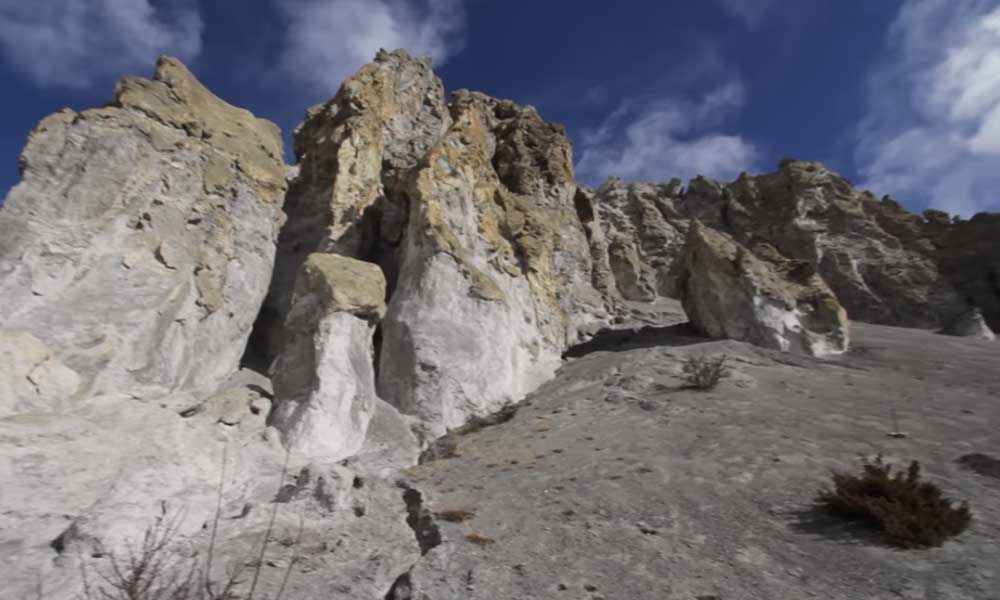
September is Autumn’s first month and also a peak season. The weather is getting bright and transparent day after day with the beginning of Autumn.
Yet the first couple of weeks in September, you will see light downpours showering. Then, around mid-September, the rainy season will go ahead.
From mid-Autumn, you will start getting the signals of a crystal-clearing environment. The temperature begins to fall at about 17°C to 4°C with all the rainfall away.
The highest point of the trek, Thorong La Pass (5416 m) , does have a daytime temperature of around -4°C . From the first month of Autumn itself, certain cloudy skies disrupt the view of mountains.
The alpine terrain, moreover, is here saturated by the monsoon rains and its vegetation. Here you will admire the view of the nice and clean countryside.
The weather is beginning to get better over time. The skies are mostly blue throughout late September.
October falls under the Autumn Season which is the perfect time to go trekking. The weather is steady and accurate, with less rain and chances of snowfall since the rainy season has only just finished. For nearly the entire period, sights of the mountains are unimpeded.
As well in this period, trekking is more convenient, as the days become sunny and warm. The average temperature is 15°C and the minimum temperature is not below 7°C .
The lower regions in the circuit are mostly dry, with a mean daytime temperature of 15°C. The higher regions are much colder than that of the lower region. It is cold early in the morning and in the evening too.
Over the October in upper areas are near to the freezing point. And overnight temperatures hit 7°C to 8°C . The Thorong La Pass becomes much colder than any other circuit spot. . Having heavy and warm clothing in the bag is suggested.
October’s hot and humid days speak out to tourists from around the planet. Also, they all learn and want to see the stunning, unspoiled Himalayan sights. So this is the reason behind the Annapurna delighted with lots of tourists.
The fall season continues straight to the end of November. November is indeed a perfect time to go trekking in Nepal too.
Annapurna Circuit weather and temperature in November is very similar to that of October. There are already shiny blue skies and bright sun during November.
There is no sign of precipitation and heavy snow rendering it to be a problem-free month.
November around the Annapurna Circuits gets an average daytime temperature of 15°C whereas the temperature of the night is around 7°C to 8°C .
Although, the highest pass like Thorung La Pass (5415 m) is still frozen. Areas around the Thorung La Pass can go below to -5°C. There is a perceptible disparity between daytime and nighttime temperatures.
The atmosphere is bright, with practically no cloud remnants. The images of the Annapurna range and the surrounding scenery are breathtaking.
The weather tends to only get colder near the month’s end, which marks the beginning of winter. Everything is fine until late November, after which the weather in this area gets colder. Therefore, this month, bringing warm dense thermal clothing is a must.
Annapurna Circuit Trek Weather and Temperature in Spring months

March is the first of the most pleasant Spring seasons to visit around Annapurna Circuit. It is a surprisingly best trekking month of the year.
This is a season of vegetation and flowers. Rhododendron and pine trees mainly cover the slopes and terrains.
Gradually, winter exits from the atmosphere, keeping the climate colder. With a mild climate, precipitation chances are low.
The lower area has an average daytime temperature ranging between 4°C and -8°C . While daytime weather can score as high as 10°C.
During most of the mornings and evenings, the weather turns colder therefore, you have to dress warmly to avoid any problems. The weather in March is very beautiful, and scenes of snow-covered peaks and tree-covered hills are outstanding.
The warmness of the spring season continues, but with the start of April, temperature rises. Numerous Nepalese festivals, such as the Nepalese New Year, also happens to be in the month of April.
It is also the best month for the trek, and the Annapurna Circuit weather is also favorable alongside it.
In April, enticing Spring also continues to spread a warm climate. With that of the bright sun out and no clouds, trekking on the lengthy Annapurna Circuit trails is seamless. There are smooth views of the mountains throughout.
All through April, upper regions have an average temperature of around 8°C to -4°C . But unlike a temperature of 20°C the lowest areas are still much cooler.
The nights are already as usual getting colder. Therefore, throughout the month you have to wear warm clothes when commuting.
Last month of Spring is May where the maximum temperature ranges around 14°C and 0°C and the peak level in the lower altitudes can be as high as 20°C .
The nighttime is always cold, though, so it is advisable to bring warm clothes that you may need for the night.
May is the hottest month as compared to other months. And evenings with a mean temperature of 5°C are a little cooler. The circuit’s highest point, Thorung La Pass, is also the coldest place this month.
Clouds can be found across the hills to block the scenes. But, by the end of the month, few temperature inversions are expected. So, in May it’s smarter to have waterproof coats, boots, pants when trekking.
[wte_trips_embedder_trips layout=”grid” ids=”731,726,121″]
Annapurna Circuit Trek Weather and Temperature in Monsoon months

It is also the beginning of the summer season, also called Monsoon Season. Throughout this season, the lowest region temperature is about 16°C to 30°C.
While temperatures in the upper area hover around -3°C to -4°C . It will be precipitation season; the tracks are unstable and slippery.
Furthermore, the rains still leave higher sections including Upper Mustang and Manang intact.
The Spring season’s weather is very unpredictable as the precipitation will occur anytime and continuously for 2-3 days . Therefore, the travelers do not find this time span to be trekking in any treks.
The weather is extremely unpredictable so it is highly recommended that trekkers wear waterproof garments.
It is not necessary to carry bulky stuff, it doesn’t help at all. However, you should carry a few lightweight jackets overnight.
However, some daring trekkers are coming in for the Annapurna Circuit Trek even in this month. They arrive here with complete rain gears.
July is really the month of each year experiencing the maximum rainfall. The region is a little cooler than the last month because of the heat, with a temperature of about 18°C to 6°C . The average temperature is approximately 12 ° C .
Owing to the wind from the Bay of Bengal, persistent rainfall occurs throughout the months of July. Also, rain carries clouds and covers views of the mountains. Therefore, mountain views are not guaranteed during this month.
Throughout Monsoon the paths across the scrub places are packed with leeches and mosquitoes. The days are often gloomy and muddy, so it’s recommended that the trekkers carry waterproof coats, trousers, and boots. Wearing a lot of warm clothes isn’t important, a few warmer outfits will work for dawn and night temperatures.
This last 30 days of the Rainy season brings clouds and begin to pour the rain on the field, keeping the region cold and humid.
The mean temperature remains close to July last month. Temperature is also beginning to rise, hitting some 19°C to 23°C.
Few frequent mudslides and erosion may occur which block the tracks. Pathways are wet and muddy, which increases the trekking difficulty.
Storm clouds wouldn’t clear this region in the period, so mountain scenes aren’t likely to turn up.
Trekking in the monsoon season is difficult however it is safe with proper planning and preparedness. Hence, packing on the appropriate rain gear is necessary before this trek.
Annapurna Circuit Trek Weather and Temperature in Winter months

Winter season begins with the month of December. Annapurna Circuit experiences the coldest in the winter season and also in December.
Under a cloudless bright sky, the hills are all covered in snow. Winter is one of the driest of all seasons, meaning no rainfall, or very little.
The average midday temperature of the Annapurna Circuit Trek begins to fall, touching approximately 10 C to 5°C.
As well as the nocturnal temperature decreases to -5°C . In the course of this period, the regions beyond 4000 m are much colder.
Around the beginning of December, the weather will be tolerable. But during the last days of December, the weather begins freezing.
Snowfall can strike at any time, in cold weather. Because of the snow, the routes continue to become difficult.
So, trekking throughout this circuit in the winter season is hard. So, during this month’s stay, you will outfit oneself with all of the winter clothing.
January is among the coldest months of the overall year. Daytime temperature in higher areas is about 1°C to -10°C .
The evening becomes much colder. Although the temperature for the low Annapurna Circuit varies from 7°C to 12°C .
Annapurna’s tracks are less populated, owing to the cold weather. January is ideal for those who love harmony, as they can appreciate the quiet paths. And, owing to an off-season, seeking lodging is seamless.
Throughout this month, views of the mountains are evident. It’s a great time to enjoy the peak view unimpeded.
The days are shorter, with more evenings. You may also enjoy thousands of Stars’ unhindered views.
To alert you that perhaps a visit is constrained to the higher Thorung La Pass. So, you’ll have to review the Annapurna Circuit weather and temperature.
In up to the higher regions the weather is usually volatile. The upper regions are mostly below 1°C.
Primarily, it is too cold to remain out an hour on the hour. During the colder months, therefore, the appropriate clothing is necessary for this trek.
February is here to wave goodbye to the winter season and embrace the spring season. Thus, the above month offers a two-season blend. In February the higher elevation is seeing some heavy snowfall.
There are greater chances of fog hiding views over the mountains. At the beginning of the season, the weather is always cold.
The temperature of the Annapurna Circuit continues to fall from -1°C to -14°C and that is incredibly cold.
The upper areas are colder still than that. But as February ends, the temperature begins to rise, making this couple of weeks diverse.
The days are shorter and nights longer in this month. When you plan on exploring during February, it’s best to come in warm clothes.
You may also like:
- Ghorepani Poon Hill Ghandruk Trek
- Annapurna Base Camp Trek
Ashish Niraula
Ashish Niraula is a seasoned trekker and professional tour consultant based in the country of the Himalayas. He has over seven years of hands-on experience in the sector, which has helped fortify his knowledge and expertise to craft the most iconic and memorable adventure packages in the Himalayas. Ashish’s passion for traveling and the unwavering drive that always pushes him toward excellency, have helped him earn a reputation as a trustworthy advisor in the tourism sector.
As a traveling enthusiast, Ashish has explored all the major trekking routes of Nepal. With years of experience exploring the mystical Himalayas and professional engagement in the field, Ashish honed his skills to design the most iconic adventure experiences in the Himalayas that cater to the adventure palate of every traveler. From organizing the challenging treks to the rugged Himalayas with incredible thrills to facilitating culturally immersive experiences across the traditional settlements in the country, Ashish’s commitment to excellence shines through every aspect of his work.
Popular Topics
- Government Registered No: 113188/070
- Tourism No: 1599
- VAT No: 601221723
Nepal Eco Adventure
Committed To Be Eco Friendly!
- +977 9851170646 (Chhatra)
Annapurna Circuit Trek Weather and Temperatures
Planning a trek is impossible without the basic knowledge of the local weather and temperature.
In Nepal, this can be crucial. The weather and temperature can vary drastically due to the different landscapes and altitude.
The landscapes of Annapurna Circuit is quite different. The weather and landscape of Annapurna Circuit trek make it a perfect trekking destination throughout the year.
The trek is notable for its climatic changes. From subtropical meadows to semi-arid lands, the Annapurna Circuit is the second most popular trek in Nepal.
The Annapurna Circuit Trek is one of the finest treks of the world. You are sure to get amazing views and stunning scenery any time of the year.
We Have Covered
Annapurna Circuit Weather and Temperature – October and November
These are the most popular trekking months in Nepal . The popular treks of the Annapurna and Everest region will be bustling with the energy and aura of the trekkers. The Annapurna Circuit Trek is no exception. Trekkers and travelers from around the world flock to the region during these months.
September-November is autumn in Nepal. After the monsoon, the dust settles down and the clouds clear. Hence it has clear blue skies and the least haze. All the forest and natural vegetation are fresh and vitalized.
On the lower regions of the Annapurna Circuit trek, the weather is generally warm. The days have an average temperature of 15 degrees Celsius. The nights are slightly colder at 7-8 degrees Celsius. The higher altitudes are colder. Areas above 4000m of this trek have negative degrees temperature. You should be ready for freezing weather in these areas.
You will need to add more warm layers of clothing to your Annapurna Circuit Trek packing essentials. The chances of rain or snowfall are very low during these months. You can enjoy sunny and bright warm days during October and November.
The night view is no less. You can see the amazing starlit night sky. The amazing clarity will surprise you.
- Send us a Quick Enquiry
- Contact Number
- Your Message *
Annapurna Circuit Weather and Temperature – March to May
The months of March, April and May are the local spring months of Nepal. Spring is the 2nd most popular season for trekking in Nepal. After winter, the snow melts clearing the trails. These months see the increase of trekkers and travelers.
March marks the beginning of spring. March and April are a beautiful time for crystal clear views. You can see the colorful blossoms of rhododendron and other wildflowers of the regions.
The average temperature is around 10 degrees Celsius in the lower regions. The nights are colder. It is usually chilly at the beginning of March. At higher altitudes above 4000m, it is usually freezing in the evenings and mornings. You can comfortably watch the beautiful sunrise and sunsets.
The lower regions of the trek are full of bright red, pink, white and yellow blossoms of wildflowers. These are great months for trekkers who love to enjoy the flora and fauna.
During May, at low altitudes, a strange haze often appears over the mountains. This is not the case for high altitudes. By May, the temperature starts to rise. The average daytime temperatures are between 18-22 degrees Celsius at the lower altitudes. The nights are colder than the days.
The higher altitudes have lower temperatures. You can enjoy bright, warm days at altitudes of above 4000m.
Annapurna Circuit Weather and Temperature – June to August
June-August is monsoon months in Nepal. However, the beginning of June and end of August do not get a lot of rain. You can experience torrential downpours during July. You can expect hordes of leeches, mosquitoes and other pests in the lower regions.
Yet, this is not the case for the Annapurna Circuit Trek. Due to the diverse geography, you can trek much of the Annapurna Circuit during this period. This is especially true for the northern sections of the trek. These sections fall in the rain-shadow area of Annapurna. This means rainfall is incredibly low for these areas. Yet, these are the least favorable months to do this trek.
The southern section around Pokhara gets heavy rainfall. The rainfall causes mudslides, landslides, flight cancellations, delays on the trails. These months are for the adventure lovers with flexible times.
The northern area of Annapurna Circuit trek, i.e. the Mustang region is dry. It lies in the rain shadow area and sees minimum to no rainfall throughout the year. These areas are dry and known as the desert area of Nepal. Treks to these regions are perfectly possible and doable.
You can enjoy treks to these sections of the Annapurna Circuit or opt for treks in rain shadow areas of Nepal. Upper Mustang Trek , Dolpo Trek , Tsum Valley trek are treks that are great for these months.
The southern sections of the Annapurna region get an average of 600-800mm of rain per month during this period. However, areas like Jomsom, Lower Mustang, Mapha get as little as 50mm. These areas lie in the rain shadow area of Nepal.
You can also see the water bodies of the area come to life. The streams, rivulets that are dry in the other months are alive in these months. You can enjoy lush green vegetation, flora, and fauna of the area.
These months see very few visitors and trekkers. So, you can enjoy all the highlights of this trek at your own pace and company.
Annapurna Circuit Weather and Temperature – December to January
December-February is winter in Nepal. These are the coldest months in the Annapurna region.
Depending on the altitude you ascend, the temperatures can vary on the Annapurna Circuit Trek.
On an average, the daytime temperatures are 7-12 degrees Celsius on the lower regions.
On the mid regions of 2000-4000m, the temperatures are slightly lower. During the days, the average temperature can range between 2-8 degrees Celsius at these altitudes. The higher altitudes have negative degree temperatures even during the days.
The nights on an average are much colder than the days. High passes like the Thorung La Pass may remain closed due to weather conditions. Check in advance about the condition of the Pass. Trekking to the Annapurna Circuit during early December is best to avoid blocked passes. The winter will not have fully settled in at this time avoiding such situations.
Most of the tea houses remain open throughout the year. You will not have to worry about accommodation and meals on this trek. Try the hot local soups, noodles and butter tea. They are great to warm up your body.
There are chances of cloudy days during these months. During the clear days, you can see gorgeous views of snow-capped mountains and hills. You will need to watch out for avalanches and roadblocks due to heavy snowfall.
With the low number of trekkers, you will have the trails to yourself. You can enjoy the hospitality and beauty of the region.
Annapurna Circuit Weather and Temperature- September and February
September and February are shoulder months. You will experience two seasons within the single months.
September is a transition month. During early September, you can still enjoy the last traces of monsoon. Unlike the torrential rainfall, you can enjoy short bursts of rain. During the first two weeks of September, the rains are short and usually occurs in the late afternoon.
By mid-September, the monsoon will have ended. You can enjoy the perks of the autumn season during the later half of September. You can enjoy the highlights of October and November without a huge number of crowds.
The high passes like Thorong La see temperatures of -4 degrees Celsius. The rest of the Annapurna Circuit is quite warm in comparison. Below 2500m, the temperature is a warm 18-22 degrees Celsius in the day. From 2500-4000m, the temperature is slightly colder. The average temperature ranges between 8-12 degrees Celsius.
Early February is the last weeks of winter. It is quite cold with negative degrees temperatures. You can expect snowfall as well. By mid-February, spring makes its presence.
There are chances of cloudy days during the early weeks of February. During the clear days, you can see the snow-capped mountains and hills.
By the last week of February, you’ll start to see the dazzling displays of Rhododendrons. They begin to bloom in the lower regions. You can see entire hillsides covered in colorful blossoms of red, white and pink flowers. These make for picturesque landscapes along with the snowy mountains.
The temperatures start to rise by mid-February. You can enjoy the perks of spring without the crowds. You can enjoy the serene and tranquility of the trek during this month.
Extra Tips on Annapurna Circuit Weather and Temperature
- Choose a season for your trek based on your own preferences. Do not choose one based on other’s experience.
- Every season has its cons and pros. Choose one that you are comfortable in.
- While packing for your Annapurna Circuit Trek, do so with the weather in mind.
- The weather and temperatures at the passes and small peaks are more extreme than the other regions of the trek.
Annapurna Circuit Trek is possible in all the different seasons of Nepal. With the right preparation, gear, and supplies, this trek can be a comfortable and successful one.
Depending on what you expect from the trek, decide the season you want to do the trek in.
For any queries or questions about Annapurna Circuit trek or any other treks in Nepal, feel free to contact us .
Recommended Articles
Everest base camp elevation.
Everest base camp is one of the most inspiring places in the world among the majestic Himalayan giants and the traditional settlements of Sherpas. Everest base camp trek is one of the high elevation treks in the world that challenges the physical and mental abilities …
Everest Base Camp Trek in February
February is now with us and it is one of my favorite months of trekking in Nepal. February marks the end of winter in Nepal and it also marks the start of the high season. Trekking to Everest Base Camp can be done in February …
Major Festivals of Nepal
Once a person finds out about Nepal, its natural beauty, diversity and cultural richness, it is impossible for him/her to not be excited about visiting the home of Mount Everest and the birthplace of Lord Buddha. While a number of natural, religious and cultural factors …
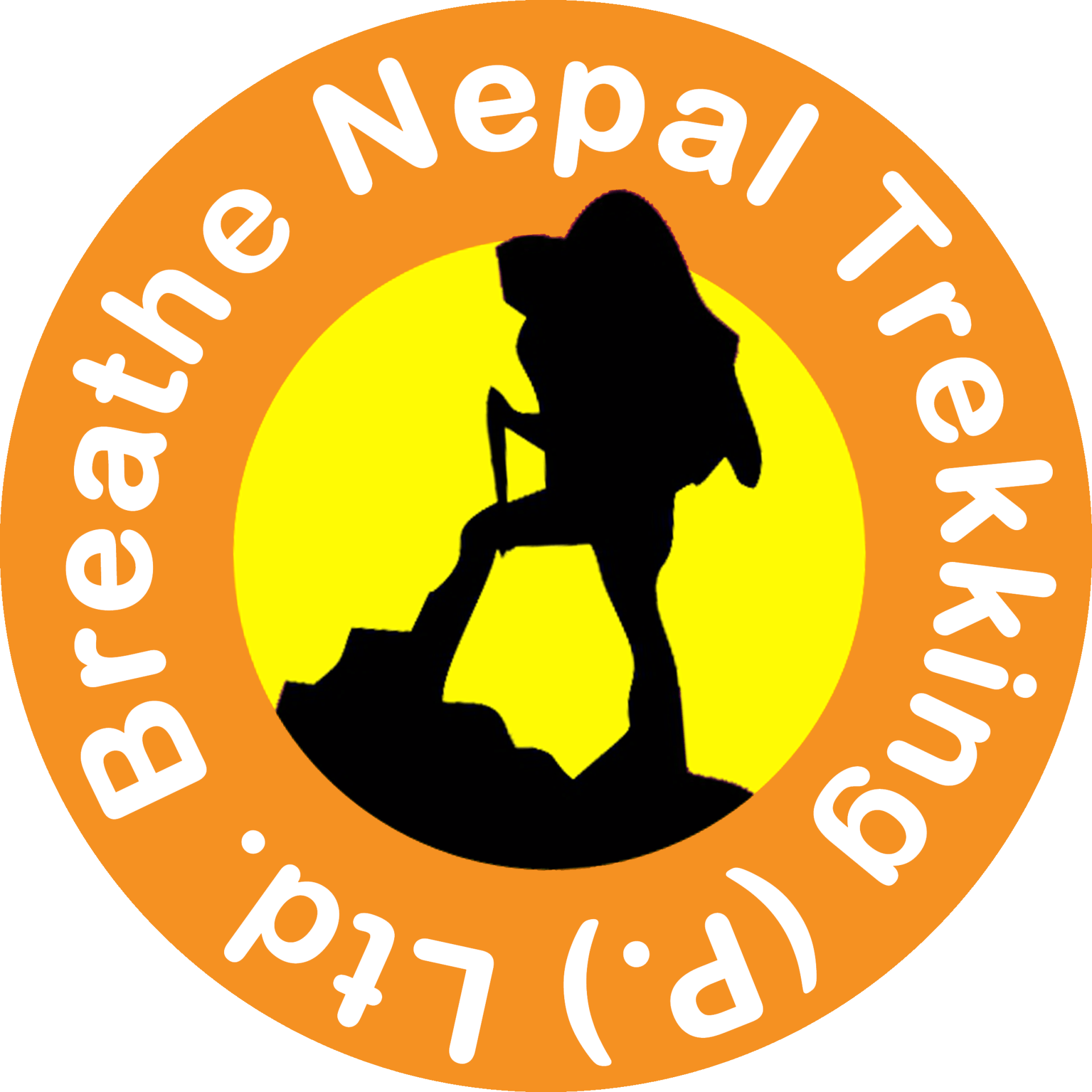
Guide To Annapurna Trekking Weather
Jan 23, 2023
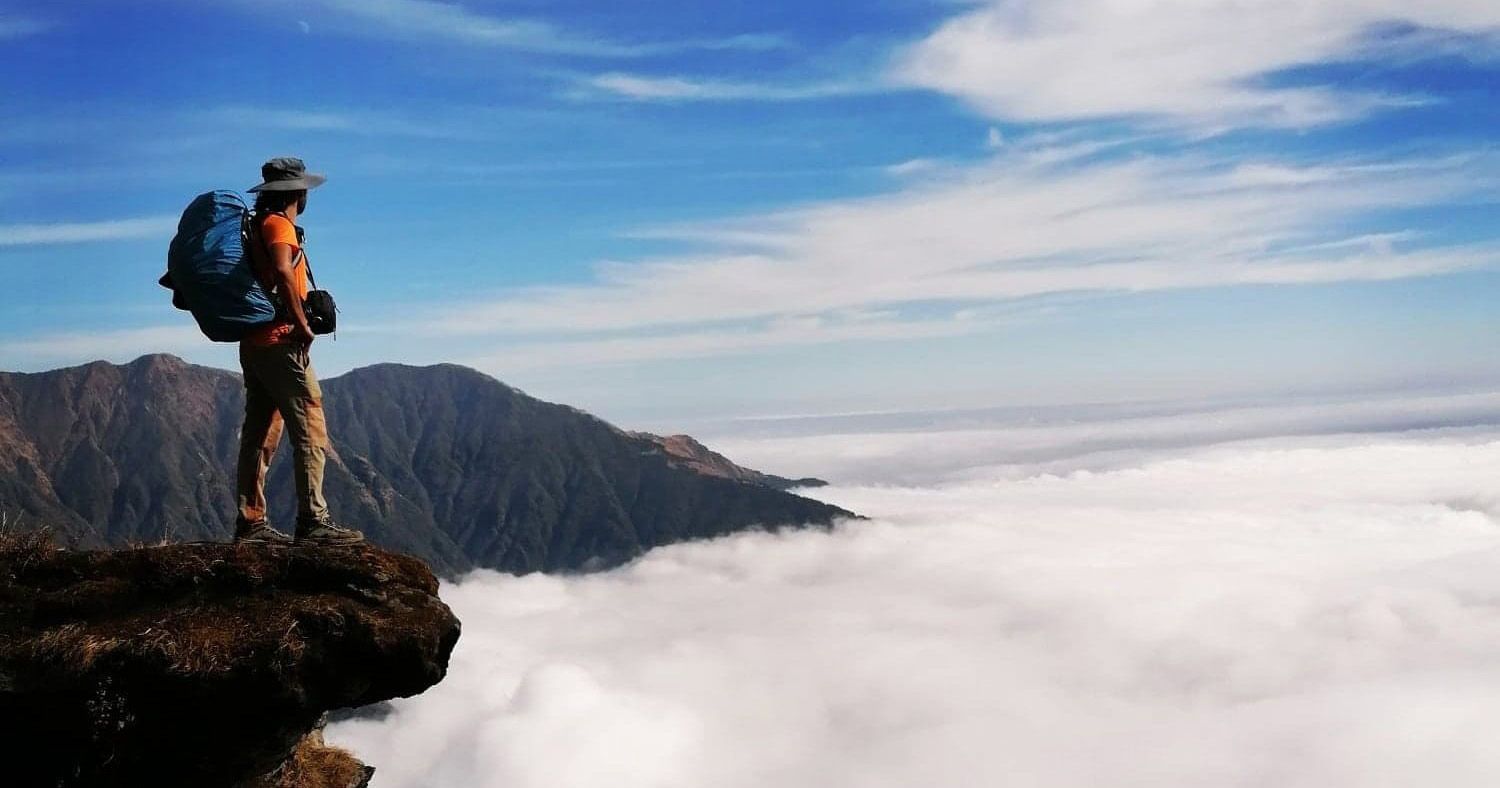
What to Expect and How to Plan Your Trek
Hey there! If you're planning a trek in the Annapurna region, you'll want to pay attention to the weather, as it can vary depending on the season and altitude. Here's a quick guide about what to expect and how to plan for the best trekking experience.
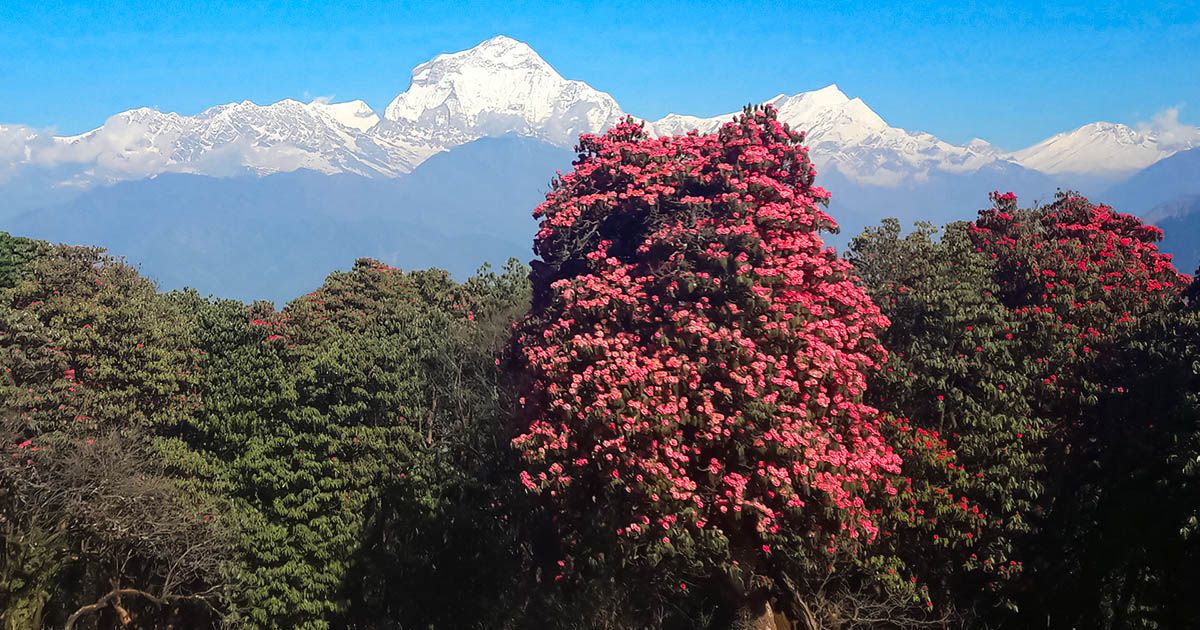
Spring (March to May) is ideal for trekking in the Annapurna region as the weather is warm and sunny. Lower elevations appear drier than in the trekking season (October to December), with less vegetation due to the winter. However, higher elevations boast a display of blooming rhododendron forests. This is an excellent opportunity to view wildflowers, exclusive to spring, and take in clear mountain views. However, dry weather in spring can increase the risk of forest fires, so it's crucial to exercise caution and avoid activities that could spark a fire.
Summer (June to August) is also a good time to visit. In the summer months, the monsoon rains bring a new level of lushness to the Annapurna region, making it an ideal time for trekkers who are interested in exploring the local flora and fauna. The scenery is green, vibrant, and the waterfalls along the trails are especially stunning. Due to high humidity, there is a possibility of encountering leeches in certain areas. It is advisable to take necessary precautions and wear leech-proof gear.
Autumn (September to November) is peak season for trekking in Annapurna region, with a revitalized landscape after the monsoon. The lower elevations are especially vibrant with new growth and fresh leaves, making it perfect for outdoor adventures and scenic hikes amid a colorful display of natural beauty. The warm weather and clear views make for ideal trekking conditions. Don't miss this stunning season where nature shines at its best!
Winter (December to February) is the chilliest season for trekking in Annapurna region, but it offers a stunning sight of the snowy mountains. The cold weather requires preparation with warm clothing, making it ideal for those who are up for a challenge and enjoy winter landscapes. With fewer crowds and clear skies, it's an opportunity to experience the serene beauty of the region in a unique way.
Regardless of the time of year, it is always recommended to hire a local guide when trekking in the Annapurna region. Local guides have extensive knowledge of the weather conditions and can advise on the best trekking routes and times based on current weather conditions. They also know the best places to take shelter or find alternate routes in case of inclement weather, and are trained to handle emergencies and unexpected situations.
Further on in this blog post you will find information about the seasonal weather conditions for the most popular trekking routes in the Annapurna region, as well as Pokhara, which is the starting point for most treks. So, take a moment to relax, breathe in, breathe out and enjoy our post. And, when you're ready, set off to discover the beauty of Nepal.
Best Time to Hike on Poon Hill Trail
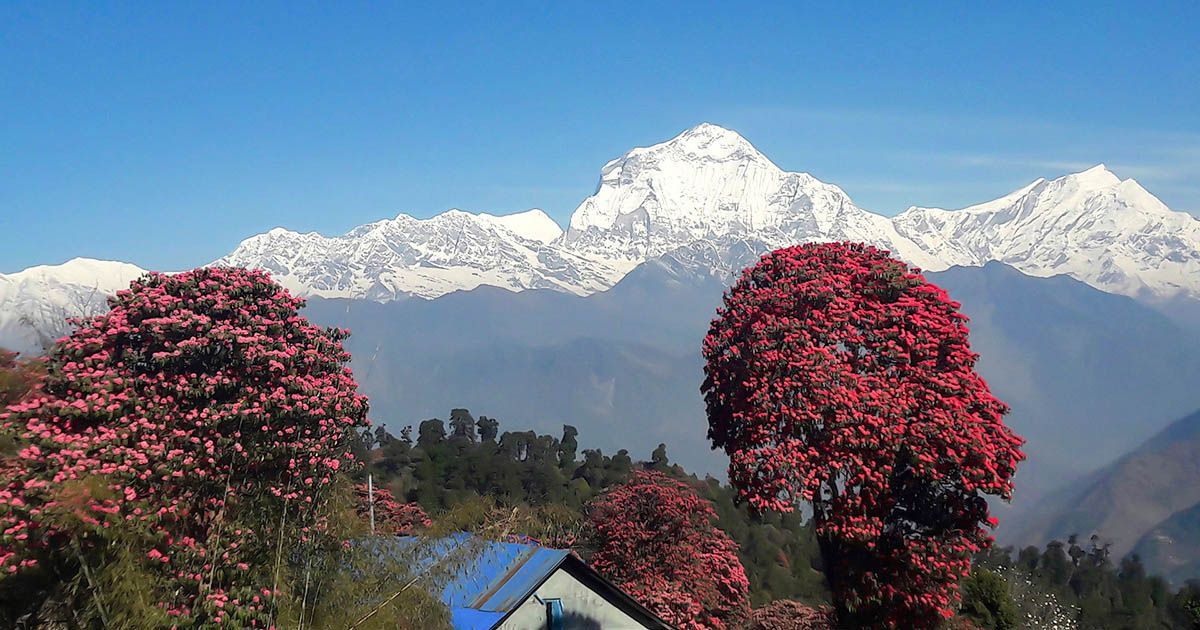
The Poon Hill Trek , a well-loved trek in Nepal, boasts breathtaking views of the Annapurna mountain range. It's relatively easy, taking 3 to 7 days to complete. Keep in mind that weather on the trek can change significantly depending on the season.
Trekking Seasons - Poon Hill
During the spring months (March-May), the temperature on the Poon Hill trek ranges from 5°C (41°F) to 20°C (68°F) during the day and can drop to -5°C (23°F) at night. The weather is typically clear and sunny during the day, making it the perfect time to see the beautiful wildflowers that bloom in the region. However, it can be chilly at night, so it is important to bring warm clothing.
During the summer months (June-August), the temperature on the Poon Hill trek ranges from 15°C (59°F) to 25°C (77°F) during the day and can drop to 5°C (41°F) at night. The monsoon season starts around June and the region experiences heavy rainfall, making the trek quite challenging. It is best to avoid trekking during the monsoon season.
Autumn (September-November) is the best time to trek on Poon Hill as the temperature ranges from 5°C (41°F) to 20°C (68°F) during the day and can drop to -5°C (23°F) at night. The weather is clear and dry, making it the perfect time to see the beautiful autumn foliage. This is the most popular time to trek on Poon Hill, so expect to see a lot of other trekkers on the trail.
During the winter months (December-February), the temperature on the Poon Hill trek ranges from -5°C (23°F) to 5°C (41°F) during the day and can drop to -10°C (14°F) at night. The weather is typically cold and snowy, making it a challenging time to trek. Only trekkers with a local guide should attempt the trek during the winter months.
Regardless of the season, it's always important to be prepared for changing weather conditions and to pack accordingly. You can check here the weather forecast for Poon Hill.
From Spring to Winter on Annapurna Base Camp Trek
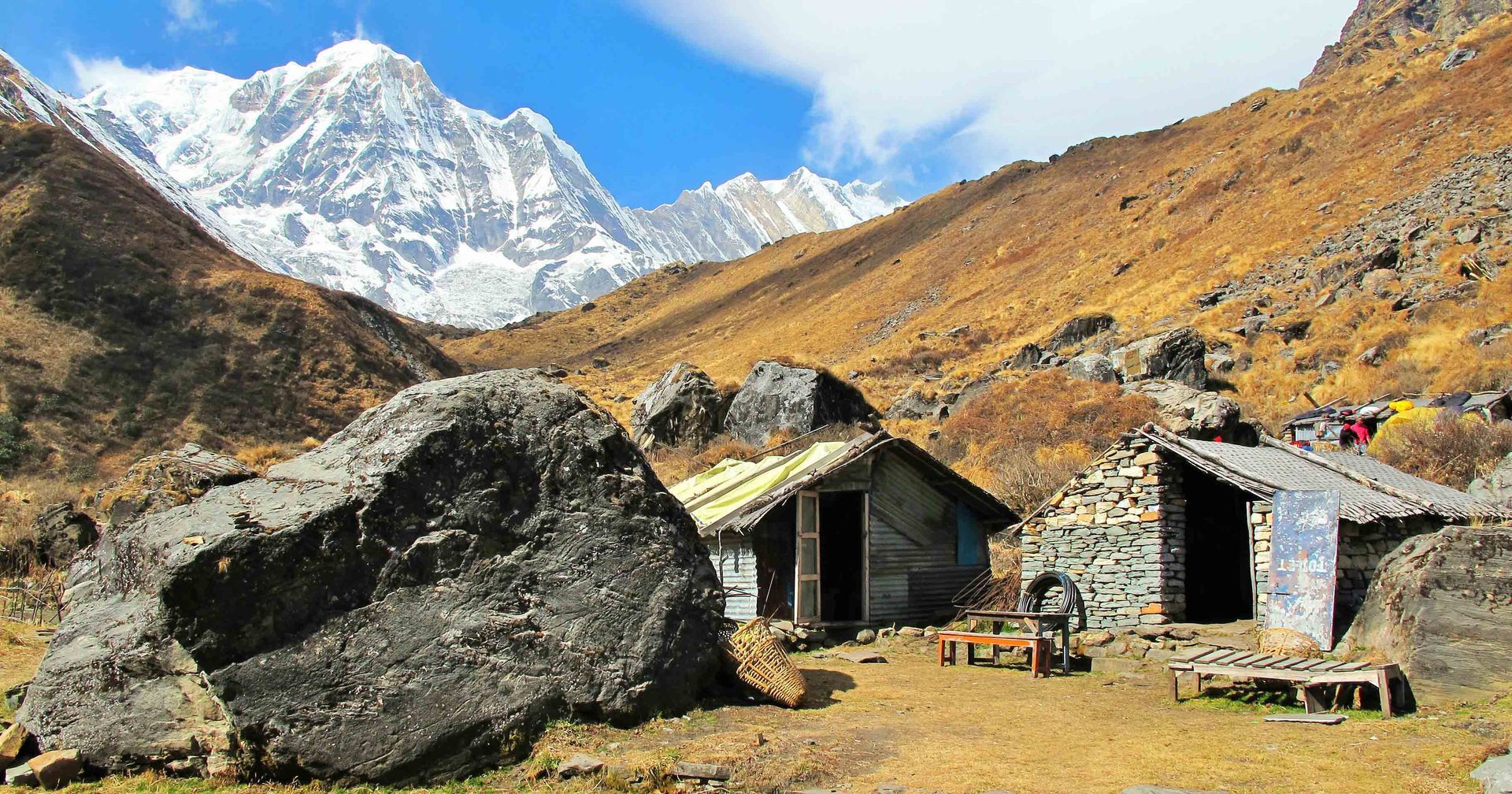
The Annapurna Base Camp Trek , a sought-after trek in Nepal's Himalayas, leads trekkers to the foot of the Annapurna massif. Usually done from September to May, the best weather is experienced from October to November and March to April. The trek can take anywhere from 7 to 12 days to complete.
Trekking Seasons - Annapurna Base Camp
During the autumn months (September-November), the weather is generally clear and sunny, with cool temperatures in the mornings and evenings and warm temperatures during the day. Average temperatures during this time range from around 5-15 °C (41-59°F) at lower elevations to -5 to 5°C (23-41°F) at higher elevations.
In winter (December-February), the weather is colder and snowfall is common at higher elevations. Average temperatures during this time range from -10 to 5°C (14-41°F) at lower elevations and -20 to -10°C (-4 to 14°F) at higher elevations. It is important to note that trekking in these months can be challenging due to the cold temperatures and snow-covered trails.
In spring (March-May), the weather starts to warm up again and the snow begins to melt, making for good trekking conditions. Average temperatures during this time range from 5-15°C (41-59°F) at lower elevations and -5 to 5°C (23-41°F) at higher elevations.
Summer (June to August) is generally warm during the day, with temperatures ranging from 10-20°C (50-68°F). At night, temperatures can drop to below freezing, with temperatures ranging from -10 to -5°C (14-23°F). It can be quite windy and cold at the base camp, so warm clothing is necessary. During this time, the region experiences heavy rainfall, which can make the trail muddy and slippery and can also cause landslides and flash floods. Trekkers should be prepared for these conditions by bringing proper rain gear and being mindful of the weather forecast before starting the trek.
It is important to note that the weather on the Annapurna Base Camp Trek can be unpredictable and can change quickly, so it is important to be prepared for all conditions and to check the forecast before embarking on the trek.
Four Seasons on Mardi Himal Trek
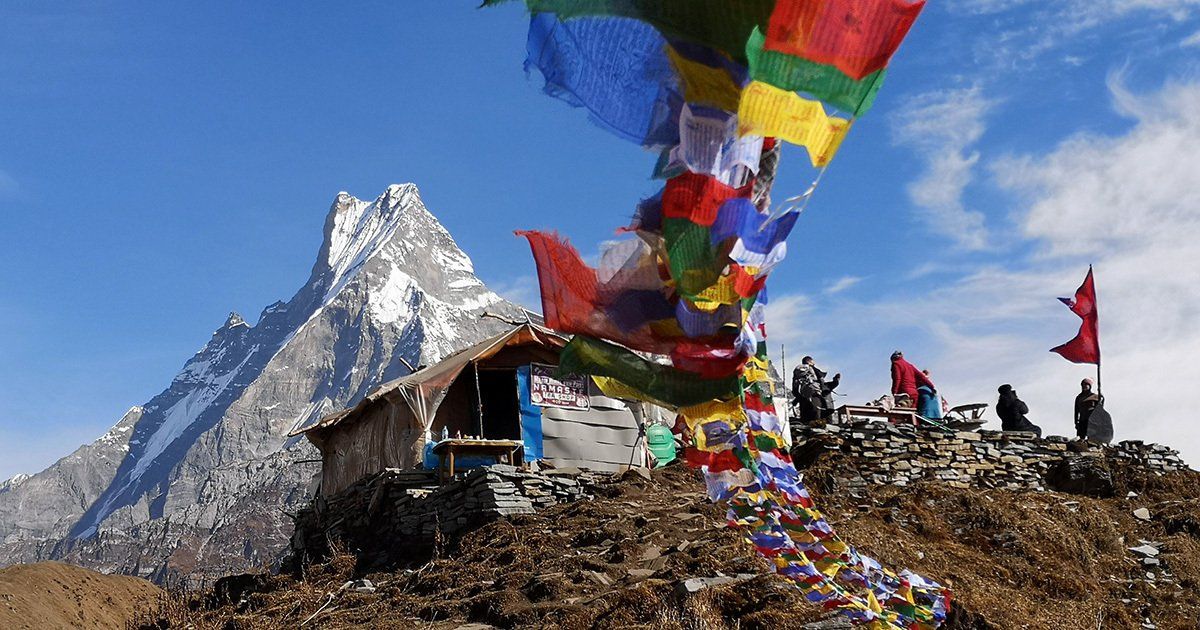
The Mardi Himal Trek is a popular trek in the western region of Nepal.The trek offers a unique experience with breathtaking views of the Himalayas and a chance to experience the diverse weather conditions of the region. The trek can be done in different seasons, each with its own unique characteristics. It takes 5-8 days to complete the trek.
Trekking Seasons - Mardi Himal
Spring (March to May) is a great time to trek as the weather is mild and the mountain views are clear. The daytime temperature can reach up to 20°C (68°F) and can drop to as low as 5°C (41°F) at night. The rhododendron forests are in full bloom and the trek offers a beautiful display of wildflowers.
Summer (June to August) is the monsoon season in Nepal, and the Madri Himal trek is not typically done during this time as the trails can be muddy and the views are often obscured by clouds. The daytime temperature can reach up to 25°C (77°F ) and can drop to as low as 15°C (59°F) at night.
Autumn (September to November) is considered the best time to trek as the weather is mild, the mountain views are clear, and the colorful rhododendron forests are in bloom. The daytime temperature can reach up to 20°C (68°F) and can drop to as low as 5°C (41°F) at night. The trek offers a unique experience with a chance to see the changing leaves and vibrant colors of the fall season.
Winter (December to February) is the coldest season, and the trek is not typically done during this time as the trails can be icy and the views are often obscured by snow and clouds. The daytime temperature can reach up to 5°C (41°F) and can drop to as low as -10°C (14°F) at night.
Overall, the Mardi Himal Trek offers a unique experience with breathtaking views of the Himalayas and a chance to experience the diverse weather conditions of the region. The trek can be done in different seasons, each with its own unique characteristics. It is important to be prepared for changing weather conditions and to bring appropriate clothing and gear. Please check here the weather forecast for Mardi Himal Trek.
Journey Through the Seasons on Annapurna Circuit Trek
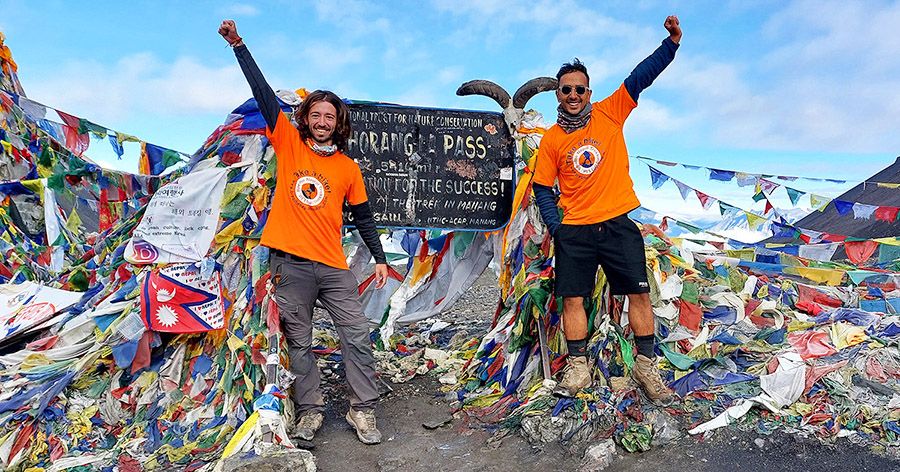
The Annapurna Circuit Trek in Nepal is a highly favored trekking route, showcasing awe-inspiring vistas of the Annapurna mountain range. The duration of the trek ranges from 10 to 21 days, depending on the chosen itinerary, and passes through a variety of landscapes, from lush subtropical forests to arid alpine deserts.
Trekking Seasons - Annapurna Circuit
During the trekking season, which runs from September to November and March to May, the weather is generally mild. Daytime temperatures can range from 15 to 25°C (59 to 77°F) in the lower elevations and can drop to below freezing at night. Higher up on the trek, temperatures can drop to below -10°C (14°F) at night.
In the monsoon season, which runs from June to August, the weather is typically wet and the trails can be muddy and slippery. During this time, the temperature can range from 20 to 30°C (68 to 86°F) in the lower elevations. The higher up on the trek, the colder it will get, and temperatures can drop to below freezing at night.
The winter months, December to February, are the coldest and the least popular time to trek the Annapurna Circuit. During this time, temperatures can drop well below freezing at night, reaching as low as -20°C (-4°F) or lower at higher elevations. Snow and ice can also make the trail treacherous, making it more challenging to trek. Additionally, the trail may be closed or have limited access during the winter season due to snow and ice. The mountain passes can be impassable, and the risk of avalanches and landslides is higher.
It's important to note that the weather can change quickly and unexpectedly on the Annapurna Circuit Trek so it's essential to come prepared with appropriate clothing and gear. Be sure to pack warm layers, a waterproof jacket, and good-quality trekking boots. It's also a good idea to bring a hat, gloves, and sunglasses to protect yourself from the sun and wind.
Check here the weather forecast for Manang and Thorong La Pass.
Weather Patterns on Australian Camp Trek
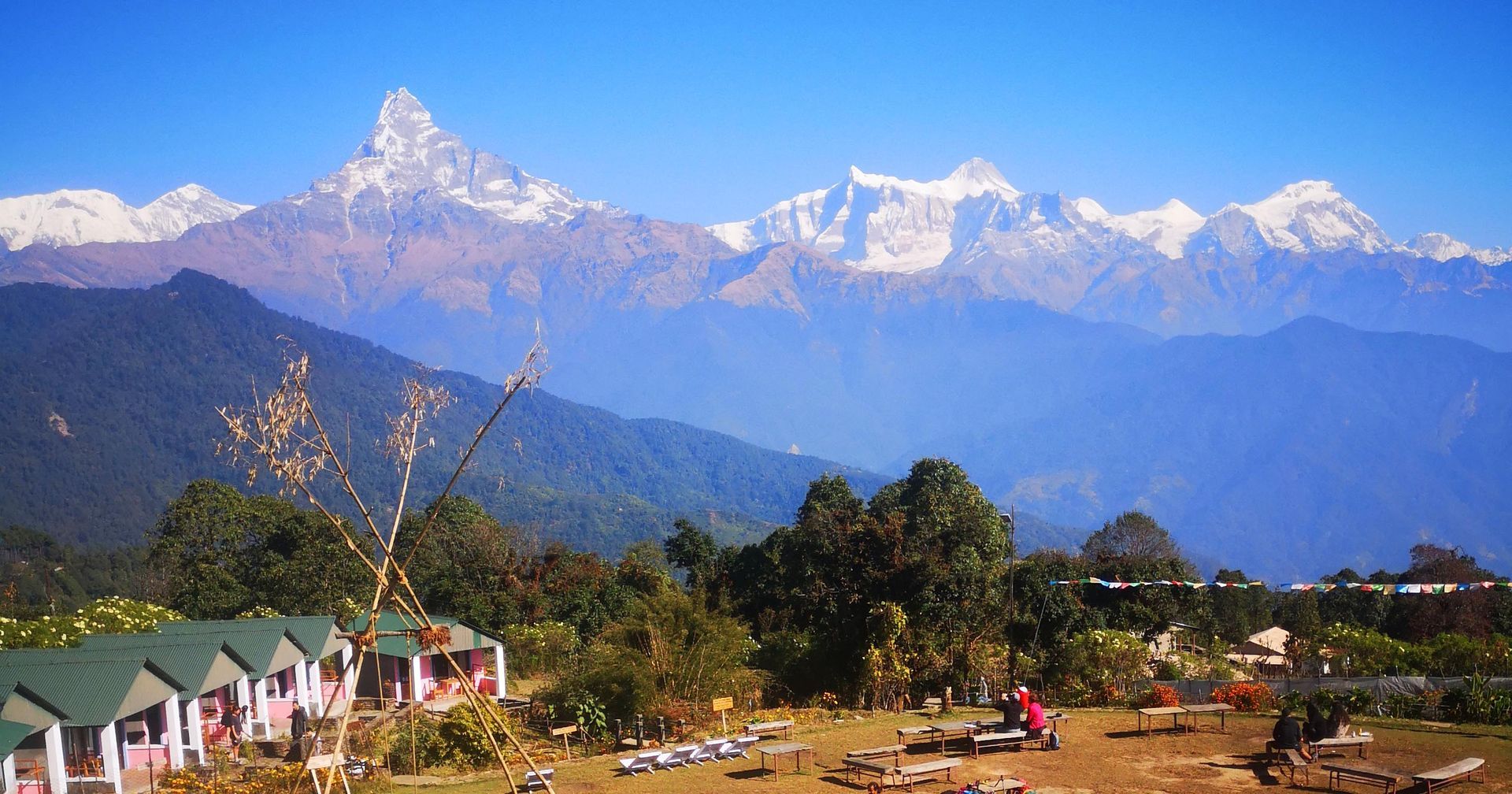
The Australian Camp Trek is known for its diverse and varied weather conditions throughout the year. The trek is a popular activity for adventure seekers and nature lovers alike, offering stunning views of the surrounding landscape and a chance to immerse oneself in the great outdoors. The trek can be completed in 1-3 days.
Trekking Seasons - Australian Camp & Dhampus
Summer (June-August) is the hottest season on the trek, with average temperatures ranging from 28-35°C (82-95°F). This season is characterized by high humidity and occasional thunderstorms.
The weather in autumn (September-November) is milder, with temperatures averaging between 20-25°C (68-77°F). This season is generally dry and comfortable for trekking.
Winter (December-February) is the coldest season on the trek, with temperatures ranging from 5-10°C (41-50°F). This season also sees the most rainfall, making it more challenging for trekking.
Spring (March-May) weather is similar to autumn, with temperatures averaging between 20-25°C (68-77°F). This season is characterized by clear, sunny days and comfortable temperatures, making it a great time for trekking.
It's important to note that temperatures can vary depending on the altitude and location on the trek, so it's always best to check the forecast before embarking on the Australian Camp & Dhampus. Additionally, it's essential to come prepared with the right clothing and gear to ensure a safe and enjoyable trek.
Check here the weather conditions in Dhampus/Australian Camp.
Exploring the Seasons in Pokhara City
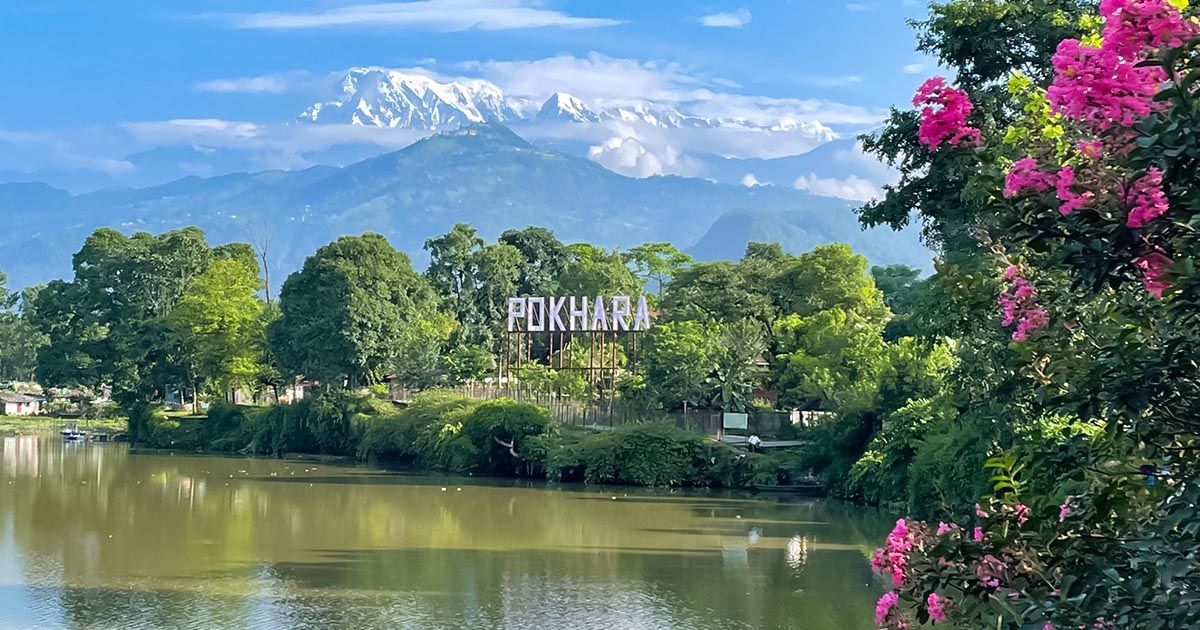
Pokhara is a city in Nepal that is known for its beautiful natural scenery and warm weather. The city is located in the foothills of the Himalayas, which means that the weather can vary greatly depending on the time of year.
Trekking Seasons - Pokhara
In the winter months (December-February), the temperature in Pokhara is quite cool, with average highs of around 15°C (59°F) and lows of around 5°C (41°F). During this time, it is not uncommon for there to be frost and even some light snowfall in the higher elevations surrounding the city. However, the city itself typically does not receive much snowfall.
In the spring (March-May), the temperature begins to warm up, with average highs of around 20°C (68°F) and lows of around 10°C (50°F). This is also the time of year when the city begins to see some rainfall, as the monsoon season is just around the corner.
The monsoon season in Pokhara typically runs from June to September, and during this time the city experiences heavy rainfall and high humidity. Average temperatures during this time are around 25°C (77°F) during the day and around 20°C (68°F) at night. Heavy rainfall can cause some flooding and landslides in the surrounding areas, so it is important to be prepared if you are planning to visit Pokhara during this time.
In autumn (October-November), the weather begins to dry out and cool down once again, with average temperatures similar to those in the spring. This is considered to be the best time to visit Pokhara, as the weather is pleasant and the scenery is beautiful.
Overall, the weather in Pokhara can be quite unpredictable, and it is important to be prepared for a range of conditions depending on the time of year. However, despite the variability, Pokhara is a beautiful and welcoming city that is well worth a visit.
Access the weather forecast for Pokhara here .
Best Treks from Pokhara
Contact info, +977 9856039350, [email protected], breathe nepal trekking, 6, pokhara nepal, useful links.
No recent searches!

- Certificate of Excellence 2023
Bookings are now available for Nepal Treks in the 20 24/25 season Book Now
- Everest Trekking
- Annapurna Trekking
- Langtang Trekking
- Manaslu Trekking
- Dolpo Trekking
- New Trekking Trails
- Mustang Trekking
- Makalu Reigon
- Chitwan Pokhara Tour - 7 days
- Kathmandu Nagarkot Chitwan Tour - 6 days
- Home Stay Tour | 7 Days - 7 days
- Bandipur Village Tour - 3 days
- Nepal Exclusive Holiday Trip - 12 days
- Lumbini Tour - 5 days
- Nepal Adventure Tours - 10 days
- Kathmandu Pokhara Tour - 6 days
- Kathmandu Pokhara Nagarkot Luxury Tour - 4 days
- Nepal Buddhist Culture Tour - 8 days
- Pisang Peak Climbing - 11 days
- Mera Peak Climbing - 15 days
- Yala Peak Climbing - 10 days
- Lobuche Peak Climbing - 13 days
- Island Peak Climbing with EBC Trek - 16 days
- Bardia Jungle Safari - 3 days
- Nepal Safari Tour - 3 days
- Chitwan Jungle Safari - 5 days
- Kali Gandaki River Rafting - 3 days
- Seti River Rafting - 2 days
- Bhotekhosi River Rafting - 2 days
- Trishuli River Rafting - 2 days
- Bungee Jumping - 1 days
- Canyoning - 1 days
- Mountain Everest Scenic Flight - 1 days
- Paragliding in Nepal - 1 days
- 1 Day Kathmandu Adventure Paragliding - 1 days
- Around Kathmandu Valley Mountain Bike Tour - 7 days
- Annapurna Himalayan Helicopter Tour - 1 days
- Mt Everest Helicopter Tour - 1 days
- Muktinath Temple Helicopter Tour - 1 days
- Langtang Helicopter Tour - 1 days
- Nagarkot Dhulikhel Hiking - 3 days
- Chisapani Nagarkot Hiking - 3 days
- Balthali Village Hiking - 3 days
- Dhampus Sarangkot Hiking - 3 days
- 1 Day Nagarjun Hiking - 1 days
- 1 Day Kathmandu Cycling Tour - 7 hrs
- 1 Day Rafting in Trishuli - 1 days
- 1 Day Kathmandu City Sightseeing - 1 days
- 1 Day Namobuddha Hiking - 1 days
- 1 Day Sunrise Tour - 1 days
- 1 Day Wildlife safari Tour - 1 days
- 1 Day Pokhara City Tour - 1 days
- Lhasa City Tour
- Kathmandu Lhasa Everest Base Camp Tour
- 12 Days Tibet and Nepal Tour
- Bhutan and Nepal Discover Tour
- Glimpse of Bhutan Tour
- Three High Passes Trekking - 17 days
- Everest Panorama Trekking - 9 days
- Budget Everest Base Camp Trekking - 11 days
- Everest Base Camp Trekking - 14 days
- Gokyo Lakes Trekking - 14 days
- Classic Everest Base Camp Trekking - 22 days
- Tilicho and Mesokanto La Trekking - 15 days
- Annapurna Base Camp Via Poon Hill Trekking - 12 days
- Ghorepani Poonhill short trek - 3 days
- Ghorepani Poon Hill Trekking - 5 days
- Annapurna Circuit Trekking - 14 days
- Annapurna Base Camp Trekking - 7 days
- Mardi Himal Trek - 5 days
- Jomsom Muktinath Trekking - 13 days
- Khopra Danda Trek - 7 days
- Tamang Heritage Trekking - 11 days
- Langtang Gosaikunda Trekking - 14 days
- Langtang Valley Trekking - 9 days
- Tsum Valley Trekking - 16 days
- Manaslu via Rupina La - 16 days
- Manaslu Circuit Trekking - 13 days
- Lower Dolpo Trekking - 25 days
- Upper Dolpo Trekking - 25 days
- The Numbur Cheese Circuit Trek - 19 days
- Ganesh Himal and the Ruby Valley Trek - 14 days
- Indigenous People Trail - 11 days
- Upper Mustang Trekking - 16 days
- Makalu Base Camp Trek - 16 days
- Best Tour Seasons in Nepal
- Weather and Climate in Nepal
- Tourist Information
- Tour Entry Fees
- Nepal Travel Insurance
- People and language in Nepal
- History of Nepal
- Geography of Nepal
- Food and cuisines in Nepal
- Best Tourist Destination in Nepal
- Best Trekking Seasons in Nepal
- Celebration and Festivals in Nepal
- Foreign Embassies and Consulates
- Flora and Fauna in Nepal
- Culture and Customs in Nepal
- Aware of Illegal Travel
- Responsible Travel
- Terms and Conditions
- Why Travel With Good Vibe Adventure
- Legal Documents
- +977 9841783145
- [email protected]
- Thamel Marg, Kathmandu, Nepal
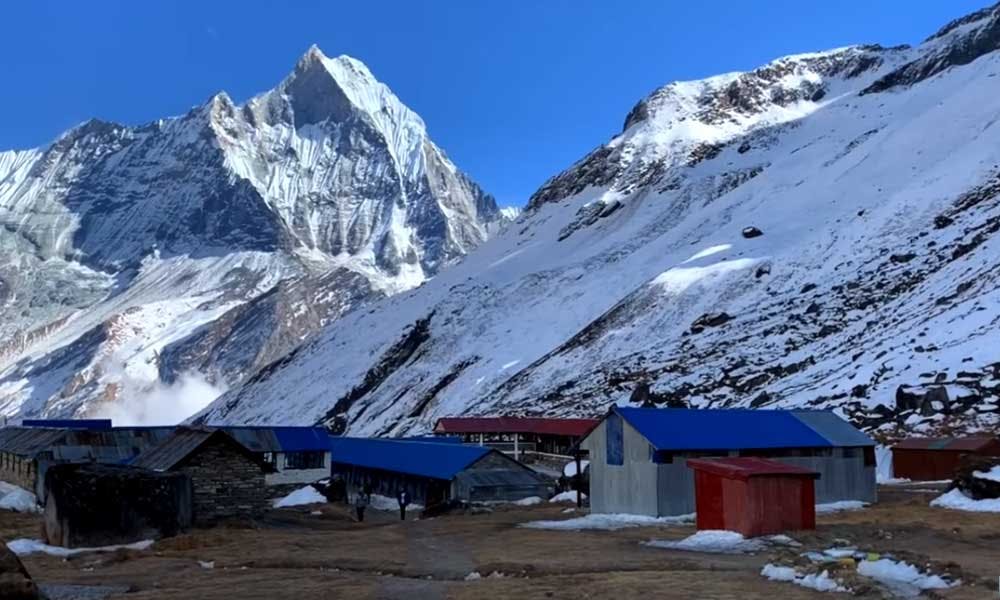
Annapurna Circuit Trek Weather
Annapurna Circuit Trek is an ideal trip for anyone who loves nature at its best. This circuit trek revolves around the beautiful landscapes of the Annapurna region . You will walk over and glance at nature's best creation, Annapurna region. Truly, this place seems very close to what we call, Yes Heaven! You’ll be trekking in Heaven.
This Annapurna Circuit revolves around some beautiful places like Jomsom, Muktinath, Manang. You’ll reach the highest point, Thorong La Pass(5,416m). The views of these places are breathtaking. The trails are through the beautiful land of the Annapurna region. Trails through many villages and rivers. Trails through green terrains and forests. You’ll surely enjoy this expedition.
But, deciding when to do Annapurna Circuit Trek is a tricky one. The entire circuit is very watchful and scenic, but not all year round. You have to pick the right time for Annapurna Circuit Trek . So, here is the full article related to Annapurna Circuit Trek Weather and Temperature. You’ll find your answer, just read this entire article.
Annapurna Circuit Trek Temperature and Weather in Different Season
Annapurna Circuit plays differently in each season of the year. The Annapurna Circuit Trek’s temperature in Autumn is contrary to the Winter season. Similarly, conditions in the Spring season are opposite to the conditions of the Summer season.
Touring the Annapurna circuit in the ideal season makes the trek more beautiful and easy-peasy. And, arrival in the off-season makes it too complicated. Hence, we have to look at the breakdown of Annapurna Circuit Trek in different seasons. After that, we can easily decide on when to do Annapurna Circuit Trek.
Annapurna Circuit Trek Weather and Temperature in Autumn Months
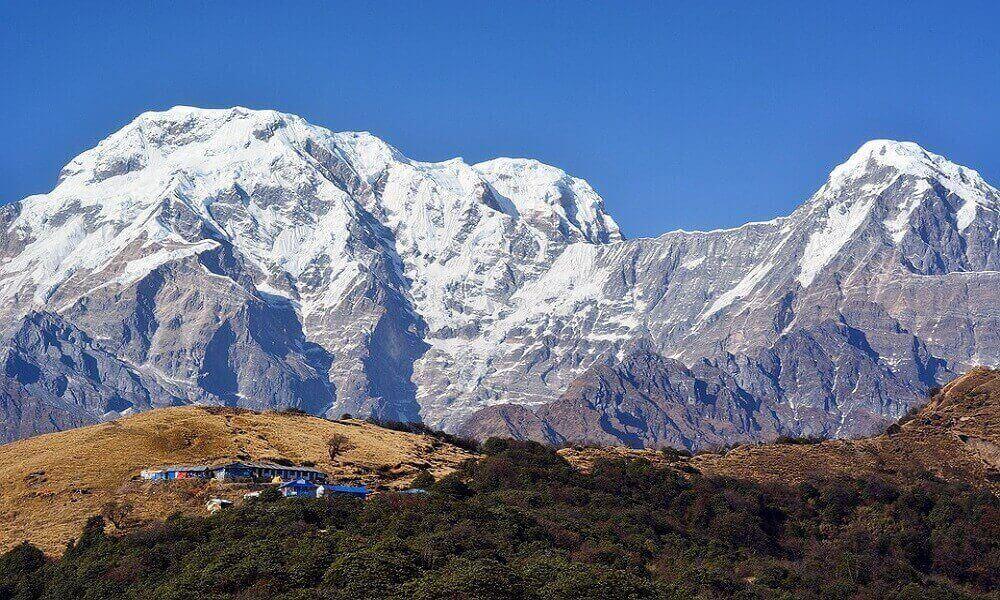
September is the first month of the Autumn season, the peak season. With the arrival of Autumn, the weather gets bright and clear day by day. But light rainfalls will shower during the first few weeks of September. And, then monsoon will be gone by mid-September.
It is from mid-month, the Autumn marks its arrival by making the nature crystal-clear. With the rain gone, the temperature starts to fall around 17°C to 4°C . Thorong La Pass (5416m) , the highest reach of the trek, has the daytime temperature near -4°C . Since it is the first month of Autumn, there can be some overcast disturbing mountain views.
However, the terrains are soaked by the monsoon rains and its greenery everywhere. You’ll enjoy the clean and clear landscape views. The weather starts to get better and better with the days. During late September, the skies are all clear, and days are sunny to walk on.
October is a perfect time for Annapurna Circuit Trek. The climate becomes more stable and precise, with no or low rainfalls. Beautiful mountain views all around the month, no clouds in front of the mountains. The trails are easy to walk on due to warm and sunny conditions.
The lower regions of the circuit are mostly warm, with the average day temperature of 15°C . The higher areas are much colder than the lower ones. It is freezing during the early mornings and night. Whereas, more upper regions are close to the freezing level during the days of October. And, the temperature during nights reaches 7°C to 8°C . The Thorong La Pass is, even colder than all of the other places of the circuit. So, it is suggested to include thick and warm clothes in the backpack.
Warm and sunny days of October calls the visitors from all parts of the world. And, they all hear and come to see the beautiful undisturbed views of Himalayas. So that's why the Annapurna flourished with many visitors during this month.
The Autumn season lasts until the end of November. November is also an excellent time to trek in Nepal. The weather and conditions of November are very identical to October. The bright blue skies and warm sun are still around the days of November. There are no signs of rainfall and snowfall, making it a trouble-free month.
This month sees the average day temperature of 15°C in the Annapurna Circuits. And, the night time temperature is around 7°C to 8°C . But, that is on average of places, the higher pass like Thorung La Pass (5,415m) remains freezing. It can go down to -5°C in areas around Thorung La Pass. There is a noticeable difference between the temperature during the daytime and during the night.
It’s all good till late November, after that the weather turns colder here. So, carrying warm thick thermal clothes is a must during this month.
Highlights of Annapurna Circuit Trek in Autumn
- Ideal Weather and Climate
- Undisturbed views of mountains and terrains
- The festive season in Nepal
- Greenery vegetation
- Best views of Annapurna Massifs
Major Tips for Annapurna Circuit Trek in Autumn
- Pre Book package, tickets, and accommodation
- Pick warm but light clothing
- Carry rain gears if coming in the early September
Are you thinking of doing Annapurna Circuit Trek in Autumn? We will make your trip possible. Please feel free to Contact Us .
Annapurna Circuit Trek Temperature and Weather in Winter Months
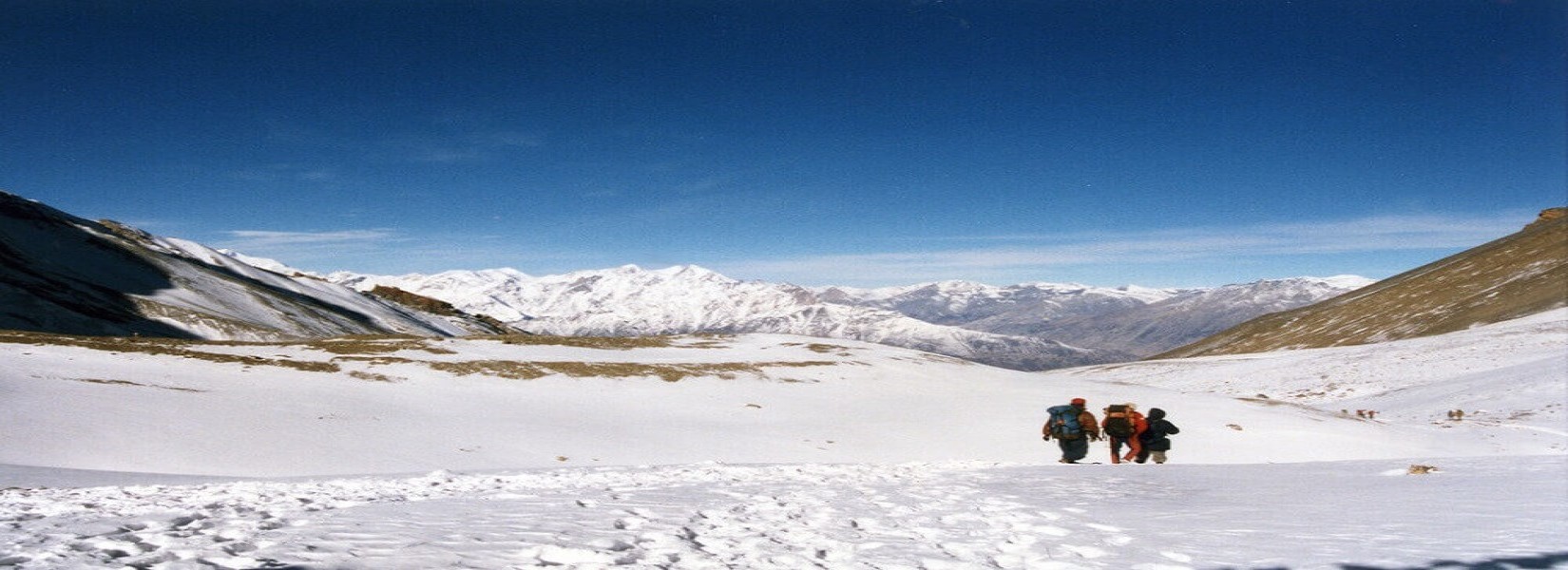
December is the first month of the Winter season. Winter is the coldest season in Annapurna Circuit. The mountains are all covered with the snow under the clear blue sky. Winter is the driest season of all, which means no or very little rainfall.
The average daytime Annapurna Circuit Trek temperature starts to drop, reaching around 10°C to 5°C . And the night temperature falls as low as to -5°C . The areas above 4000m are even colder during this month. The weather is bearable at the start of the month. And the weather starts to freeze during the last days of this month.
Due to cold weather, snowfall can occur at any time. The trails start becoming difficult due to snow. So, it is difficult to trek in this circuit during the Winter season. So, it is necessary to equip yourself with all the winter gear during this month’s visit.
January, the second month of Winter, is one of the coldest months of the entire year. In higher regions, the day time temperature is around 1°C to -10°C . The nights are even colder. Whereas, the lower Annapurna Circuit Trek temperature is between 7°C to 12°C .
Due to the cold conditions, the trails of Annapurna are less crowded. January is perfect for the peace lover, as they can enjoy the peaceful routes. And, it is effortless to find accommodations due to the off-season.
The days and mountain views are apparent during this month. It is a perfect time to watch the unobstructed view of the mountains. The days are shorter, and nights are longer. You can also watch the unobstructed views of billions of stars. To remind you that the higher Thorung La Pass is restricted to visit. So, you have to check the weather and conditions of the Annapurna Circuit.
The weather in higher regions is quite unpredictable. The higher areas are mostly below 1 °C . Mainly, morning and night time are too cold to stay out. Hence, the proper clothing is required for this trek in the months of winter.
This month is here to farewell the winter season and to welcome the spring season. So, this month provides a mixture of two seasons. The higher altitude sees some heavy snowfall in February. And there are higher chances of the clouds hiding the mountain views. The weather is still cold at the start of the month.
The Annapurna Circuit Trek temperature keeps moving around -1°C to -14°C , which is extremely cold. The higher regions are even colder than that. But the temperature starts to increase as February comes to an end, making this month diverse. Throughout winter the days are shorter and nights longer. If you are planning to visit during February, it’s better to come with warm clothing.
Highlights of Annapurna Circuit Trek in Winter
- Clear mountain views
- Less crowded trails
- View of snow-filled landscapes and mountains
- Heartwarming Sunrise
Major Tips for Annapurna Circuit Trek in Winter
- Pack warm and thick clothes
- Carry essential snow gears
- Check out the weather before embarking
- December is the best month of Winter to do the trek
Are you thinking of doing Annapurna Circuit Trek in Winter? We will make your trip safe and possible. Remember Us
Annapurna Circuit Trek Weather and Temperature in Spring Months

March, the first of the most friendly Spring season, is a relatively best month to visit Annapurna Circuit. It is a time of flowers and greenery. The hills and terrains are mostly filled with Rhododendron and oak trees. The winter slowly leaves the atmosphere by making the area warmer. With a moderate climate, there are little chances of snowfalls and rainfalls.
The average daytime temperature of the lower region is around 4°C to -8°C . Whereas, the heat can score up to 10°C during midday. The weather gets colder during the dusks and dawns, so you have to be warmly clothed. March’s weather is quite enjoyable with the views of snow-covered mountains and flower-covered forests.
Alluring Spring continues to spread a warm environment in April as well. It is another peak month to do Annapurna Circuit trek. With the bright sun out in the clouds, it’s straightforward to trek on the long trails of Annapurna Circuit. There are uninterrupted mountain views all the way around. So, the trails are packed with many trekkers.
During April, the average daytime temperature of higher regions is around 8°C to -4°C. Whereas, the lower areas are much warmer with a temperature of 20°C . The nights are still colder as usual. Hence, you have to carry warm clothes while traveling this month.
Being the last month of the Spring season, April provides warm weather to trek on. The normal temperature is around 14°C to 0°C in higher regions. And, the lower region temperature reaches 18°C to 20°C , which is an excellent temperature to walk on. By the way, this month is the hottest of all the other spring months. And the nights are a bit colder with an average temperature of 5°C .
The highest pass of this circuit, Thorung La Pass, is the coldest area during this month as well. There can be some clouds around the mountains to obstruct the views. And, few rainfalls are expected at the end of May. So, having waterproof jackets, boots, pants while trekking this month is better.
Highlights of Annapurna Circuit Trek in Spring
- Warm and moderate temperature
- Undisturbed views of peaks
- Scenic views of the Himalayan ranges
- Witnessing wild and green vegetation
- Season of the flowers
Major Tips for Annapurna Circuit Trek in Spring
- Pre-book Flights, Package, and accommodations
- Pack warm and light clothes
- Carry rain gears as well
Are you thinking of doing Annapurna Circuit Trek in Spring? We will make your trip safe and enjoyable. Remember Us, Good Vibe Adventure .
Annapurna Circuit Trek Weather and Temperature in Monsoon Months
This is the start of the Summer season, known as Monsoon or Rainy Season. The lower area temperature in the Monsoon season is around 16°C to 30°C . Whereas, the higher region temperature stays around -3°C to -4°C . It is the season of heavy rainfall; the trails are slippery and muddy. However, higher parts like Upper Mustang and Manang are still intact by the rains.
The climate of the Spring season is very uncertain as the rainfall can occur anytime and any long. So, this time period is not considered by the trekkers to trek in any of the treks.
But also, some adventurous trekkers come here this month for a visit. They come here fully equipped with the rain gears.
July is the highest rainfall receiving month of the year. Due to the rain, the area is a bit colder than last month, with a temperature of around 18°C to 6°C . The mean warmth is around 12°C . Because of Bay of Bengal’s wind, there is continuous rainfall during the July and Monsoon months. And rain brings clouds around and blocks the mountain views. So, there is no guarantee of mountain views during this month.
During Monsoon, the trails of the lower areas are filled with leeches and mosquitoes around the bush areas. The days are mostly rainy and wet, so the trekkers are suggested to wear waterproof jackets, Waterproof pants , and boots. It's not necessary to wear a lot of warm clothes, a couple of warm outfits can work for morning and night temperature.
The days of August are the last 30 days of the Monsoon season. The clouds continue showering the rain on the ground, making the area cold and wet. The average temperature stays similar to the last month of July. Temperature also starts to increase, reaching around 19°C to 23 °C .
There can be some periodic landslides and erosion, blocking the trails. Routes are muddy and slippery, making it difficult to trek on. Throughout the month, rain clouds don't leave this area, so mountain views are not sure to appear. Trekking in the rainy season is a challenging one, but with better precautions and preparation, it is secure. Hence, it is essential to pack on the right rain gear before trekking this month.
Highlights of Annapurna Circuit Trek in Monsoon
- Undisturbed mountain views
Major Tips for Annapurna Circuit Trek in Monsoon
- Pack appropriate Rain gears
- Use Anti-mosquito cream
- Watch out for leeches and other rainy insects
Are you thinking of doing Annapurna Circuit Trek in Monsoon? We will make your trip possible and safe. Remember Us, Good Vibe Adventure .
Similar articles you may like:
- Trekking in the Annapurna Region
- Top 15 Most Asked Questions About Trekking in Nepal
To Conclude
In a nutshell, Autumn and Spring Season are the best time to do this Annapurna Circuit Trek or any other treks in Nepal. The Annapurna Circuit trek Weather is perfect during this season. It doesn't mean that the other two seasons i.e., Winter and Monsoon, are not possible.
Those are possible times but a bit difficult. If you are a qualified trekker, then the Winter and Monsoon season are ideal times to touch down the thrill. But, before setting out, you should overlook all the things about Annapurna Circuit Trek Temperature and Weather. We hope this article helped you somehow.
If you have any further queries about Annapurna Circuit Trek or any other Treks, We are always here to hear your voice, Good Vibe Adventure.
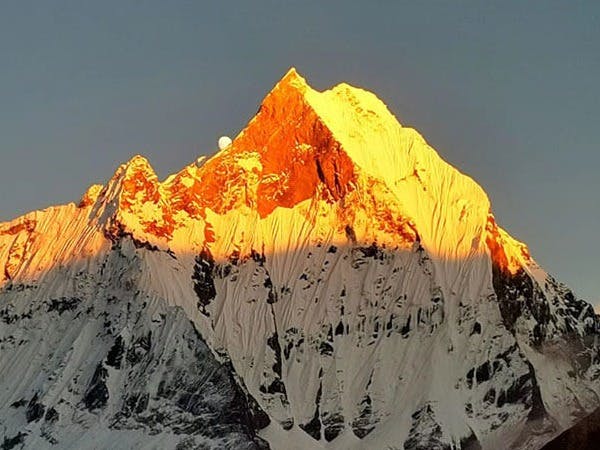
Send Inquiry


10 things I wish I knew before hiking the Annapurna Circuit
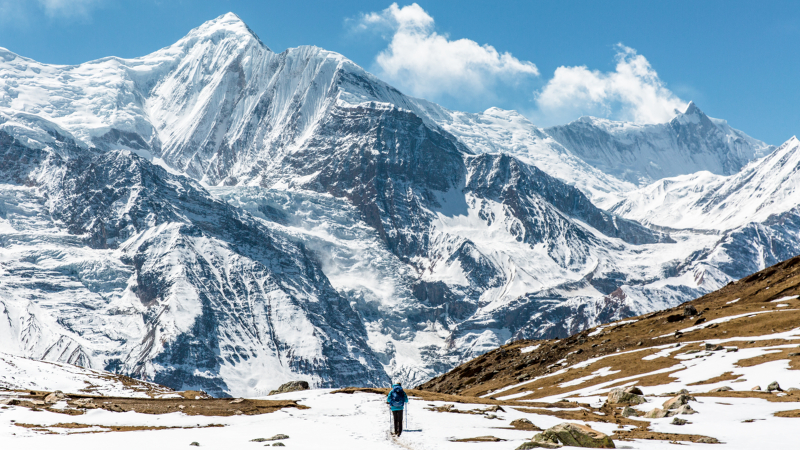
It’s one of the world’s classic long-distance hiking trails, and still one of Nepal’s most popular treks.
The Annapurna Circuit , a 12 to 21-day route that begins in the lush green villages of the Himalayan foothills. Taking trekkers over the 5,416m Thorong La Pass and down to the Tibetan-influenced temples and communities of the Mustang Valley.
If you want to experience a little bit of everything Nepal has to offer, this is perhaps the best trek to set off on, but it’s certainly no easy feat. The circuit is very tough at times, and the high altitude and unpredictable weather of the Annapurna mountain range can make crossing the Thorong La Pass a dangerous task – particularly if you’re not prepared.
Thankfully, I’ve got your back! So, here are ten things you should really know in order to complete the amazing Annapurna Circuit safely and with a smile on your face.
Check out Intrepid's Annapurna treks
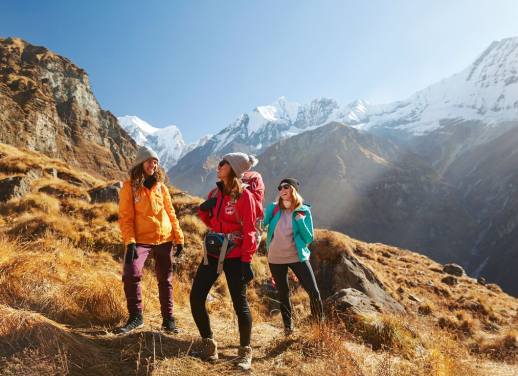
1. Plan the time of year right
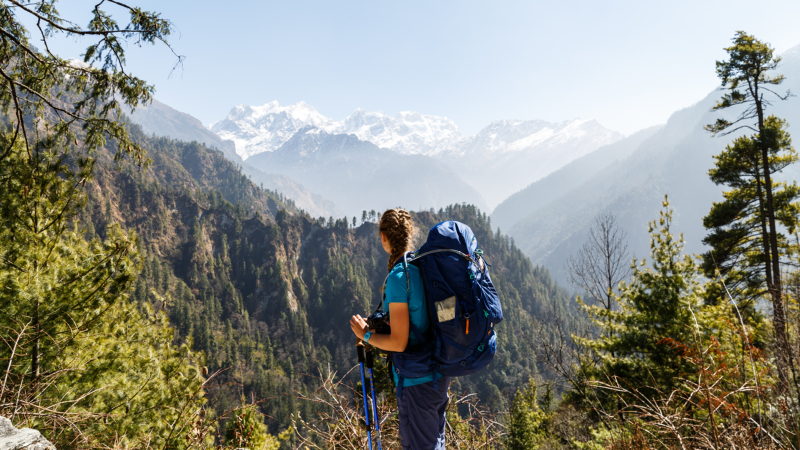
Photo captured by Annapurna Mellor
Like with many of the treks in Nepal, there are certain times of year when the weather conditions are ideal. For the Annapurna Circuit, October and November or April and May are widely considered to be the best times for trekking. The weather during these two seasons is generally clear and dry, and so it’s not too cold when heading into high altitudes. These two seasons are also the busiest times to be on the trail, with many other trekkers from across the world heading into the Himalayas.
You can also trek at other times of the year, but you will need to be a little more prepared for adverse weather conditions. The winter season, December to March, can also have clear skies and spectacular views. But it can be incredibly cold at higher altitudes, with thick snow on the ground that can often cause the Thorong La Pass to close at short notice. If you decide to trek during the winter season, make sure you have extra layers, a thick sleeping bag suited to temperatures of at least -20°C and crampons, which can be bought in Kathmandu and Pokhara.
GO NOW: EXPERIENCE THE BEAUTY OF THE ANNAPURNA CIRCUIT ON THIS 16-DAY ADVENTURE
2. Bring only what you need, leave the rest behind
When trekking on the Annapurna Circuit with Intrepid, Nepalese porters will carry 10kg of your gear. Anything extra will need to be carried on your own back, so packing as lightly as possible is essential. There are some things you need, such as a good quality sleeping bag, warm jackets, medicines, thermal layers and a head torch. But leave your jeans, laptop and makeup back in Kathmandu. You really don’t need them on the trail, and your back will thank you for it!
SUBSCRIBE TO OUR NEWSLETTER FOR THE LATEST TREKKING NEWS, OFFERS AND COMPETITIONS
3. The altitude should not be underestimated
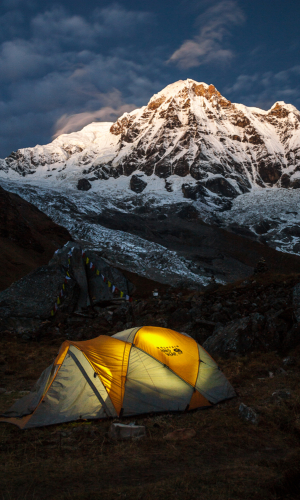
Altitude sickness can happen anytime above 2,500m. It doesn’t matter how fit you are, it can affect anyone and does so randomly. You can stay prepared by taking Diamox, an altitude medication, but aside from that just take it slow, drink lots of water and listen to your body. Before you set off on the trail, read up on the symptoms of altitude sickness so you’re aware of them if you start to feel the effects. Your guides will also be very knowledgeable about altitude and can be an essential source of help if you aren’t feeling well. The Annapurna Circuit reaches over 5,000m, that’s seriously high, and almost everyone will experience some mild symptoms like headaches or difficulty sleeping.
RELATED: ANNAPURNA OR EVEREST? YOUR DEFINITIVE TREKKING GUIDE
4. Be prepared for all weathers, whatever the time of year
While certain times of the year have much more suitable trekking weather (see point one), it is vital to be prepared for all possible conditions, no matter when you decide to go. High in the Himalayas, the weather is unpredictable, and snow, rain or storms can happen at any time. Climate change also means that weather patterns have become even more erratic over the last few years. Even if you’re trekking in October, be prepared for snow or storms on the trail. Pack enough warm clothing, make sure your boots are waterproof and don’t forget your sun cream or a sunhat.
GO NOW: DISCOVER THE HIGHLIGHTS OF THE ANNAPURNA CIRCUIT ON THIS 16-DAY ESCAPE
5. Eat well and look after your body
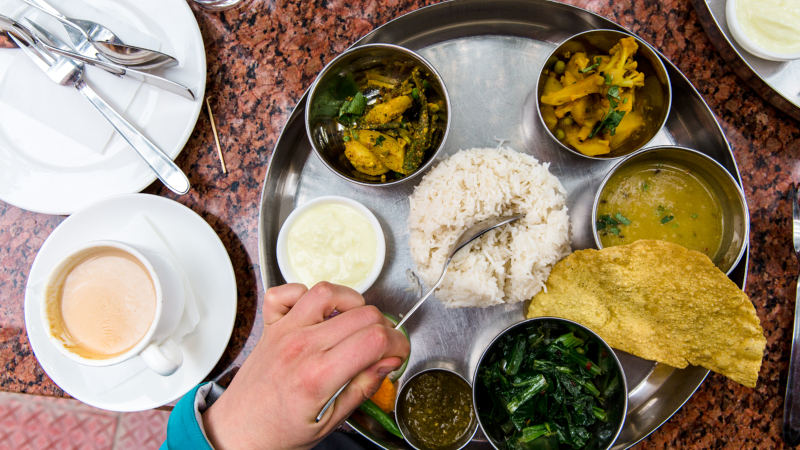
One of the best things about the Annapurna Circuit is the food and hospitality you will receive in the teahouses. Each evening, after a long day of trekking, you will be delighted to sit down in front of a roaring fire and tuck into a plate of dal bhat (a traditional Nepali meal of rice, lentils, vegetable curry and pickle). The food is delicious and very filling, and your body will be grateful for it the next day when you feel revived and ready to head out on the trail again. Other common offerings in guesthouses include garlic soup, a local remedy for altitude sickness and much better than it sounds. As well as, fried potatoes, spaghetti with local vegetables and of course apple pie – which is the Annapurna Circuit’s desert of choice due to the apple orchards growing in many of the villages along the trail. For snacking, I recommend stocking up in Kathmandu, as the cost of items like chocolate bars can get very high on the circuit.
RELATED: 8 NEPALI DISHES YOU HAVE TO TRY
6. It’s good to have a way to purify water
Plastic is a big problem on trekking routes across Nepal, as most of these small villages have no waste disposal system. This is leaving mountainsides cluttered with discarded plastic bottles, which is really not how we want to be treating these areas of striking natural beauty! You can’t drink the tap water in Nepal, and you really do need to be drinking a lot on the trail as you are walking long distances at high altitudes.
I recommend getting a steel reusable water bottle in Kathmandu. Along the trail, there are many villages with purified drinking water stations. Here you can refill your bottle and it actually works out much cheaper than buying bottled water. You can also use water purification tablets or buy a steripen. During the evenings, we would often order pots of hot water or tea and drink that, you can also fill up your bottle with any remaining in the pot and it’ll still be good to drink the next day.
TAKE ME THERE: EXPLORE OUR FULL RANGE OF ANNAPURNA CIRCUIT BREAKS
7. Learn some cultural respect
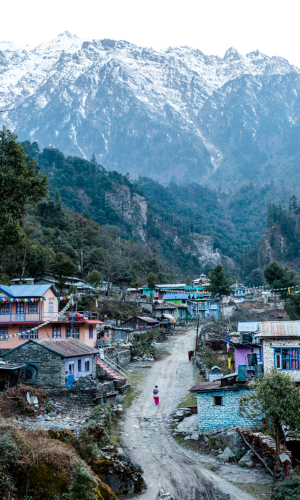
For many people, trekking in Nepal is about mountain views and hiking. But this is also a cultural trail, and it’s important to respect the people that call these villages their home. I recommend learning a little more about the cultures you are passing through. Speak to the families running the teahouses and go visit local gompas or temples. Opening your eyes to the cultures, religions and heritage of the trail will make it a much more enjoyable and meaningful experience, and it also means a lot to the local people when trekkers take an interest in their lives.
RELATED: MY INCREDIBLE MEETING WITH A HERMIT ON A NEPAL MOUNTAIN TREK
8. Don’t run out of cash
Once you leave Besisahar, there are no cash machines on the Annapurna Trail until you reach Jomsom after the Thorong La Pass. So, you need to be prepared and carry all the money you will need for the journey. While food and drinks in the teahouses can be cheap in the lowlands, they increase significantly as you increase in altitude and the road disappears. In Kathmandu, dal bhat is likely to cost you around 200 rupees, but this can grow to around 800 when you get above 3,500m. Western food such as burgers, pasta and burritos (yes, all food you can get on the trail), also tends to be very expensive as you get higher. I would recommend taking at least $20 per day for the trek, and if you’re a big eater or want to drink alcohol, $30-$40 per day is better.
GO NOW: TACKLE ANNAPURNA AND EVEREST ON THIS 31-DAY EPIC
9. Prepare yourself for the Thorong La Pass
Crossing the Thorong La Pass was probably the hardest day of my life! Waking up before sunrise and heading over narrow ridges in thick snow. Then climbing continuously for hours before finally reaching the prayer flags on the pass, breathless and completely relieved. Ok, maybe I’m not selling it so well. But it is essential to be prepared for this day, which will really push even the fittest hiker to the limits.
As long as you’re prepared, wearing enough warm clothes and have acclimatised enough to ensure your body comfortably makes the journey, then reaching the Thorong La Pass is going to be one of the most joyous moments of your trekking trip! Plus, once you’ve reached the top, you get to descend 1,600m to Muktinath, where the air is thick in oxygen and there are even hot showers to look forward to.
GO NOW: LIMITED ON TIME? OUR 5-DAY WALKING TOUR THROUGH THE ANNAPURNA RANGE
10. Be positive, take it slow and enjoy the journey!
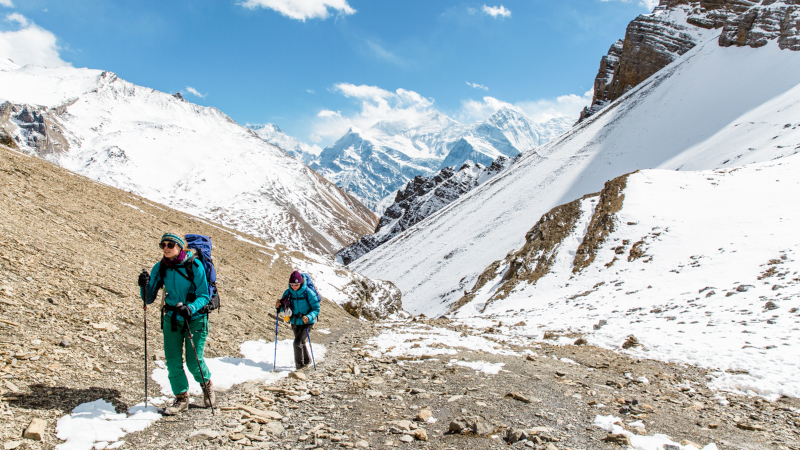
Travelling is meant to push you and challenge you in so many ways and trekking the Annapurna Circuit in Nepal will certainly do just that. While this is a difficult trek at times, it is also an incredibly enjoyable journey and one that can be completed by people of all ages and all fitness levels. The most important thing throughout the trek is to stay positive. Even when your body aches and you’re craving a hot shower, positivity will drive you on and it won’t be long before a breath-taking Himalayan panorama makes you remember why you’re here pushing yourself to the limit. It’s these incredible views, the wonderful hospitality of the local people and the company of your trekking buddies, which really make this a journey you will remember for the rest of your life!
RELATED: WHY CHALLENGING YOURSELF IS SUCH AN IMPORTANT PART OF TRAVELLING
Think you’re ready to take on the Annapurna Circuit? Take a look at our selection of trekking tours that’ll take you there . Already tackled it and looking for a new challenge? Check out our range of walking and trekking holidays from around the world.
Annapurna Mellor
Annapurna Mellor is a photographer, writer and storyteller. Her travels have taken her across Asia, Northern Africa, along the Trans-Siberian Railway and around Europe - always taking the road less travelled and always aiming to go a little deeper into the heart of local culture and people. Her photography work has been featured in National Geographic Traveller Magazine, Lonely Planet Guide Books and in campaigns for many travel brands around the world. Although she is usually dreaming about adventures afar, she is based, most of the time, in Manchester, England.
You might also like
Why train travel is the one experience you..., 5 places to escape the crowds in italy..., is australia safe everything you need to know, 10 fun facts you might not know about..., exploring the world through tea, 12 facts you probably don’t know about guatemala, the 7 best places to go on a..., 5 reasons to visit sri lanka in the..., why 2024 is the best year to see..., yellowstone vs yosemite: which national park to visit, 6 unique experiences you can have in el....
- You are here:
- Annapurna Region Guide
Annapurna Circuit Trek Weather and Temperature
- Dec 19, 2019
Table of Contents
The Annapurna Circuit trek is a fine trekking trail in the Annapurna region of Nepal. The circuit trek takes you through the splendid trekking trails around the gorgeous Annapurna massifs. The highest point on this trek is at Thorong La pass. The Thorong La pass is one of the difficult passes in the world.
The Annapurna circuit trekking is notable for its wide climatic changes, gorgeous Himalayas, diverse terrains, wild sceneries, rich traditions, and culture. The trek will also take you to the world’s deepest gorge, Kali Gandaki gorge. The view of gigantic Annapurna I and the Dhaulagiri Himalayas rising towards the east and west of the gorge is amazing.
This trek begins from the capital city of Nepal and takes you to the rugged trails of Himalayas. You can also visit the beautiful villages like the Manang, Ghorepani, Chame, Jomsom, and many others. At the villages, you can see different ethnic groups, cultures, and traditions.
The Annapurna region is rain shadowed region. Thus, this region receives less rain than the other trekking destinations in Nepal. The places on the trek aren’t all sheltered from the rain. However, the northern part of the trek receives less than 10% of monsoon rainfall.
While trekking from the lower regions, at Besisahar to the highest point at the Thorong La pass, this trek experiences a wide range of climatic variations. The temperature and weather differ drastically with the changing altitudes. Temperatures are greater at the lower regions and it increases with altitude gain.
The Annapurna Circuit Trek 14 days is notable for its climatic variations. Thorong La pass is a high altitude point where the weather and climatic conditions remain quite unstable. The Mustang region is a much drier semi-arid region. You can experience the various weather and temperature while walking from the beautiful subtropical meadows to the semi-arid lands, and to the snowy adventures at Thorong La pass.
Find more at Annapurna Region Guide
Do not hesitate to contact us , if you are planning your Annapurna Circuit Trek.
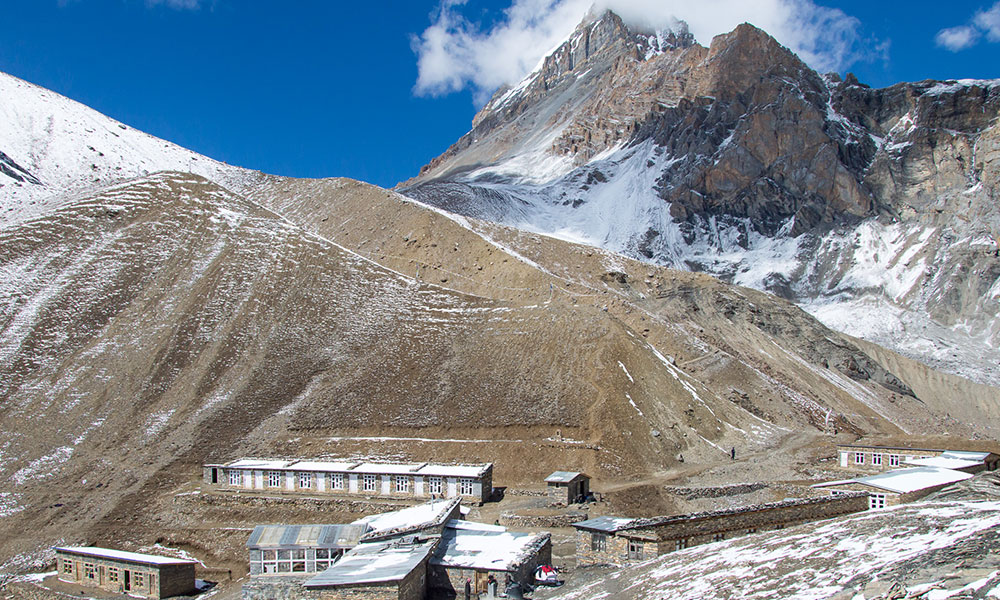
Seasons for Annapurna Circuit Trek
The Annapurna region experiences four different seasons. They are Autumn, Spring, Summer, and Winter. Annapurna circuit is beautiful trekking that is doable at any time of the year. Trekking in different seasons in Annapurna Circuit will provide you with variable experiences.
To trek in different seasons, you will require different trekking gears. The packing list for Annapurna Circuit trek is almost the same for Autumn and Spring. However, you might require lots of special equipment and gears for Annapurna Circuit trekking in winter and for Annapurna Circuit trek in Monsoon.
Annapurna Circuit Weather and Temperature in Autumn
Autumn ( September , October , and November) is a popular season for trekking in Nepal. In Autumn, the weather and temperature in the Annapurna region continue to be stable for months.
Autumn arrives as monsoon ends. Thus, the environment becomes clean and clear with the clouds of dust settled down and the dark clouds cleared. The monsoon rain leaves the forests and hills clean and green.
In the Autumn months, there will be lots of trekkers trekking in the Annapurna region. The flock of trekkers walks into popular trek routes like Annapurna Base Camp trek, Ghorepani Poon Hill trekking, and Annapurna Circuit and Tilicho lake trekking .
Weather and Temperature in September
September is a transition month between monsoon and autumn. The traces of monsoon rains still remain in early September. The rainfall isn’t as heavy as in monsoon. You might encounter only the short bursts of rain.
Monsoon ends completely during late September. Trekking to Annapurna Circuit in September has its own perk. You can enjoy the trekking experiences as in October and November without having to see crowded trails and teahouses.
The temperature at Thorong La pass averages around -4 degrees Celsius in September. The other regions of the trek are warmer. At altitudes between 2500 to 4000m, the temperature varies between 8 to 12 degrees Celsius. Below 2500m, you can experience 18 to 22 degrees Celsius temperature in days.
Weather and Temperature in October and November
The weather and temperature at Annapurna Circuit are quite similar in October and November. The weather is stable and clear with best views of the glistening Himalayas, valleys, hills, and mountains.
The lower region in the trek is warmer with daytime temperature averaging around 15 degrees. Nights are colder than the days. The nighttime temperature can drop to 7 or 8 degrees min.
The higher altitude regions above 4000 meters are colder. The nights and mornings are freezing here. Days are also colder than in the lower regions. of this trek have negative degrees temperature. You should be ready for freezing weather in these areas. Though colder, nights are clear with millions of stars twinkling in the sky. Carry some warm clothing to protect you from the cold. The weather at high altitudes like Thorong La pass can change drastically at any time of the year.
Due to the features like warm and bright days and least chances of rain or snowfall, October-November is the busiest time of the year in Annapurna circuit.
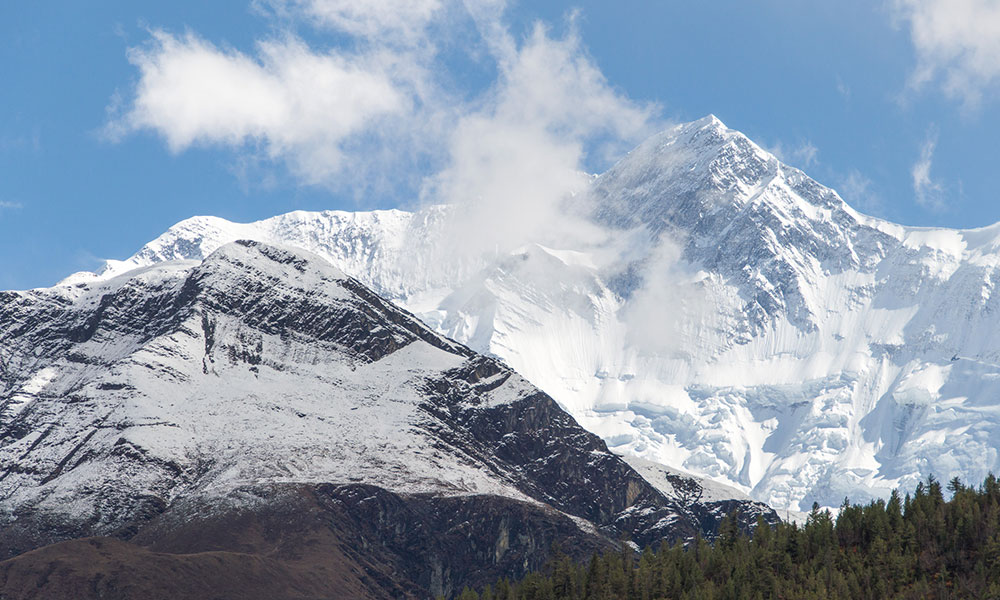
Annapurna Circuit Weather and Temperature in Spring
Spring (March to May ) is the time when the harsh and icy winter goes away welcoming warmer weather. Spring is the season of colors. The wildflowers including the Rhododendron are in full bloom in Spring. The snow over the trails at high altitude places will also melt.
The atmosphere becomes bright, warm, and clear with least chances of unstable weather. In the lower elevations, the temperature averages around 10 degrees Celsius. During early March, it’s quite chilly. But the days become warmer day by day. Nights are still colder than the days. Remember, you’ll need warm clothing for the nights.
At places above 4000 meters, the evenings and mornings are nearly freezing. Put on your warm clothes and go out to watch the beautiful sunrise and sunset views.
May is the hottest Spring month. By May, the temperature starts to rise. At lower areas, the average temperatures during days vary between 18 to 22 degrees Celsius. As usual, nights are colder than days with temperature averaging around 5 degrees Celsius.
The semi-arid lands of Mustang get uncomfortably hot during days. Drink plenty of water and wear summer clothes in layers.
Annapurna Circuit Weather and Temperature in Monsoon
Monsoon and Summer (June, July, and August) coincides in Nepal. In early June and late August, there won’t be as much rainfall as in July. July is the month when the Annapurna region gets lots of torrential downpours.
The northern regions in the Annapurna region include the rain shadowed areas. These reasons experience very little rainfalls. This makes some of the Annapurna treks like Upper Mustang Trek, Dolpo Trek, and Tsum Valley trek favorable for trekking in monsoon.
The parts of the trail that does not make the rain shadowed areas experience occasional heavy downpours. It rains almost every afternoon. The rain continues through the night and stops in the morning. The rainfall makes the trekking trail wet and slippery. Also, the summer bugs like mosquitoes and leeches will be highly active on the trekking trail. Wear hiking boots with sturdy soles and get some insect repellants.
The water bodies of the area come to life. The streams, rivulets that are dry in the other months are alive in these months. You can enjoy lush green vegetation, flora, and fauna of the area.
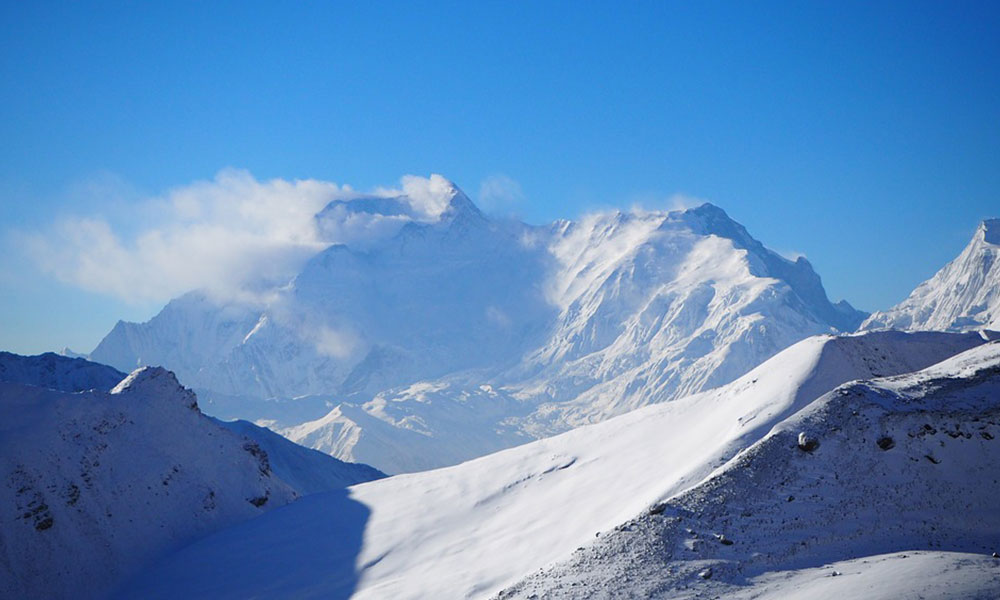
Annapurna Circuit Weather and Temperature in Winter
Winter (December, January, and February) are the winter months in the Annapurna region. Winter is the coldest time of the year. During this time, you will snow on the trails at the upper regions on the trek.
At Thorong La pass, there will be huge snowfalls in winter. Also, the weather will remain very unstable. At the top of the pass, the snowstorms might blow. Also, there can be avalanches too. In the middle of winter, the pass remains closed due to heavy snowfalls and bad weather conditions.
Before going to the trek in winter, you must check about the currently prevailing weather conditions in the region. To avoid the blocked passes, you can go to Annapurna Circuit Trek in early December.
In the lower regions of the trek, the temperatures at days vary between 7 to 12 degrees Celsius. The temperature decreases with a decrease in altitude. At the regions from 2000 to 4000 meters, daytime temperatures range between 2 to 8 degrees Celsius.
The higher altitudes like the Thorong La pass have temperatures below freezing point. The higher regions receive occasional snowfalls as well.
Nights in the higher altitudes are always colder. You will experience a vast difference in the temperature between days and nights at the Annapurna Circuit.
Annapurna Circuit Difficulties Due to Varying Weather
This trekking includes crossing the Thorung La pass, 5416 meters. The top of the pass is higher in altitude than the Everest Base Camp . It is a nerve-shaking pass if you attempt the climb the pass in difficult seasons.
The variable weather and temperatures during Annapurna Circuit trek can introduce various difficulties while trekking. Some of them are:
Avalanches or Mudslides
While trekking to Annapurna circuit in winter and in monsoon, there can be the risks of avalanches and mudslides. Due to heavy snowfall in winter, there can be avalanches. Whereas, mudslides can occur in monsoon due to heavy rainfall.
Blocked Passes
Due to harsh weather and climatic conditions at the passes, the passes remain block. The passes are regulated only after the weather becomes fairly stable and the huge bumps of snow at the passes melts. Due to blocked passes, you might not get to do the round Annapurna Circuit trek in mid-winter.
Slippery Trails
Except for the rain shadowed areas, the other regions in the Annapurna Circuit receives heavy rainfall during the monsoon period. Due to the occasional rainfalls, the trekking trails will get muddy and difficult to trek over. You must wear good hiking shoes having soles with grips. Also, you have to be more careful while making it through the Thorong La pass.
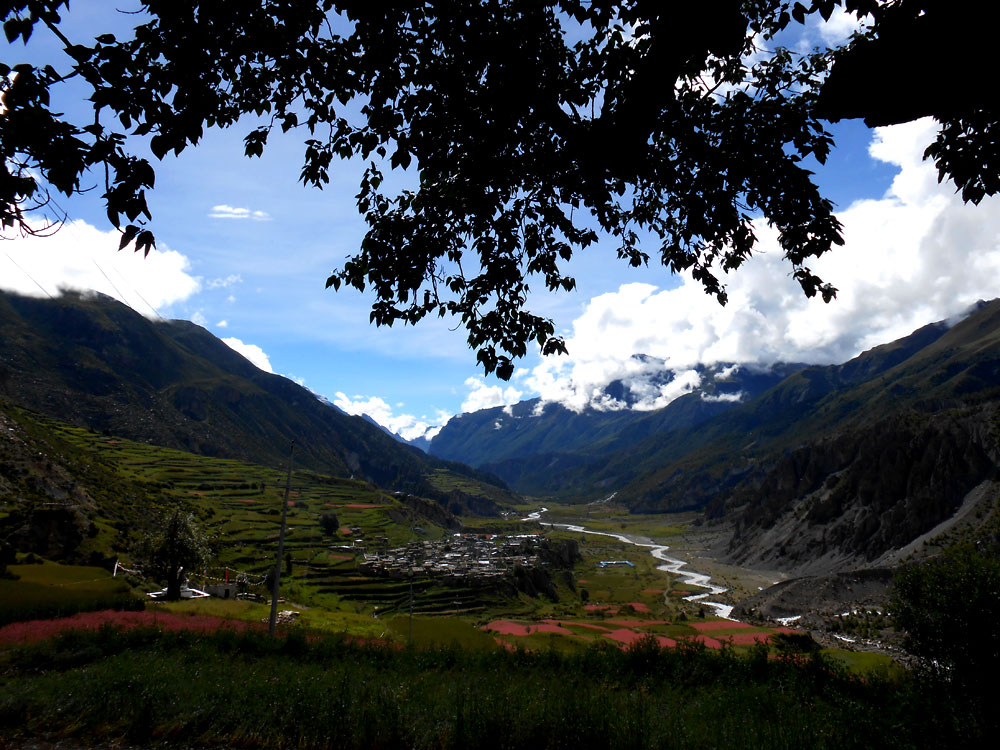
Extra Tips on Annapurna Circuit Weather and Temperature
- Choose the best time to trek on the basis of your own preferences.
- Pack necessary and adequate gears depending on the season and weather that you are trekking in.
- The weather and temperatures at Thorong La pass are one of the extremes in the region. Prepare yourself to encounter any sort of hassles on the trek. Get ready to encounter any challenges that the weather and temperature variations have to offer you.
There are no seasons when the Annapurna Circuit trek isn’t doable. When do you want to trek is your preference. Every season has its own pros and cons. So, with smart preparation, clothing, gears, and supplies, you will have a beautiful Annapurna Circuit Trek 18 days.
We recommend Annapurna Circuit treks during Autumn and Springs as these are the best time for Annapurna Trekking. If you do not have time to go in these seasons, then you can also trek in the other seasons. Or you can simply choose to trek in the routes that are suitable for trekking in offseasons.
Do not hesitate to contact us , if you are planning your Annapurna Circuit Trek. We will be happy to organize a beautiful trek for you. Let us know when you are free. High Camp Adventure is a renowned trekking company in Nepal that organizes and arranges the beautiful treks and tours in Nepal.
- Mountain Guide
- Mount Everest
- Trekking Tips
- Trekking and Hiking
- Travel in Nepal
Send an Enquiry
Recent post.

- Your Ultimate Guide to Annapurna Base Camp Trek: Itinerary, Cost, and Packages
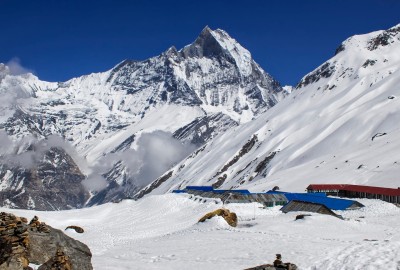
Best places to visit in Nepal
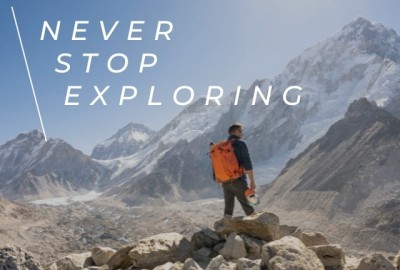
Stunning Everest Base Camp Trek: High Altitude Beauty
Related posts.
- Unveiling the Majesty: Annapurna Base Camp Trek with High Camp Adventure
- Discovering the Himalayan Ecosystem | Annapurna Base Camp Trek
- The Journey To The Land Beyond The Mountains | Upper Mustang Trek
- Beginners Guide to Mardi Himal Base Camp Trek, High Camp Adventure
- Annapurna Circuit Trek in November
- Annapurna Circuit Trek vs Everest Base Camp Trek
- Ghorepani Ghandruk Trek
- Everest Base Camp Helicopter Tour
- Everest Region Guide
- Langtang Region Guide
- Manaslu Trek Guide
- Mardi Trek Guide
- Mustang Guide
- News and Events
- People and Culture
- Travel Deals
- Ttavel Ideas
- Uncategorized
High Camp Adventure Pvt. Ltd.
Find your adventure. The mountains are calling.
Discover A New Adventure
- Duration 0 - 10 10 - 20 20 - 30 30 - 40
- Trip Difficulty Easy Moderate Moderate to Strenuous Strenuous Very Strenuous
- Group 1 - 20 1 to 20 1 to 5 1-10 2 to 20 2-20 2+
- Altitude 0 - 500 500 - 1000 1000 - 1500 1500 - 2000 2000 - 2500 2500 - 3000 3000 - 3500 3500 - 4000 4000 - 4500 4500 - 5000 5000 - 5500 5500 - 6000 6000 - 6500 6500 - 7000 7000 - 7500

- Everest Region
- Annapurna Region
- Langtang Region
- Manaslu Region
- Other Treks
- 10 Days Himalyan Buddhist Pilgrimage Tour Nepal
- 13 Days Nepal Buddhist HimalayanTour
- 14 Days Nepal Bhutan and Tibet Tour
- 11 Days Nepal and Tibet Tour
- 9 Days Nepal and Bhutan Tour Package
- 11 Days Delights of Bhutan tour
- 5 Days Bhutan Highlights tour
- 5 Days Bhutan Cultural Tour
- 7 Days Taste of Bhutan tour
- 4 Days Tibet Lhasa Tour
- 14 Days Manasarovar and Mt. Kailash tour
- 8 days Lhasa EBC Tour and Trek
- 1 Day Kathmandu world heritage sites tour
- 6 Days Kathmandu Pokhara Tour
- 5 Days Kathmandu Nagarkot Dhulikhel
- 10 Days Highlight Nepal Tour
- 28 Days Himlung Expedition
- 36 Days Ama Dablam Expedition
- 22 Days Naya Kanga Peak Climbing
- 19 Days Tharpu Chuli Climbing
- 16 Days Lobuche East Peak Climbing
- 14 Days Chulu East Peak Climbing
- 16 Days Yala Peak Climbing
- 15 Days Pisang Peak Climbing
- 14 Days Island Peak Climbing
- 18 Days Chulu west Peak Climbing
- 14 Days Mera Peak Climbing
- 14 Days Everest Base Camp Trek
- 16 Days Everest Base Camp Trek By Road
- 20 Days Everest Classic via Jiri Trek
- 18 Days Everest Base Camp With Gokyo Trek
- 13 Days Gokyo Lakes Trek
- 12 Days Scenic Pike Hill Trek
- 1 Days Everest Base Camp Helicopter Tour
- 11 Days Everest Base Camp Heli Trek
- 20 Days Everest Three Passes Trek
- 9 Days Everest panorama Trek
- 14 Days Everest Base Camp Luxury
- 12 Days Ama Dablam Base Camp Trek
- 13 Days Annapurna Circuit Trek
- 10 Days Annapurna Basecamp Express Trek
- 12 Days Annapurna Base Camp Trek
- 8 Days Annapurna Panorama View Trek
- 11 Days Khopra Danda Trek
- 10 Days Mardi Himal Trek
- 11 Days Mohare Danda Trek
- 14 Days Annapurna Sanctuary Trek
- 8 Days Jomsom Muktinath Trek
- 21 Days Nar Phu Valley Trek
- 10 Days Langtang Valley Trek
- 11 Days Langtang Gosaikunda Trek
- 10 Days Tamang Heritage Trek
- 15 Days Tamang Heritage and Langtang Valley Trek
- 8 Days Helambu Trek
- 13 Days Ganja La Pass Trek
- 22 Days Manaslu Trek with Tsum Valley
- 20 Days Tsum Valley Trek
- 34 Days Manaslu Circuit Nar-Phu Trek
- 16 days Manaslu Circuit Trekking
- 17 days Upper Mustang Trekking
- 5 Days Nagarkot Chisapani Trek
- 18 Days Lower Dolpo Trek
- 24 days Kanchenjunga Trek
- 26 Days Upper Dolpo Trek
- Why Book with Us
- Legal Documents
- Our Friends
- Terms and Conditions

Weather And Temperature In Annapurna Circuit
The weather and temperature in the Annapurna Circuit is the first thing you should consider if you plan to trek on the Annapurna Circuit. Planning a trek requires knowledge of weather and temperature, especially in Nepal, where landscapes and altitude can significantly impact the weather. Due to its location, Annapurna Circuit has different temperatures and weather. The weather and landscapes of the Annapurna Circuit make it an ideal destination for a trek.
Table of Contents
The Annapurna Circuit Trek is a popular destination that provides stunning views. The trek, which begins at Besi Sahar, takes hikers through subtropical meadows and rice fields before reaching the alpine peak section. The highlight is Thorung La Pass, at 5,416m, offering one of the most spectacular views in Nepal. The trail then descends into the drier Mustang Region, where the climate changes again as the terrain becomes semi-arid.
Annapurna Circuit Trek Temperature:
Annapurna circuit trek temperature in january:.
Because January is all in the winter season, it is regarded as the coldest month in Nepal. The temperature depends upon your elevation, the temperature range from -2°C to 7°C (28°F to 45°F) in lower regions and drop to -10°C (14°F) or even lower in higher elevation.
Annapurna circuit trails are less crowded in January, making them ideal for peace-seekers. Off-season accommodations are easy to find. The months offer clear mountain views and unobstructed views of the mountains. However, weather conditions are unpredictable. The higher region is mostly below 1°C. Proper clothing is required for the Annapurna Circuit during January.
Annapurna Circuit Trek Temperature In February:
February is the end of the winter season in Nepal, so the temperature seems to be mixed during this month. The temperature of the Annapurna Circuit Trek ranges between -1°C and -14°C, which is extremely cold. The upper elevations are even colder.
Annapurna Circuit Trek Temperature in March:
March is the perfect month to visit Annapurna Circuit, as it is the start of beautiful spring weather with flowers, greenery, rhododendrons, and oak trees. The temperature during night ranges from 4°C to -8°C, and reach up to 10°C during the day. You’ll get stunning views of snow-covered mountains and flower-covered forests during March in Annapurna Circuit.
Annapurna Circuit Trek Temperature in April:
April is a peak month for the Annapurna Circuit trek due to the warm weather and uninterrupted mountain views. The average daytime temperature in higher regions ranges from 8°C to -4°C, while lower areas have a temperature of 20°C. Nights are colder, so it’s essential to pack warm clothes for travel during this month. The trails are packed with many trekkers.
Annapurna Circuit Trek Temperature In May:
In May, the weather is warm for trekking. In higher regions, the temperature varies from 14°C to 0°C, and in lower regions, it ranges from 18°C to 20°C. The month is warm, with temperatures of 5°C at night. Thorung La Pass, the highest pass, is the coldest area. Clouds may obstruct views, and few rainfalls are expected at the end of May. Therefore, waterproof jackets, boots, and pants are recommended for trekking this month.
Annapurna Circuit Trek Temperature In June:
June provides temperatures of 16°C to 30°C and heavy rainfall, making trails slippery and muddy that’s why June is also called the rainy season. The temperature in higher regions is -3°C to -4°C. The temperature in June is unpredictable due to unpredictable rainfall and June is not regarded as a good time for a trek. However, some adventurous trekkers visit the region fully equipped with rain gear during this month.
Annapurna Circuit Trek Temperature In July:
July is the highest rainfall month, with temperatures ranging from 18°C to 6°C. The average temperature is about 12 degrees Celsius. The Bay of Bengal’s wind causes continuous rainfall during July, causing clouds and blocking mountain views. Monsoon trails are filled with leeches and mosquitoes. Due to rainy and wet days, trekkers are advised to wear waterproof jackets, pants, and boots. A few warm outfits can work for both morning and night temperatures. The weather is mostly rainy and wet, making it challenging to enjoy mountain views.
Annapurna Circuit Trek Temperature in August:
The average temperature in the Annapurna Circuit in August remains similar to July, with temperatures ranging from 19°C to 23°C. Trails are mostly blocked by landslides and erosion, and the routes are muddy and slippery. Mountain views are limited due to the rain. Making it less popular for the Annapurna Circuit.
Annapurna Circuit Trek Temperature In September:
September marks the start of the peak season of the autumn season, with clear, bright weather. Light rainfall occurs in the first few weeks. The weather gets colder, from 17°C to 4°C. At Thorong La Pass, which is 5416m high, it is very cold during the day, with a temperature near -4°C. The weather improves with the days, with clear skies and sunny days in late September.
Annapurna Circuit Trek Temperature In October:
October is the best month for trekking in the Annapurna Circuit because the weather is stable, along with beautiful mountain views, and the trekking routes are not too difficult.
The lower areas are warmer with temperatures of 15°C during the day. The higher areas have colder temperatures ranging from 7°C to 8°C. The Thorong La Pass is very cold. The warm and sunny days in October bring people from all around the world to see the undisturbed sights of the Himalayas.
Annapurna Circuit Trek Temperature In November:
November is an excellent time to trek in Nepal, with similar weather conditions to October. The Annapurna Circuits experience an average day temperature of 15°C, while nighttime temperatures range from 7°C to 8°C. However, higher passes like Thorung La Pass (5,000m) remain frozen, with temperatures dropping to -5°C in areas around them. You can notice a difference in temperature between daytime and nighttime, making November an ideal time for trekking in Nepal.
Annapurna Circuit Trek Temperature In December:
In December, the Annapurna Circuit experiences extreme cold as the winter season starts, with mountains covered in snow and minimal rainfall. The average daytime temperature drops from 10°C to 5°C, with nighttime temperatures dropping to -5°C. Areas above 4000m experience even colder conditions. The weather is adjustable at the start but starts to freeze at the end of the day. Snowfall can occur at any time, making trails difficult to traverse. Therefore, it is essential to equip all winter gear during this month’s visit to the circuit.
Annapurna Circuit Trek Weather
Annapurna circuit trek weather in autumn:.
Autumn(September to November) is the ideal season for the Annapurna Circuit trek due to its pleasant weather, natural beauty, and cultural experiences. The daytime temperatures range from 15°C to 20°C, providing a comfortable balance for trekking. However, as the sun sets and darkness sets, temperatures can drop to around 5°C.
The scenery changes with bright colors from leafy trees and flower-filled forests. Trekking during autumn also provides cultural immersion, with local villages and communities and experiencing Nepali festivals. Engaging with locals, enjoying traditional Nepali cuisine, and learning about the region’s rich culture adds a uniqueness to the trekking experience.
Annapurna Circuit Trek Weather In Spring:
Spring(March to May) is a magical time to trek in Annapurna Circuit when nature begins to awaken and the weather is stunning. The days are longer, and the sun shines warmly, making trekking enjoyable. The season brings colorful flowers, such as the rhododendrons, which are the national flower of Nepal. Different varieties of flowers and plants bloom, which creates an amazing green environment.
The daytime temperature will be around 10°C to 20°C, but at night, the temperature will be cold. This season provides perfect weather for those who love being surrounded by beautiful nature and colorful scenery. The Annapurna Circuit Trek in the spring season is an amazing adventure that is full of awe-inspiring views and natural beauty. This season is an excellent time to experience the beauty of the region and embark on a memorable trekking adventure.
Annapurna Circuit Trek Weather In Winter:
Winter on the Annapurna Circuit, from December to February, brings a unique set of challenges and rewards for trekkers. The landscape transforms into a winter wonderland, with snow covering mountains, forests, and routes. Weather brings Heavy snowfall can obstruct trekking paths and make walking on snowy terrain challenging. However, the snowy landscape adds beauty to the surroundings. During the day, the temperature is around 10°C, but at night, temperatures decrease below the freezing point.

Annapurna Circuit Trek Weather In Summer:
Weather in Summer(June to August) is characterized by heavy rain and muddy trails in Annapurna Circuit, which makes your trekking difficult. The temperature reaches 25°C during the day and cooler at night. Leeches, and unsettling creatures, can also be seen in wet and muddy areas.
Therefore, summer trekking in the Annapurna region is not ideal due to heavy rain, slippery trails, and leeches. However, if you enjoy the lush greenery and encounter leeches, summer trekking can still be an adventure, provided you have waterproof gear and are prepared for rainy days.
What is the climate in the Annapurna Circuit?
The Annapurna Circuit Climate depends upon the season however, the region experiences warm temperatures at daytime, with lower regions ranging from 15-23°C and higher altitudes below 10°C, with the highest points reaching below freezing point.
Is the Annapurna circuit cold?
High passes like Thorong La experience -4°C temperatures, while the Annapurna Circuit offers warm temperatures below 2,500 m and slightly colder temperatures from 2,500 to 4,000 m.
Which season is best to trek in Annapurna Circuit?
Generally, the spring and autumn seasons are regarded as the best seasons to trek in Annapurna Circuit; however, it is your choice when to trek. If you love adventure and can face any difficulty, you can trek off-season as well, but only with proper precaution.
What level of coldness is experienced during the night while trekking in the winter season?
At higher elevations, nighttime temperatures can drop from -10°C to -15°C (14°F to 5°F) during the winter season in Annapurna Circuit. That’s why the winter season is not regarded as the best time for trekking in Annapurna Circuit.
Conclusion
The Annapurna Circuit Trek is a thrilling adventure in Nepal’s beautiful Annapurna Region, accessible throughout the year and provides unique experiences in each season. it is necessary to be well-prepared and aware of seasonal variations for your safe and enjoyable trek. Choosing the right gear and equipment for each season can make the trek more enjoyable. Choose the season that best suits your expectations and enjoy the wilderness and serene mountains of the Annapurna Region.
Recent Blogs
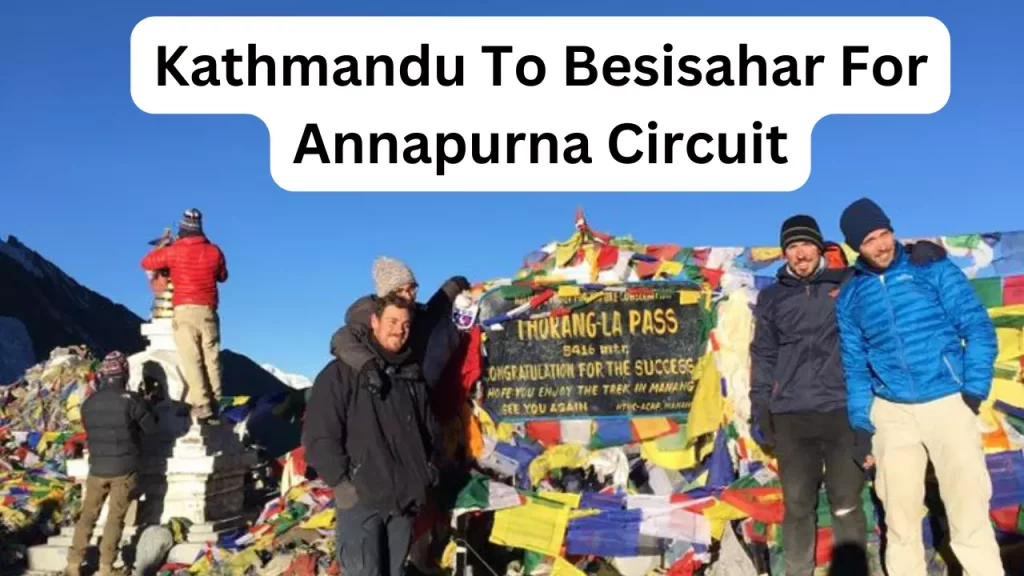
How To Get from Kathmandu to Besisahar? Flight, Bus
Kathmandu to Besisahar is an iconic journey for anyone traveling to Nepal. The 173 km journey takes you through some of the most breathtaking landscapes in the country. Travelers have the option to take a bus, plane, or jeep, depending on the kind of experience they are looking for.
![Ama Dablam Expedition [The Essential Guide] 2 Ama Dablam Expedition](https://www.thirdeyeadventure.com/wp-content/uploads/2024/05/blog_thumbnail-29-1024x683.png)
Ama Dablam Expedition [The Essential Guide]
Mt. Ama Dablam Expedition is a renowned adventurous climbing tour for the world-class steep peak that involves climbing Mt. Ama Dablam which is the most...
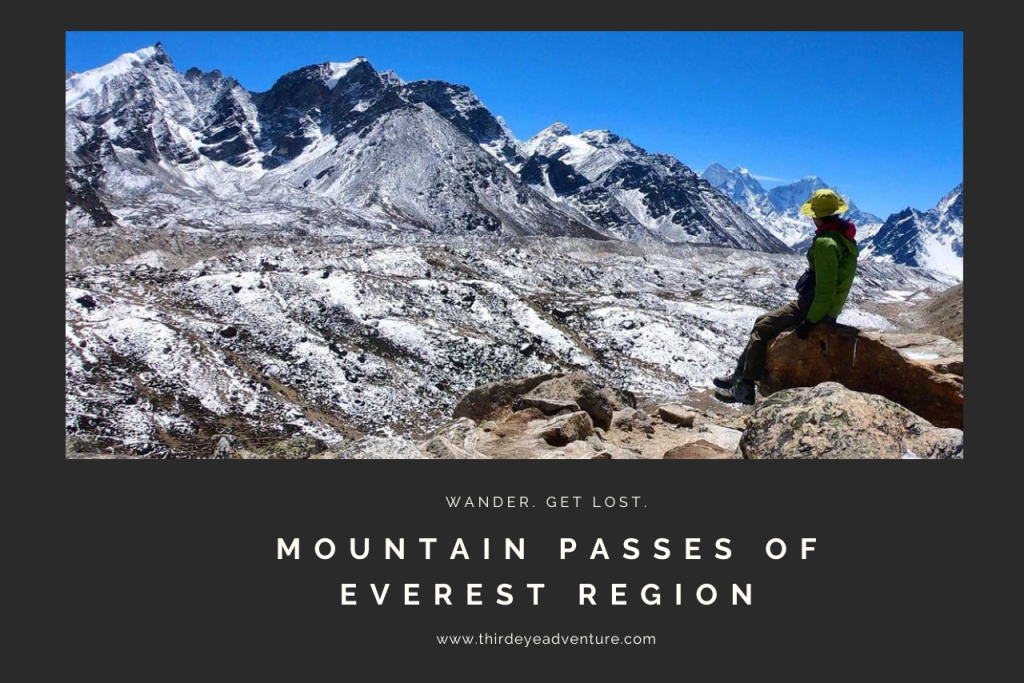
Mountain Passes of Everest Region
Everest Region which is also known as the Khubu region, has an almost mystical status in the world of trekking. It's often described as a...

Mountain Passes of Annapurna Region
The Nepal region of Annapurna is a big name in the world of international tourism due to its breathtaking beauty, a variety of distinct cultures,...
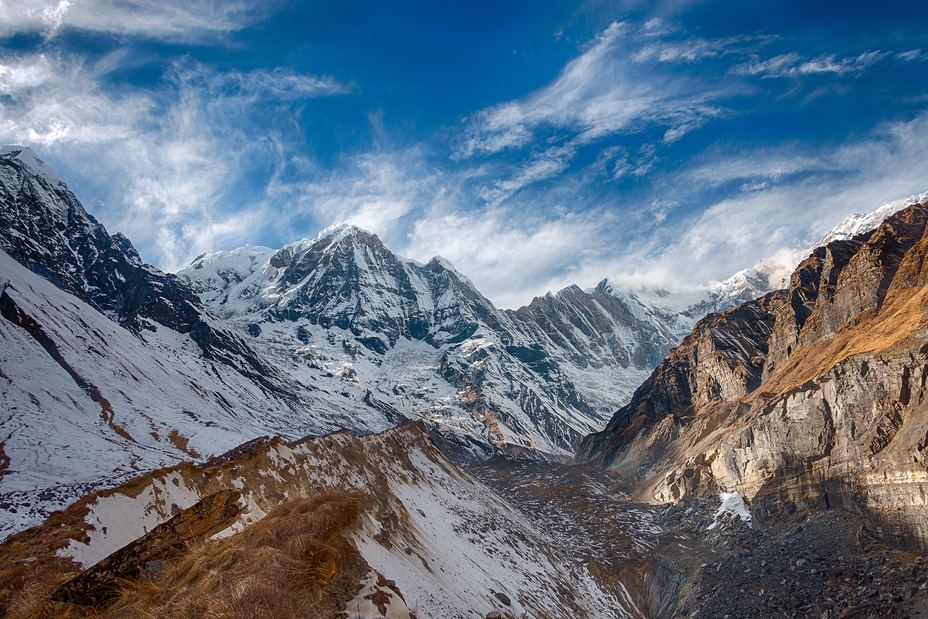
- Greater Himalaya
- Annapurna Himal
Annapurna Sanctuary Weather Forecast, Nepal Issued: 10 pm Wed 15 May Local Time Updates in: hr min s Update imminent

- Weather Map
- Mountain Info
- Climbing Notes (1)
- Photos (17)
- Peak: 4130 m
- Base: 1500 m
Annapurna Sanctuary Weather (Days 0-3):
The weather forecast for Annapurna Sanctuary is: Light rain (total 4mm), mostly falling on Wed night. Mild temperatures (max 7°C on Fri morning, min 2°C on Wed night). Wind will be generally light.
Annapurna Sanctuary Weather (Days 3-6):
Moderate rain (total 20mm), heaviest on Sun afternoon. Mild temperatures (max 7°C on Mon morning, min 4°C on Sat night). Wind will be generally light.
Annapurna Sanctuary Weather (Days 6-9):
Moderate rain (total 18mm), heaviest on Tue night. Mild temperatures (max 8°C on Fri morning, min 5°C on Tue night). Wind will be generally light.
This table gives the weather forecast for Annapurna Sanctuary at the specific elevation of 4130 m. Our advanced weather models allow us to provide distinct weather forecasts for several elevations of Annapurna Sanctuary. To see the weather forecasts for the other elevations, use the tab navigation above the table. For a wider overview of the weather, consult the Weather Map of Nepal .
Live conditions reported by 5 closest weather stations
* NOTE: not all weather observatories update at the same frequency which is the reason why some locations may show data from stations that are further away than known closer ones.
Annapurna Sanctuary Photos
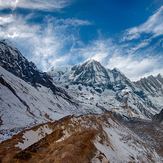
Annapurna Sanctuary

The Annapurna

Man in the mountain

Annapurna range sunrise
- Download the app
- Cookie Policy
- Privacy Settings
- Do Not Sell My Personal Information
- Mountain Ranges
- Dynamic Weather Maps
- Static Weather Maps
- Mountain Photos

© 2024 Meteo365.com
Trekking and Peak Climbing in Nepal
- Regd. No.:63295/065/066
- Tourism Licence:1632
- VAT No.:303818070
Home » Annapurna Guide » Annapurna Circuit Trek Weather and Temperature
Annapurna Circuit Trek Weather and Temperature
No hike in Nepal prepares mountaineers quite like Annapurna Circuit Trek. It enfolds everything from soul-stirring landforms to steep terrains and vast green meadows. The timeless old rugged trail has the coolest view to offer with a range of snow peaks and forests.
Starting from a plain surface, then a jagged route and miles away to the world’s highest pass, Annapurna Circuit Trek covers it all. If that wasn’t good, it also offers delightful weather at a given period of time.
Annapurna Circuit Trek weather and Temperature keeps on changing with every place, and season. So, it’s quite tough to come with one kind of weather or describe how the climate is at the circuit.
Autumn and Spring have by far a refreshing atmospheric condition with sunny days and bitter nights. The month that’s next to winter is slightly colder than the preceding one in autumn but still bearable.
Meanwhile, Monsoon and winter have the least number of visitors, following its severe weather. The month during the season sees its worst Annapurna Circuit Trek weather and temperature that makes trekking unachievable every so often.
In winter, the climate at the circuit can be below -20 Degree Celsius which is unbearable. Even the trail at height experiences a heavy snowfall which compels the trekker to postpone their trekking.
Annapurna Circuit trek weather and temperature
The weather and temperature at Annapurna Circuit Trek is dynamic but not constant. It alternates with the changing season and causes the view to characterize. The gradual rise and fall of temperature steer the weather, making circuit trek easy and tough at times.
Weather at Annapurna Circuit Trek in Autumn Season
Autumn indicates the trekking season in Nepal with warm days and a bit cold night. Weather is often calm and comforting but varies each month. At the start of August, there is occasional rainfall coming from monsoon which soaks through the land.
By the end of the month, several parts of the region start to heat up in the day. Surprisingly, mornings are still crisp and beautiful with mild weather to relish. After drops of rain washing the dirt, September offers a clear view of vibrant valleys and mountains.
Trail making its way to the circuit is filled with fall foliage from orange to tinted red and yellow. The color of autumn seems to uplift the energy and bring a positive attitude among trekkers. As October makes its way into the region, trekkers may feel less warm even during the day.
Morning and nights become cold day by day with winter just next door. Coming towards the end of the month, trees in the forest barely have their leaves on. Trekkers can even witness snowfall at high altitudes and even cool breeze moving from the mountain in the last few days.
- Full Name *
- Country * Afghanistan Åland Islands Albania Algeria American Samoa Andorra Angola Anguilla Antarctica Antigua and Barbuda Argentina Armenia Aruba Australia Austria Azerbaijan Bahamas Bahrain Bangladesh Barbados Belarus Belgium Belize Benin Bermuda Bhutan Bolivia Bonaire, Sint Eustatius and Saba Bosnia and Herzegovina Botswana Bouvet Island Brazil British Indian Ocean Territory Brunei Darrussalam Bulgaria Burkina Faso Burundi Cambodia Cameroon Canada Cape Verde Cayman Islands Central African Republic Chad Chile China Christmas Island Cocos Islands Colombia Comoros Congo, Democratic Republic of the Congo, Republic of the Cook Islands Costa Rica Côte d'Ivoire Croatia Cuba Curaçao Cyprus Czech Republic Denmark Djibouti Dominica Dominican Republic Ecuador Egypt El Salvador Equatorial Guinea Eritrea Estonia Eswatini (Swaziland) Ethiopia Falkland Islands Faroe Islands Fiji Finland France French Guiana French Polynesia French Southern Territories Gabon Gambia Georgia Germany Ghana Gibraltar Greece Greenland Grenada Guadeloupe Guam Guatemala Guernsey Guinea Guinea-Bissau Guyana Haiti Heard and McDonald Islands Holy See Honduras Hong Kong Hungary Iceland India Indonesia Iran Iraq Ireland Isle of Man Israel Italy Jamaica Japan Jersey Jordan Kazakhstan Kenya Kiribati Kuwait Kyrgyzstan Lao People's Democratic Republic Latvia Lebanon Lesotho Liberia Libya Liechtenstein Lithuania Luxembourg Macau Macedonia Madagascar Malawi Malaysia Maldives Mali Malta Marshall Islands Martinique Mauritania Mauritius Mayotte Mexico Micronesia Moldova Monaco Mongolia Montenegro Montserrat Morocco Mozambique Myanmar Namibia Nauru Nepal Netherlands New Caledonia New Zealand Nicaragua Niger Nigeria Niue Norfolk Island North Korea Northern Mariana Islands Norway Oman Pakistan Palau Palestine, State of Panama Papua New Guinea Paraguay Peru Philippines Pitcairn Poland Portugal Puerto Rico Qatar Réunion Romania Russia Rwanda Saint Barthélemy Saint Helena Saint Kitts and Nevis Saint Lucia Saint Martin Saint Pierre and Miquelon Saint Vincent and the Grenadines Samoa San Marino Sao Tome and Principe Saudi Arabia Senegal Serbia Seychelles Sierra Leone Singapore Sint Maarten Slovakia Slovenia Solomon Islands Somalia South Africa South Georgia South Korea South Sudan Spain Sri Lanka Sudan Suriname Svalbard and Jan Mayen Islands Sweden Switzerland Syria Taiwan Tajikistan Tanzania Thailand Timor-Leste Togo Tokelau Tonga Trinidad and Tobago Tunisia Turkey Turkmenistan Turks and Caicos Islands Tuvalu Uganda Ukraine United Arab Emirates United Kingdom United States Uruguay US Minor Outlying Islands Uzbekistan Vanuatu Venezuela Vietnam Virgin Islands, British Virgin Islands, U.S. Wallis and Futuna Western Sahara Yemen Zambia Zimbabwe Country
- Number of Travellers *
- Phone Number
- Approximate Date Day 1 2 3 4 5 6 7 8 9 10 11 12 13 14 15 16 17 18 19 20 21 22 23 24 25 26 27 28 29 30 31 Month 1 2 3 4 5 6 7 8 9 10 11 12 Year 2025 2024 2023 2022 2021 2020 2019 2018 2017 2016 2015 2014 2013 2012 2011 2010 2009 2008 2007 2006 2005 2004 2003 2002 2001 2000 1999 1998 1997 1996 1995 1994 1993 1992 1991 1990 1989 1988 1987 1986 1985 1984 1983 1982 1981 1980 1979 1978 1977 1976 1975 1974 1973 1972 1971 1970 1969 1968 1967 1966 1965 1964 1963 1962 1961 1960 1959 1958 1957 1956 1955 1954 1953 1952 1951 1950 1949 1948 1947 1946 1945 1944 1943 1942 1941 1940 1939 1938 1937 1936 1935 1934 1933 1932 1931 1930 1929 1928 1927 1926 1925 1924 1923 1922 1921 1920
- Send us your enquiry *
- Solve (6+6=?) & submit button will appear *
Weather during Spring Season at Annapurna Circuit Trek
Another prime season for trekking, Spring overall has delightful weather with splendid views. The season usually starts from mid-march with the temperature steadily rising after winter.
Knowing that trekkers might still want to pack warm clothes since snow effects can be seen in varied places. After March, there is a seasonal warmth in the air with sun-filled days. Trees in the forest including oak and pine start to regain their leaves as winter comes to an end.
Adding the beauty of Annapurna region is full-bloom rhododendron, filling hillside forest. As the temperature soars by mid-April, trekkers will have to beat hot days to reach the circuit. Expect the temperature to rise slowly from the month as it approaches blazing hot summer.
Weather in May is quite summerish with a tropical climate fueling hot days. As spring is near to over, there is excessive humidity in the air which can create slight trouble. Other than that spring season is wonderful to trek and sightsee the astounding snow peaks at Annapurna Circuit.
You may also like:
- Annapurna complete trek
- Kanchenjunga Trekking Nepal
- Tamang Heritage Trail Trek Lantang
Weather at Annapurna Circuit during Winter Season
Winter is arguably not the best time for trekking in Nepal. That being said hikers can yet do it by taking preventive measures. December often calls for the winter season in Nepal with frosty mornings and nights.
As the temperature starts dropping dramatically, much of the place endures a cold climate. A gust of wind blowing from the mountain over and again reminds trekkers that its winter and hiking is going to be tough.
The month unfolds a nostalgic autumn essence with a bitter atmosphere. January being coldest of the month has unbearable weather with temperature sinking below minus.
Regardless of that, hikers can still make their own fond memories along the track under fresh layers of snow. Trekking via Thorong La Pass is tremendously difficult and seldom impossible in January with heavy snowfall.
Dawn in Annapurna Circuit during the month will be misty with fogs looming out of the darkness. After everything, the weather is again to witness warm sunshine with the start of February . Annapurna Circuit Trek weather and temperature have a mixed taste of autumn and winter in February.
At the beginning of the month, there’s a wintry climate while the end of the month experiences a broken light of day. Days are chilly but clear and pleasant surrounded by spring weather.
Annapurna Circuit Trek during Monsoon Season
Monsoon has never been a close ally of trekking in Nepal. No matter how the trek routes in the Himalayas are, it always puts hikers in an inconvenient situation. During monsoon, trails of Annapurna Circuit are damp with puddles of rainwater and debris.
Starting from June, places along the route encounter occasional rainfall that’s hard to forecast. It rains heavily in July causing the trail at lower south to be muddy and slippery. Trekkers at Annapurna circuit have to deal with strong monsoon wind coming from the bay of Bengal that brings rain with it.
Lighting strikes and heavy rainfall is normal and happens so often in hills. Meanwhile, at high altitude, the rain falls as snow, covering the entire trail. There is more humidity in the air during monsoon due to extreme heat in daytime and rainfall at night.
Similar articles you may like:
- Best Time for Annapurna Circuit Trek
- Trekking in Nepal in August
- Manaslu Trek Weather
What’s the temperature like at Annapurna Circuit Trek?
The temperature at Annapurna Circuit varies based on which time of the year you’re willing to visit. Normally, the weather below the circuit is gratifying with beautiful daylight that sticks around for quite a while.
But temperature keeps changing even then with different seasons making its way in. Days in summer are hot with temperatures rising all-time high. Similarly, in winter, the temperature gradually drops in Annapurna Circuit reaching below zero Degree Celsius .
The temperature at Annapurna Circuit Trek in Autumn
Autumn definitely sees a spike in visitors compared to the rest of other seasons. For this, it owes to favorable weather and temperature of the Annapurna circuit that doesn’t change drastically.
For almost 2-3 weeks , September endures low temperatures as winter keeps wandering all across the region. October has terrific weather and temperature that ranges from 7-8 Degree Celsius at night.
The temperature of Annapurna circuit trek during autumn is 15 Degree Celsius on average . Reaching a high altitude like Thorong La Pass, the temperature tumbles down quickly.
Annapurna Circuit Trek temperature during Spring
Spring has maintained a high standard in terms of Annapurna circuit trek weather and temperature. It’s for the tranquilizing atmospheric condition of spring, so many trekkers do the circuit trek throughout the month.
Spring has relishing weather with nice moisture in the air. As the season comes right after winter, there’s less humidity in the air. Skies are bright and clear in the season, offering spectacular views of mountains and diverse landscapes.
Stoke up by rising temperatures of up to 20 Degree Celsius , days are hot in spring. Most places around Muktinath are dry, receiving little or no rainfall. Higher altitude like Thorong La Pass has a temperature at freezing point.
The temperature at Annapurna Circuit Trek in Winter
The temperature during winter is more frigid with heavy snowfall that coats the trek route. Hikers will have to walk on crampons on the greasy trail since relying on a climbing boot is unrealistic.
Weather in early November is still fine with temperatures ranging from 2-3 degrees celsius . But thereafter it steadily falls and reaches minus from the beginning of December. The average temperature at Annapurna Circuit trek in winter varies from 5 to 10 Degree Celsius at foothills.
As trekkers scramble far up, the temperature starts to fall off reaching a minimum -20 Degree Celsius . So if you intend to trek up to the circuit, pack a synthetic insulated sleeping bag that can resist cold climate.
The temperature at Annapurna Circuit Trek in Monsoon
June celebrates the arrival of Monsoon with light rainfall and thunderstorm at a lower elevation. But as days pass, the trail on the way to Annapurna circuit counters heavy rainfall that sees a drop in temperature turning on right from summer.
The temperature at Annapurna Circuit Trek in Monsoon is around 15 to 25 Degree Celsius. It drops little by little as trekkers ascend the steep hills and terrains to arrive at Thorong La Pass.
During the season, almost 70% of the total annual rainfalls over the land. Possibilities of mudflow and rockfalls always remain high during monsoon in lower regions.
Managing Director
Mr. Subash K.C ventured into the tourism industry after completing his studies in Management Stream in 2001 at Tribhuvan University. Mr. K.C, born and brought up in the Lalitpur district, is keenly interested in exploring the different trekking routes. Getting the opportunity to work in the tourism industry helped him gather insights about trekking across Nepal. In addition, he also learned about customer care and group management. By leading solo and group trekkers himself, he started collecting data about many trekking destinations in Nepal. He creates an enriching experience for national and international travelers through exceptional hospitality.
Apart from managing trekking and tours, Mr K.C also handles client inquiries, accommodation reservations, arrangements of transportation and flights, and other logistics. Recognizing the importance of personalized service, he proactively takes care of clients' needs and requirements. He is fluent in English and excels in organizing treks, tours, and adventure sports in Nepal, Tibet, and Bhutan.
He is highly committed to promoting responsible tourism and prioritizes client satisfaction by providing top-notch service through his well-organized company. He believes that through responsible traveling, we can protect the natural environment and promote sustainability. He has expanded his knowledge by traveling to various countries worldwide, such as India, Bhutan, Switzerland, Germany, France, Italy, Thailand, China, Singapore, Philippines, Vietnam, USA, Japan, UK, Canada etc and is passionate about exploring more destinations.

Annapurna Circuit Trek Weather and Temperature
- Last Updated on Feb 6, 2024
The Annapurna Circuit trail sees varying terrain and elevation. And because of these two factors, the weather and climate change throughout the journey. From the starting point of the trek, which generally is sub-tropical forests and terraces, the trail ascends to alpine forests, meadows, and finally to the top of Thorong La pass.
Not only that, in the next part of the route, you will come across trans-Himalayan climate and semi-arid landscapes as you continue from Muktinath Temple to Jomsom via Kali Gandaki Gorge. Likewise, the Annapurna Circuit trail location also affects the overall weather.
Depending upon the month you choose to do the Annapurna Circuit trekking, the weather & temperature can vary drastically. Given this diversity, trekkers need to understand the weather, temperature, and climate along the Annapurna Circuit trek route each month before they fix a departure date.
Keep reading the blog as it unfolds numerous helpful information about Annapurna Circuit trek weather and temperature in different months:

Short Annapurna Circuit Trek

Classic Annapurna Circuit Trek

Annapurna Circuit Trek
Table of contents, annapurna circuit trek weather and temperature by month, annapurna circuit trek weather and temperature in january.
By doing the Annapurna Circuit in January, you will dive into the heart of winter's grip. This time of the year sees freezing temperatures, which makes the region a winter wonderland with giant snow-capped peaks and icy trails. The upper part of the Annapurna Circuit trail experiences bone-chilling daytime temperatures, ranging from 1°C to a frigid -10°C.
The nighttime and morning are much colder as the temperature plunges even lower. However, the lower part of the trail offers a bit more respite, with temperatures ranging from 7°C to 12°C. Even though the cold is at its peak in January, trekking Annapurna Circuit during this month offers a serene trail with fewer trekkers.

The Manang Valley, Nepal
January is an off time for the Annapurna Circuit trek. Therefore, accommodation is also more readily available and at a cheap cost. As the day continues, you will get a crystal clear sky with stunning mountain vistas. However, the daytime is on the shorter side, so you have to start trekking early.
Likewise, Thorong La pass may be inaccessible in January, so you have to do proper research. Overall, the Annapurna Circuit trek in January demands meticulous preparation, particularly in terms of clothing. The risk factors are high in this month, and so are the rewards. You have to be much more careful and attentive.
Annapurna Circuit trek weather and temperature in February
February starts the end of the winter season. The weather is cold and unpredictable in this month as well, however the hint of spring begins to show towards the end of the month. The daylight hours gradually begin to increase as the days pass by, and the climate, especially at the lower elevation, starts to warm up.
You may come across occasional heavy snowfalls. The trails and mountains are covered with blankets of snow. The views can be obstructed on some days, but overall, the landscapes are clear. Likewise, the rivers, streams, and waterfalls also begin to thaw towards the end of the month.
In February, the temperature along the Annapurna Circuit trail ranges between -1°C to a frosty -14°C, but it gets better. As this is the last month of the winter season and also experiences a transitional time, the weather is very unpredictable. Annapurna Circuit trek gets very demanding in February because of added weather challenges.
Annapurna Circuit trek weather and temperature in March
March brings a refreshing shift to the Annapurna Circuit trail. It is the start of the spring season and stable weather. Known for its gentle climate and vibrant landscapes, this month offers a delightful blend of warmth and natural beauty. In short, March is one of the best times of the year to do the Annapurna Circuit trekking.
With the beginning of March, the winter gradually begins to fade away. The trekking route is thriving with vegetation and different shades of rhododendrons. You can see trees with little leaves, showcasing the arrival of life once again. The temperature sees a gradual rise, making trekking a bit comfortable.

The Manang Village in Annapurna Circuit Trail
In the lower regions, daytime temperatures range from a mild 4°C to a cool -8°C. During midday, the temperature reaches up to 10°C. However, the nights and mornings are still cold with crisp air. The snow and ice along the way melts, and the Annapurna Circuit trail is all open to welcome trekkers.
Note that there is little chance of snowfall in March too, so you have to be well prepared. The mountain views are clear and stunning. The daylight hours increase, giving you more time to enjoy the journey. For those embarking on the Annapurna Circuit in March, the weather promises an enjoyable and rejuvenating trekking experience.
Annapurna Circuit trek weather and temperature in April
In April, the Annapurna Circuit trail has the best weather, climate, views, and vegetation. The region is mostly warmed up, but you can still feel a hint of cold in the air. You have to carry a few warm pieces to wear during the Annapurna Circuit trek in April. As the sky remains clear in this month, the mountain views are uninterrupted.
Likewise, April is one of the busiest months for trekking. The Annapurna Circuit sees many adventure lovers, so booking accommodation early is necessary. Though the upper part of the trail has a cold climate, the lower elevation sees the temperature up to 20°C during the daytime. Generally, temperature ranges from -4°C to 8°C.
The rivers, streams, and waterfalls all are back to life. The entire trail is blooming with wildflowers and dense vegetation. You will have long daylight hours and less humidity. April is a great time to embark on the Annapurna Circuit trek because of its moderate climate, breathtaking scenery, and best trail conditions.
Annapurna Circuit trek weather and temperature in May
In the lower part of Nepal, the temperature exponentially rises by the end of the first week of May. However, the mountain region still experiences spring. May is the last month of the spring season and also a transitional period to summer/monsoon. The trail begins to empty in May, so you will enjoy tranquility. The temperature rises, and nature reaches its full bloom.
May presents favorable trekking conditions, with daytime temperature ranging from a comfortable 14°C to a refreshing 0°C in the higher regions. Likewise, the lower part of the trail sees a temperature between 18°C to 20°C. Despite the pleasant daytime temperature, nights in May retain a hint of chill, with average temperatures dropping to around 5°C.

The Marpha Village on the Annapurna circuit trail, Nepal
In May, the sky is clear, and there is abundant sunshine. The trekking route is in great condition. You have to dress up in layers and remove them as the climate demands. With that being said, the Thorong La pass remains cold even during this month. Cloud cover may occasionally obscure the mountain vistas.
Additionally, towards the end of May, irregular rainfall may occur, so make sure to pack waterproof gear. The humidity gradually increases as the month goes towards the end. Overall, May offers trekkers a unique opportunity to witness the beauty of the Annapurna region in full bloom.
Annapurna Circuit trek weather and temperature in June
June is the first month of summer/monsoon season. These two seasons go hand in hand, so the weather is quite unpredictable. Not many trekkers do the Annapurna Circuit trek in June because of unstable weather. In the lower regions of the circuit, temperatures range from a balmy 16°C to a scorching 30°C.
Likewise, the temperature ranges around -3°C to -4°C in the upper part of the trail. The landscape transforms into lush vegetation, bright days, and high humidity. The region sees occasional rainfalls. The trail condition gradually begins to deteriorate because of rainfalls. You may not get to see mountain views all the time.
Nevertheless, for true adventurers, June is an opportunity to undertake the added weather challenge. Overall, this month is not an ideal time for the Annapurna Circuit trekking. However, if you are into biodiversity, then it is one of the best months to explore the Annapurna Circuit.
Annapurna Circuit trek weather and temperature in July
By July, the monsoon season starts all over the country, including the Annapurna Circuit trail. The rainfall increases, and the temperature drops around 6°C to 18°C with an average of 12°C. The number of trekkers in this month is a handful to zero, so the trekking trails are empty and peaceful.
Because of the rain, the trail gets slippery and muddy with leeches and mosquitoes, particularly in bushy areas. Likewise, the risk of landslides also increases. Some sections of the trail may get closed due to landslides as well. The weather is unpredictable in July, and the days can get gloomy or sunny.
The relentless rainfall, driven by the winds from the Bay of Bengal, results in continuous downpours throughout the month, often shrouding the mountains in clouds and obscuring the breathtaking views. While the days may be damp and rainy, a few warm layers are needed in the evening and morning.
Despite the challenging weather, with proper gear and precautions, adventurous trekkers can still experience the thrill of the Annapurna Circuit trek in July. Extra caution is required.
Annapurna Circuit trek weather and temperature in August
August is another summer/monsoon month. Rainfall, hotness, and humidity, everything is high. The rainfalls are heavy and frequent. The persistent rain keeps the atmosphere chilly and moist. As this month progresses, temperatures gradually rise, typically ranging from around 19°C to 23°C. On a good note, August is also the last month of this season.

Himalayan view on Ghorepani Poon Hill!
The risk of periodic landslides and erosions is high in August, so trekkers have to be much more careful. The Annapurna Circuit trail is in its worst condition during this month, and the challenges add up. The sky is mostly cloudy, blocking the view. The daylight hours get small, and you have to plan everyday walking as per the weather conditions on that day.
There are almost no trekkers, and some tea houses may get closed. The price is also low for accommodation and meals. On the bright side, the vegetation, rivers, waterfalls, and streams are thriving in August. If you are thinking of doing the Annapurna Circuit trek in August, you have to be very well-prepared and assess the trail condition.
Annapurna Circuit trek weather and temperature in September
September starts the beginning of Autumn along the Annapurna Circuit trail. It is also a peak trekking season, and many trekkers do this trek in this season. During the first two weeks of this month, the weather is quite unstable, and you may see occasional downpours. However, as the day passes by, the weather gets stable, and the trail condition improves.
By mid-September, the landscape begins to transform, unveiling crystal-clear vistas. With the departure of the summer/monsoon, temperatures begin to drop, ranging from approximately 17°C to 4°C. At Thorong La pass, the temperature hovers around -4°C. The entire trail is open with tea houses ready to welcome trekkers once again.
Despite being the first month of Autumn, occasional overcast skies may obstruct some mountain views. Nevertheless, the terrain, saturated by the monsoon rains, bursts with vibrant greenery, offering enchanting panoramas at every turn. As the days progress, the weather improves steadily, with late September boasting clear skies and sunny days ideal for trekking.
Annapurna Circuit trek weather and temperature in October
October is the best time for the Annapurna Circuit trek. This month offers a blend of stable weather and breathtaking vistas. With minimal to no rainfall, October promises unobstructed views of the majestic mountains as clear skies prevail throughout the region. Trekking becomes much more delightful because of the moderate climate.
While the lower regions of the circuit boast mild temperatures, averaging around 15°C during the day, the higher altitudes offer cooler climates, with freezing temperatures greeting trekkers in the early mornings and evenings. The temperature ranges from 7°C to 8°C during the night. At Thorong La pass, the temperature drops further.
Warm clothing pieces are necessary if you are trekking in October. The trail flourishes with seasonal vegetation, gushing rivers, cascading waterfalls, and trekkers from all around the world. The atmosphere is quite vibrant and inspiring. Overall, the Annapurna Circuit trek experience is fantastic in October. This month is perfect for nature lovers.
Annapurna Circuit trek weather and temperature in November
November is the last month in the autumn season and also the last-best month of the year for the Annapurna Circuit trek. Trekkers get another excellent window to explore the Annapurna Circuit's rugged beauty. Much like October, November presents favorable weather conditions with clear blue skies, warm sunlight, and jaw-dropping mountain panoramas.
There is no rainfall or snowfall in November, which ensures a hassle-free trekking experience. The average daytime temperature ranges around 15°C. The night and morning sees temperatures around 7°C to 8°C. Moreover, the temperature further plunges as low as -5°C at Thorong La pass.

Annapurna circuit trekking trail!
This notable contrast between daytime and nighttime temperatures shows the need for proper clothing and gear. While November starts comfortably, the weather gets colder towards the end of the month. You will get ample daylight hours to enjoy the journey. The scenery is phenomenal, along with the overall trekking experience.
Annapurna Circuit trek weather and temperature in December
December is the last month of the year and also the beginning of the winter season. It marks the start of an off-season for Annapurna Circuit trekking. However, during the first two weeks of December you can do this trek. The weather gradually gets unstable, but the journey is still manageable.
As the coldest season descends upon the region, the snowfall begins to cover the region slowly. Winter unfolds as the driest season, with little to no rainfall. Temperatures begin to plummet, with the average daytime temperature ranging from 10°C to 5°C. Nights become bitterly cold, dipping as low as -5°C, particularly in areas above 4000 meters.
The trail is empty, so if you love tranquility, you can consider doing the Annapurna Circuit trek in December. However, trekkers must be prepared for the difficulties posed by snow-covered terrain. The days are mostly clear, with great mountain views. There is a very special smell in the air, which indicates the upcoming winter.
I hope that the above article is helpful to make your decision which time to choose to do the Annapurna Circuit Trek. We have few packages on Annapurna Circuit trail and some of them are Classic Annapurna Circuit Trek , Tilicho Lake and Annapurna Circuit , Nar Phu Valley and Annapurna Circuit and short Annapurna circuit trek .

Arjun Rijal
Hello, Hi & Namaste from the Himalayas !!!
I am Arjun Rijal, Founder Director of the Outfitter Himalaya Holidays P. Ltd & working as a travel planner/consultant for Nepal, Bhutan, and Tibet Travel. I love hiking, trekking, and traveling.
I have been in most of the trekking regions in Nepal, that include Everest Base Camp , Annapurna Base camp , Annapurna Circuit , Manaslu , and Langtang . I also have travelled to Bhutan , India & planning further travel to many other countries in the world.
Find my writing on traveling, trekking, tours, travel news, and updates about the tourism activities of Nepal, Tibet & Bhutan.
You can also follow me on social media to receive regular news and updates.
- Trip Advisor
Drop us a message
Recent posts.
- Deluxe Hotels in Chitwan
- Standard Hotels in Chitwan
- Deluxe Hotels in Pokhara
- Standard Hotels in Pokhara
- Deluxe Hotels in Kathmandu
- Standard Hotels in Kathmandu
Related Posts
- Annapurna Travel Guide
- Bhutan Travel Guide
- Everest Travel Guide
- Kathmandu Travel Guide
- Langtang Travel Guide
- Manaslu Travel Guide
- Nepal Travel Guide
- News and Updates
- Places to Stay in Nepal
- Pokhara Travel Guide
- Tibet Travel Guide
We use cookies to ensure that we give you the best experience on our website.

- Cultural Trips
- Wildlife Expeditions
- Destinations
- Outdoor Programs
- Discover trekking
- Health and fitness
- Experiential learning
- Trekking tips
- Outdoor skills
- Trekking gear
Annapurna Base Camp Trek Weather and Temperature
Annapurna Base Camp Trek weather varies throughout the year. The temperature on the Annapurna circuit trek remains cool and breezy. One of the most popular treks in Nepal, the Annapurna Base Camp trek or ABC, experiences varying temperatures and weather fluctuates across seasons.
ABC Trek has three seasons suitable for trekking: Spring, summer, autumn and winter. Each season experiences distinct weather and temperatures. In this blog, we will discuss the Annapurna Basecamp Trek weather and temperature across seasons in detail.
While winter temperature plummets below freezing points, summer has mild temperatures. However, summer also experiences sporadic rainfall. Hence, spring and autumn offer conducive weather and comfortable temperatures.
During the Spring months of March and April, day temperatures are generally pleasant but plummet to sub-zero at night. If you plan to visit Annapurna Base Camp during autumn, between September and November, be prepared for cold temperatures and breezy weather.
Avoid the monsoon months of June to August. The weather in Nepal is not favourable for trekking during this season.
Before planning your visit, it’s necessary to have an idea of the detailed Annapurna Base Camp Trek weather forecast and trek temperature. We have compiled a month-wise Annapurna Base Camp Trek temperature guide to help you plan your trek.
Annapurna Base Camp Trek Monthly Temperature Details
Annapurna base camp weather in winter (december to february).
Annapurna Circuit receives heavy snowfall during peak winter months, causing temperatures to drop below freezing points. The trail attracts fewer trekkers between January and February due to extreme temperatures.
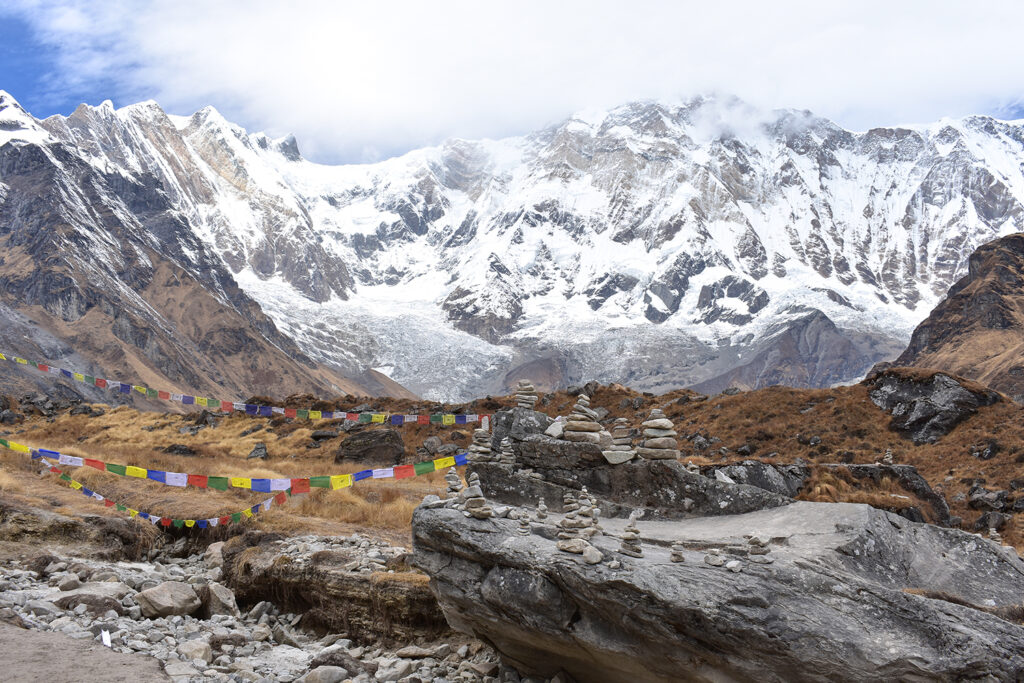
Annapurna Base Camp Temperature in December
ABC Temperature plummets below freezing point. Expect a minimum of -14°C and a maximum of 9°C in December. The cold breeze in the air intensifies, and you experience extreme temperatures.
Annapurna Base Camp Temperature in January
Annapurna Base Camp Trek weather is unpredictable in January. Temperature reaches freezing point and heavy snowfall causes delays and detours. The cold becomes unbearable at higher campsites if you cannot endure cold temperatures.
Day temperatures hover around 5°C to 7°C and the minimum is approximately -17°C.
Annapurna Base Camp Temperature in February
In February, the minimum touches -16°C and the maximum temperature reaches around 8°C. If you fancy a secluded trail and can endure subzero temperatures, you can attempt the Annapurna Base Camp trek in winter. However, be prepared for delays and detours due to snowfall.
Annapurna Base Camp Weather in Spring (March to April)
Annapurna Base Camp Trek in Spring attracts trekkers globally—the thought of pleasant temperatures and trailers painted with vibrant colours of Rhododendrons.
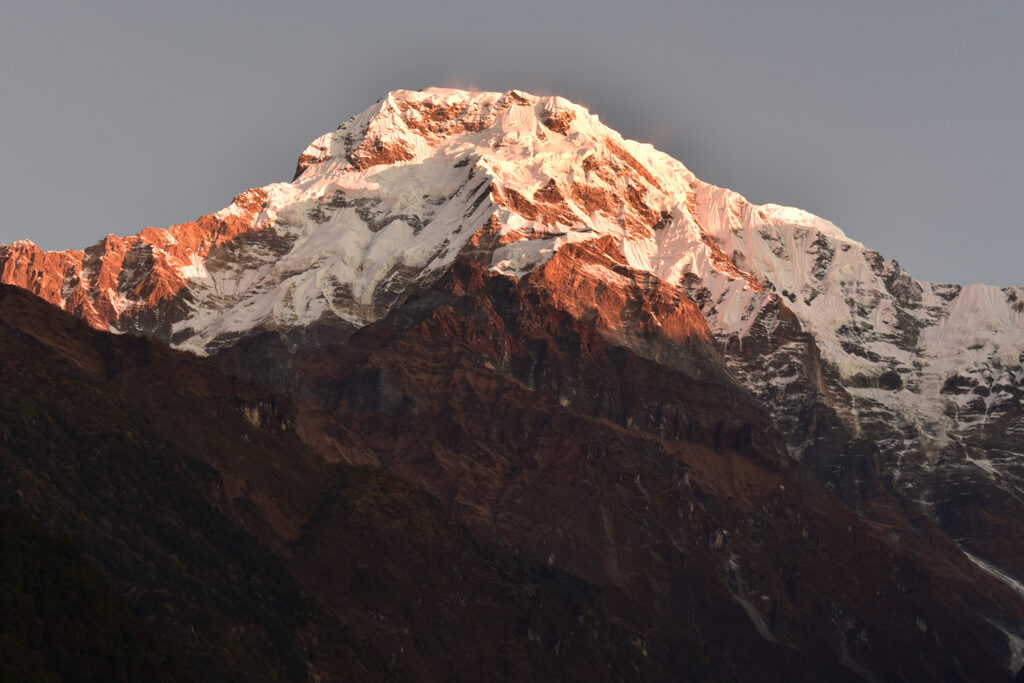
Annapurna Base Camp Temperature in March
Annapurna Base Camp temperatures remain pleasant and warm, with temperatures hovering around 4°C to 6°C. You will notice a drop in temperature as you climb to higher campsites. Early mornings and nights at the campsite will have lower temperatures between -8°C and -3°C.
Annapurna Base Camp Temperature in April
In April, the days will be slightly warmer as temperature increases. Annapurna Base Camp temperature in April ranges between °8C to 4°C during the daytime. You must add layers as the temperature drops to -4°C, increasing the cold at night. However, the pre-monsoon showers disrupt your trek. The clouds loom over the sky, with mountains often playing hide and seek.
Annapurna Base Camp Temperature in May
May is warm and sunny in ABC. Annapurna Base Camp temperature ranges between 10°C to 15°C in May in ABC. At night, the temperature drops to 0°C.
Annapurna Base Camp Weather in Monsoon (June to August)
The monsoon in Nepal arrives in June and lasts till August. The torrential rain in the region obstructs your trek with frequent landslides, slippery trails, and leech-infested forests. Although monsoon season has the warmest temperature, it is not the best time to visit the Annapurna Basecamp Trek in Nepal.
In the monsoon season, day temperature reaches 19°C and at night, you will experience a comfortable 3°C to 7°C.
Annapurna Base Camp Weather in Autumn (September to November)
The monsoon clouds dissipate, making way for clear blue skies.
The temperature in Annapurna Base Camp between September and November is pleasantly warm during the day. Clear blue skies, breathtaking mountain views and dry weather on the trail make autumn the favourite season.
The October weather is just perfect for trekking in Nepal. The days are perfectly sunny with clear skies. The weather will be clear and free of monsoon haze. The fog and dust are cleared from the trail and you will hike on warm and cozy September days.
Annapurna Base Camp Temperature in September
Annapurna Base Camp temperature ranges between 12°C and 15°C during the day. As you climb to higher altitudes, the cold increases. Night and early morning register subzero temperatures in ABC. Be prepared for temperatures between 2°C and -0°C at night. Consider Annapurna Base Camp trek in autumn if you detest extreme winter cold.
Annapurna Base Camp Temperature in October
In October, the temperature reaches a maximum of 10°C during the daytime and a minimum of -5°C at night. Come prepared with a minimum of four to five layers to guard against the biting cold.
Annapurna Base Camp Temperature in November
Trekkers experience a significant drop in temperature in November. November records a minimum of -7°C and a maximum of 10°C in ABC. While the weather remains warm as the sun shines bright during the day, the nights are chilly. Trekking in Nepal, however, has the comfort of cosy tea houses to protect yourself from biting cold outside. Carry enough layers to guard yourself from the biting cold night temperature.
Annapurna Base Camp Trek Highlights
The Annapurna Base Camp Trek in Nepal is one of the most popular treks in the world. ABC trek owes its popularity to its comfortable access to a grand view of the eight-thousanders. The trek offers you a glimpse of Mt.Annapurna right when you land in Pokhara.
ABC guarantees to leave you spellbound, offering exhilarating views of the giant mountain ranges. The trail traverses rice and paddies in the terrace farming, enchanting rhododendron forests. You walk through alpine landscapes with the Annapurna mountain range appearing in front of you. Most of your hike passes through the dense forest of the Annapurna Conservation Area.
The sceneries of Annapurna Base Camp are a feast for the eyes, offering breathtaking views of the Greater Himalayas up close. The magnificent Annapurna massif stands tall right in front of you, with Annapurna Dakshin, Machapuchre, and Himchuli offering a distinct view that leaves you yearning for more from the very first day.
Annapurna Base Camp trek lies within the Annapurna Conservation Area in Nepal and starts from Kimchey village. The base camp is around 2-3 hours from Pokhara. The trek is categorised as moderate to challenging and spreads over nine days. It is around 70 km long and has long walking hours. The trek takes you to an altitude of 13,550ft.
Add Annapurna Base Camp Trek to your bucket list if you have prior trekking experience and now looking to broaden your horizons.
Check out our dates for Annapurna Base Camp Trek here.
Leave a Reply Cancel Reply
Save my name, email, and website in this browser for the next time I comment.
Related Tours
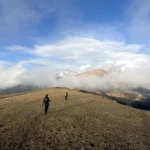
Trishul Basecamp with Ronti Saddle

Nanda Devi Base Camp
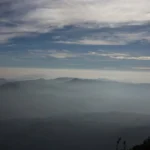
Kumara Parvatha Trek
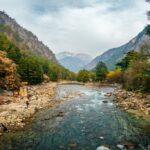
Kheerganga Trek

Dodital Darwa Top Trek

- Why Do You Choose NHTE?
- Who Are We?
- Legal Documents
- Terms and Conditions
- Clients Reviews
- Ghorepani Poon Hill Trek: Poon Hill Trek 3 Days From Pokhara
- Ghorepani Poon Hill with Mardi Himal Trek
- Short Annapurna Base Camp Trek
- Annapurna Base Camp Trek 6 Days
- 7 Days Annapurna Base Camp Trek
- Annapurna Base Camp with Poon Hill Trek 10 Days
- Annapurna Circuit Trek 10 Days
- Annapurna Base Camp Trek: A lifetime journey to the world’s 10th Tallest Peak
- Annapurna Circuit Trek 12 Days
- Mardi Himal Trek
- Khair Lake and Khopra Ridge Trek
- Mohare Danda Trek
- Jomsom Muktinath Trek
- Annapurna Circuit Trek: Explore the world’s longest Thorong La Pass
- Annapurna Tilicho Lake Trek
- Ghale Gaun Trek
- Nar Phu Valley Trek
- Poon Hill Trek 3 Days
- Langtang Trek
- Langtang Valley Trek
- Short Langtang Trek 5 Days
- Langtang Gosainkunda Trek
- Langtang Tamang Heritage Trek
- Gosainkunda Pass Trek
- Helambu Trek
- Langtang Valley and Ganja La Pass Trek
- Everest View Trek
- Everest Base Camp Trek 9 Days
- Everest Short Trek
- Everest Base Camp Trek 10 Days
- Everest Base Camp Trek 12 Days: Everest Base Camp Short Trek
- Everest Base Camp Trek: Experience Nature’s Majesty at Its Peak
- 14 Days Everest Base Camp Trek
- Gokyo Lake Trek
- Gokyo Chola Pass Trek
- Everest Base Camp Trekking
- Everest Three Pass Trek: Three High Passes Trekking in Nepal
- Everest Base Camp Trek Cost
- Ama Lapcha Pass Trek
- Pike Peak Trek
- Everest Base Camp Luxury Trek
- Everest Base Camp Trek Guide Cost
- Manaslu Circuit Trek
- Manaslu Trek
- Manaslu Circuit Trek 10 Days
- Manaslu Tsum Valley Trek
- Lower Dolpo Trekking
- Lower Manaslu Scenic Trek
- Rara Lake Trekking
- Rupina La Pass Trek
- Upper Dolpo Trekking
- Upper Mustang Trek: Discover the Hidden Nature & Culture of Mustang
- Chepang Hill Trek
- Ganga Jamuna Trek
- Kathmandu Valley Tour
- Kathmandu Chitwan Tour
- Kathmandu Chitwan Pokhara Package Tour
- Kathmandu Chitwan Lumbini Via Pokhara Tour
- Bandipur Pokhara Tour
- Bungy Jump in Nepal
- Helicopter Tour In Nepal
- Mountain Flight in Nepal
- Paragliding in Nepal
- Island Peak Climbing: Popular Trekking Peak Climb in Nepal
- Lobuche Peak Climbing:
- Mera Peak Climbing
- Pisang Peak Climbing
- Yala Peak Climbing
- Amadablam Expedition in Nepal
- Chulu West Peak Climbing
- Trekking in Nepal
- Packages Tour in Nepal
- Peak Climbing in Nepal
- Expedition in Nepal
- Rafting in Nepal
- Chitwan Jungle Safari
- Paraglading in Nepal
- Mount Kailash Tour
- Cho Oyu Expedition in Nepal
- Bhutan Tour
- Bhutan Cultural Tour
- Compulsory Equipment List
- Nepal Visa Information
- Currency & Payments
- Travel Insurance

Annapurna Base Camp Trek Weather

Trek to Annapurna base camp, where the weather varies at different elevations from low warm sub-tropical Pokhara valley. That extends to a surrounding valley full of farm villages, to cooler mid-green hills and towards arctic zone at Annapurna base camp and beautiful sanctuary. Annapurna base camp trek weather depends upon the season of the year, where Nepal and the Himalaya region with four main seasons. Spring (March to May), summer with monsoon wet months of June to August, and autumn or fall (September to November) and the coldest time of winter season (December to February).
Popular Season for ABC Trek
The most favorable and popular main season is spring when most days are clear for views and pleasant walks all the way to Annapurna sanctuary and base camp. This is one of the much warmer times in Himalaya and around Annapurna Region , where days are longer with enough sun-light hours till late afternoon from early morning.
The temperatures are perfect with fine days, where the sometimes Himalayan climate can be unpredictable with unfavorable bad weather for few days, with light afternoon rain on lower mid-green hills and snow-fall on the higher altitude from 3,000 meters above. More or less one of the best times in spring season for Annapurna base camp trek and around Himalaya region where one can enjoy clear morning views of the dramatic scenery of beautiful landscapes and an array of snow-capped peaks. The next best season weather-wise is in autumn or fall times from September to November months, one of the main and much popular time for scenic with a pleasant trek to Annapurna base camp and around massive Himalaya.
How to find the best weather before hike to Annapurna Base Camp ?
Usually, Autumn/fall season starts from September to November a perfect time to catch the spectacular panorama of the Himalaya Mountain range and Annapurna series of peaks. Where days are crystal clear with super blue sky nearly all days of the season, which makes the trek more exciting and enjoyable with constant views of high snow-capped peaks.
However, morning and late afternoon can be very cold where temperatures might drop to below – 05 degrees Celsius sometimes with chances of snow on higher altitude above 2, 500 meters. Although one of the best and perfect season of autumn/fall where sunlight hours are much shorter than in spring and summer times, as it gets dark from late afternoon onward till 6 a.m. morning.
Furthermore, the temperature is just right with a sunny day during day time from late morning till 4 p.m. afternoon. But a clear starry and bright night on high altitude and at Annapurna base camp. This is the great season where one can enjoy snow mountain views along with bright full moon night, truly a perfect time for Annapurna base camp trek and around the Himalaya region.
When is an ideal time to trek to Annapurna region ?
Wintertime from December to February, freezing temperatures at Annapurna base camp with chances of heavy snow sometimes, where mercury level drops to below – 10 degrees Celsius or more. But most of the day is much clear for views of beautiful mountains and unique landscapes. During winter season although a low time for trekking in Nepal and to Annapurna base camp, enjoy where you encounter a fewer number of trekkers.
Days are much short with sunlight hours due winter season where the sun hardly shines at Annapurna base from 7 a.m. onward till late afternoon by 5 p.m. it will be dusk with the cold breeze. In winter season enjoy the calm weather with a night sky full of bright stars and silhouette views of the high snow mountain range that adds the extra charm of the adventure on Annapurna Base Camp trek. To all know the best weather and favorable time before start the Annapurna treks and discover the flora and fauna with neat.

Our Partners

Sign Up for Our Free Newsletter

Annapurna Base Camp 14 Day Extended Forecast
Annapurna base camp extended forecast with high and low temperatures.
See weather overview
2 Week Extended Forecast in Annapurna Base Camp, Nepal
Hour-by-hour weather for Annapurna Base Camp next 7 days
Need some help?

Annapurna Base Camp Trek in March: Weather and Temperature
For beginner trekkers, the Annapurna Base Camp Trek in March can be ideal in Nepal. Given the easy grade of this trek, the gentle temperature , cheerful weather , and beautiful mountain panorama in March make this trek the best. Furthermore, vibrant rhododendron blossoms , lush bamboo forests , and serene lowland terrace farmlands can elevate your trek experience.

This blog includes everything you should know before planning the Annapurna Base Camp Trek in March 2024. We’ve briefly discussed weather, temperature, rainfall, snowfall, trekker’s volume, and major attractions in March.
Annapurna Base Camp Trek in March- Highlights
- The surreal close prospect of snow-capped Annapurna South, Annapurna I, Tharpu Chuli, Singu Chuli, Machhapuchhre, and many other peaks from the base camp.
- Vivid landscapes of the lower region, covered by rhododendrons, and the upper alpine area, covered in snow.
- Mild temperature and rain-free days for unobstructed viewing and a sweat-less hike.
- Comfortable overnights at tea houses with the best meals and hospitality.
- Comparatively less crowd in early Spring, in March, for a peaceful hike.
Why Annapurna Base Camp Trek in March?
The first thing you’ve to be clear about is why to plan Annapurna Base Camp Trek in March.
The temperature averages around 4 degrees in the daytime and drops to -16 degrees at night. The snow on the trekking trail becomes slippery and often makes the hike challenging. But some trekkers love to do this even under these conditions.
Snow capped Annapurna mountains
Everyone loves to see mountains that are significantly above 8,000 meters and blanketed with snow. And for this, Annapurna Base Camp Trek in March, in early Spring month, is the ideal time. The thick winter snowfall on Annapurna I , the 10th highest mountain in the world, at 8,091 meters, is best seen from the base camp , at 4,130 meters.
Not only Annapurna I, but you’ll also enjoy the 360-degree panoramic glimpses of Annapurna South , at 7,291 meters, Singu Chuli , at 6,051 meters, Tharpu Chuli , at 5,663 meters, and Fishtail , at 6,993 meters from the base camp of Annapurna.
The best part of being at the base camp in early Spring is that you’ll not only enjoy the snowfall but also can experience the walk to nearby glaciers.
Diverse vegetations of Annapurna Conservation Area
Whether you start Annapurna Base Camp Trek via Poon Hill or from Nayapul to Jhinu, the affluent vegetation and landscapes here surrounds and keep you in awe throughout.
The terrace farming of Birethanti, Jhinu, and Chhomrong are the first aesthetes that work as an appetizer to your Annapurna trek appetite.
The rhododendron and magnolia forest that starts from Sinuwa till Deurali with a beautiful bamboo forest of Bamboo and Dovan makes your hike serene. On top, the elegant Machhapuchhre plays hide and seek with you on your third day on Annapurna Base Camp Trek.
Besides bamboo and rhododendron, you’ll hike through the evergreen Oak forest till Dovan. Past Dovan and almost to Deurali, you’ll walk through the Brown Oak forest mixed with others like Fir and Hemlock. On top, the new leaves, buds, and fresh outlook soothe the weary legs.
And past Deurali till ABC via Machhapuchhre Base Camp, you’ll hike on an alpine landscape covered with snow.
Annapurna Base Camp Weather in March
The weather at Annapurna Base Camp in March remains stable, with relatively colder days with complete visibility. The winter rain and snowfall wash away all the dust and make the viewing unobstructed.
The days in March are also rain-free days with precipitation of just 39. But you can expect some snowfall at higher altitudes like Deurali and Machhapuchhre Base Camp, including the Annapurna Base Camp area.
Snowfall in march
March, mainly, isn’t a month for snowfall. However, in recent years, the snowfall in the mountains has been delayed.
There’s a high probability that it’ll snow at Annapurna Base Camp in March 2024 . Last year, the heavy snowfall started only after the last week of February and continued till mid-March. This year, in 2024, till the first week of February, there has been little fall at the base camps and places over 3500 meters altitude.
Hence, plan the trek here in early March if you want to experience the snowfall at Annapurna Base Camp. You’ll get to experience the snowfall in the mountains.

Rainfall in March
March is an entirely rain-free month. Hence, it won’t rain at the base camp and lower regions. However, low-altitude areas like Jhinu and Chhomrong may experience fleeting afternoon drizzles.
As it often snows at higher altitudes in March, we recommend carrying a rainproof jacket and poncho for snow showers.
Annapurna Base Camp Temperature in March
March is the first month of Spring, and it remains cold throughout. The lower regions en route to Annapurna Base Camp Trek in March start getting warmer, but the base camp remains around freezing temperature.
It’s essential to know the temperature to pack your backpack accordingly—even the daytime temperature around base camp averages around 4 ˚C , which is near freezing. The maximum daytime temperature you can expect around base camp, past Deurali to Machhapuchhre Base Camp, is 7 ˚C .

The evening and night become even colder, with the temperature dropping to -10 ˚C . For warm sleep, we recommend you carry a sleeping bag. Also, for warm day hikes against the wind, you must wear warm thermal layering and a down jacket.
This is what Annapurna Base Camp Temperature in March looks like.
Crowd and Accommodation
You’ll find it easy to get the tea houses for accommodation in Annapurna Base Camp during March, as many trekkers don’t plan this hike due to cold temperatures. March remains cold; hence, only a few trekkers plan the ABC trek this month. Otherwise, as they flood with trekkers, you’ll barely get a room in the tea houses in April and May.
Even in the cold March, the accommodations at tea houses will be warm. You’ll get comfortable beds with mattresses, clean blankets, and pillows. You’ll also get attached bathrooms at most tea houses.
Annapurna Base Camp Trek in March- Recommended Routes
Annapurna region blooms in Spring, from early March till the end of May. Everything becomes magical with the greenery, vibrant landscape, rhododendron blossom, terrace farms, hamlets, and hilltops. Thus, instead of just trekking to base camp from Jhinu, planning the Annapurna Base Camp Trek in March with longer itineraries would be best. Visiting places like Ghandruk, Ghorepani, and Poon Hill offers a pleasing cultural, natural, and panoramic walk before leaving for the base camp.
The most popular Annapurna Base Camp Trek 10 days take you to beautiful Gurung hamlet Ghandruk, the Chhomrong, and the base camp. Other popular trek routes include Annapurna Base Camp Trek via Poon Hill , and some courses are via Tadapani.
Or, if you want a short trek, you can join our Annapurna Base Camp Trek 5 days from Pokhara . Also, if you want to trek more after returning from base camp, you can trek to Ghandruk, Ghorepani, and return to Pokhara.

I'm Saroj Dahal, a Nepal government-licensed trekking guide, co-founder, blogger and SEO specialist at NepTrek Adventures, landscape photographer, travel film-maker, and musician.

Annapurna Base Camp Trek Permits- Cost, Types & Validity

Everest Base Camp Trek Itinerary- 12 Days
Related posts, nar phu trek blog: my 10 days trek experience in nar phu valley, nar phu valley trek with kang la pass- cost and itinerary for 2024, write a comment cancel reply.
Save my name, email, and website in this browser for the next time I comment.
- Everest Region Trekking
- Annapurna Region Trekking
- Langtang Gosaikunda Trekking
- Off the Beaten Trekking
- One Day Helicopter Tour
- Luxury Tour
- Family Tours
- Pilgrimage Tour
- Jungle Safari Tour
- Short Day Hikes
- Whole day hike
- Multiple days Hike
- Travel Guides

- Annapurna Base Camp Trek in March
- Annapurna Trek Guide
- Aug 29, 2019
- Index Adventure
Table of Contents
Annapurna Base Camp trek holds secret treasures for mountain lovers. March is the best time for trekking and to enjoy the magnetic mountain peaks. Starting in March, the ABC trekking trail will be crowded with a lot of trekkers.
March, the month of Rhododendron, is the time of spring season in the Annapurna region . While trekking in March, you will collect the fondest memories in a pleasant and moderate climate.
March is a shoulder month which brings an aromatic spring after the snowy winter.
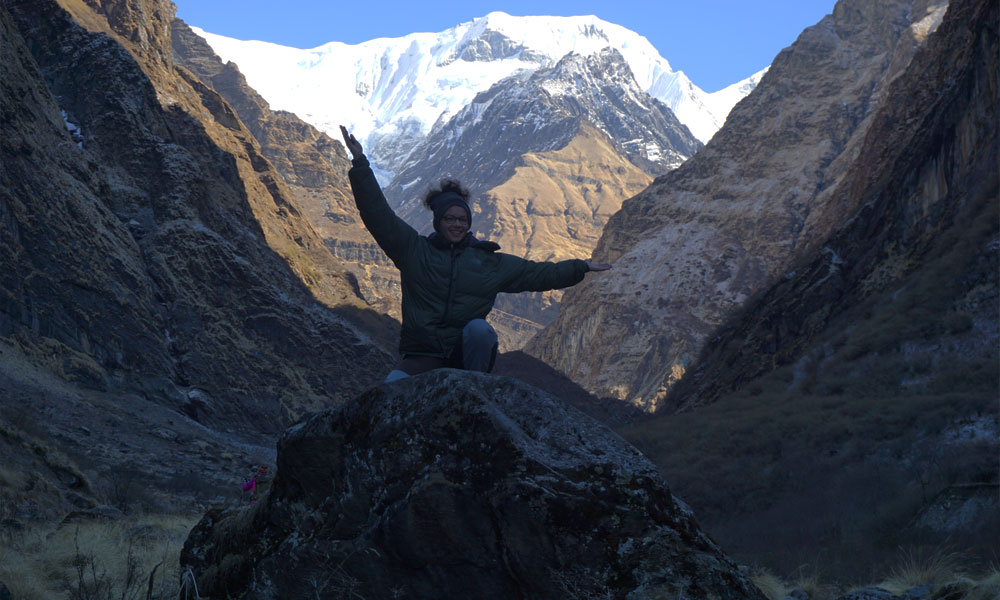
The trail will bloom with red and white Rhododendrons and many wildflowers found in this region. The trek summarizes the beauty of green terraced fields, quaint Gurung villages and a wide variety of flora and fauna.
The outstanding view of Mt. Annapurna (8091m), the 10th highest mountain in the world from the base camp (4130m) is precious. Moreover, the panoramic views of Mt. Machhapuchhre (6997m), Glacier Dome, Gangapurna (7454m), the unclimbed Fang (7647m), etc are awe-inspiring.
Highlights of Annapurna Base Camp Trek in March
- Distinct mountain views that leave you spellbound
- Enchanting sunrise view from Poon Hill
- A close panorama of the world’s highest mountains including Dhaulagiri and Annapurna
- Overnight at the Annapurna Base Camp
- Spectacular views of the glacier from Annapurna Base Camp
- A warm bath in hot spring at Jhinu Danda
- The silvery peaks glowing with the golden and orange tints during sunrise
- The Gurung Museum in Ghandruk
- Exotic floral and faunal diversity
- A peek into rich Nepali tradition and culture
- Trekking inside the Rhododendron forests of the Annapurna Conservation Area.
- Amazing forests, that come alive.
- Rhododendron forests in full bloom.
- Aroma of different flowers along the trekking trail will keep you enchanted.
Are you planning your Annapurna Base Camp Trek? Don't hesitate to contact us . Tell us your requirements, we can help you to make your trip memorable.
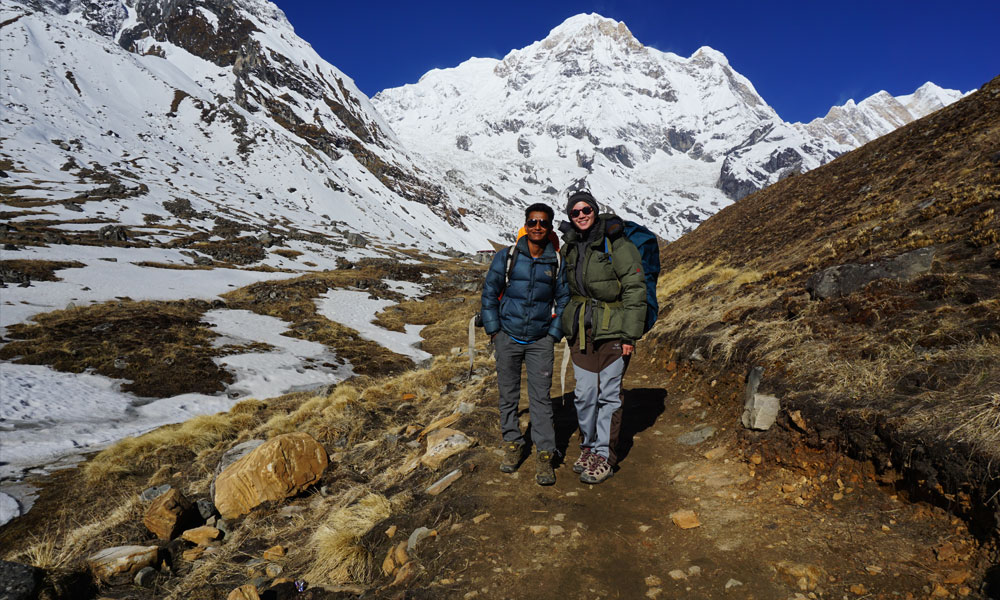
Annapurna Base Camp Temperature and Weather in March
March is the springtime in Nepal. The weather during March is perfect for an ideal trekking in the Annapurna region.
The warm weather in spring, the green forests, blossoms of various wildflowers including Rhododendron are truly fascinating. The bright red hills of Rhododendrons bring more trekkers in this month. The trekking trail is clean and dry with no snow. Watch out for the avalanche though.
March is a beautiful time for crystal clear views. The average daytime temperature at lower altitudes is around 10 degrees Celsius during sunshine. The higher you go, the colder it gets. As you ascend over the height of 4000m is you experience the freezing cold in the evenings and mornings. The daily maximum and minimum temperatures are around -4 to -8degree Celsius. While nights are usually just on freezing temperature of about -10degree Celsius.
How Difficult is Annapurna Base Camp Trek in March?
ABC trek is a moderate trek. It doesn’t need an advanced physical fitness level. Nor, it demands any previous trekking experiences. Anyone can do this trek and enjoy the pleasing time with nature.
March brings a dry, warm and stable weather in the Anapurna region. Adding colors of wildflowers to the beautiful hills, it adds joy to the trek. So, there is no risk of difficulties while trekking in ABC during March.
If you choose the Ghorepani trail to trek to ABC, your body gets adapted and acclimatized with high altitude along the trail.
Trekkers with previous trekking experiences can trek it in short period of time and more easily. During the ABC trek, will reach hit the highest elevation of 4130 meters from sea level. Some may feel symptoms of Altitude sickness, but if you walk slowly, maintain hydration, and take proper rest you can walk easily to the base of the giant peaks.
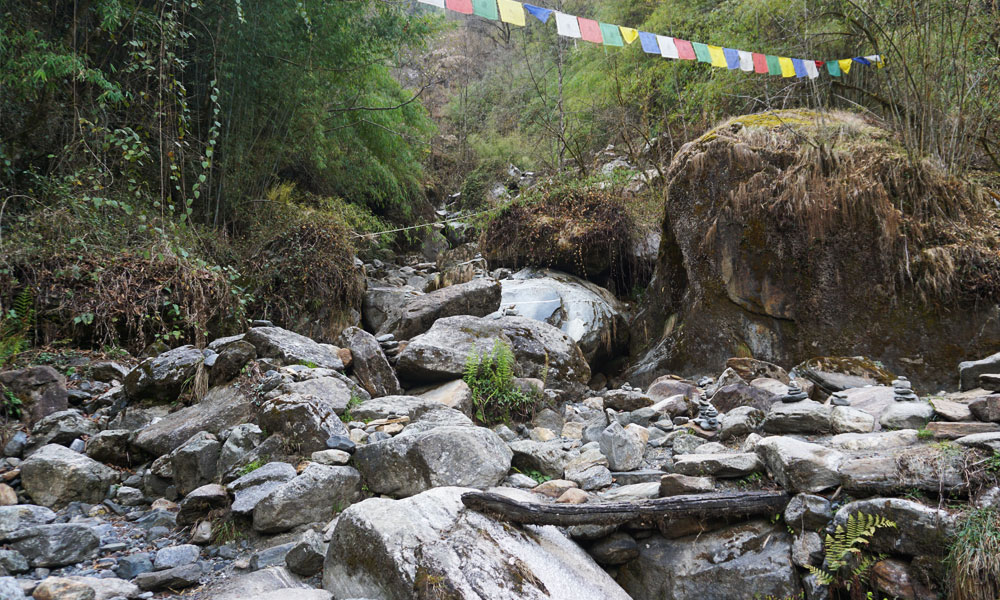
Meals and Accommodation during ABC Trek in March
Accommodations
March indicates the beginning of spring in the Annapurna region. It is the most trekked month after Autumn. The perfect weather and alluring natural beauty attract lots of trekkers during March.
In March, single rooms are easily available in Kathmandu, Pokhara and the trekking regions at the lower elevation. However, you will have fewer options for accommodation at higher elevations.
$2 is an average price per day for a stay in normal tea houses or lodges. You can take a small private room with twin beds. If you are large in number, you can book a dorm room with 4-6 beds.
The rooms are small but tidy. If you expect luxury accommodation, you can stay in the fancier hotels. They cost much more than general teahouses.
During ABC trek, locals expect you to eat where you stay. Teahouses make most of the money on food rather than on lodging.
The tea-houses where you stay serves a breakfast and dinner. They will serve you anything from the lodge menu (Menu has lesser options at higher elevation). Enjoy your lunch at some place on the way to the next destination.
You will have different food options to choose from. You can enjoy typical Nepalese food as well the more common international dishes. In common, you can have eggs, chapatti (a bread prepared in a local way), cereals with milk, and sandwiches for breakfast.
You can have potatoes, noodles, chowmein, momo, macaroni, pudding, Dal Bhat Tarkari, etc for lunch and dinner. Dal Bhat, a Nepalese dish, is the cheapest and most filling option in the food menu.
For drinks, you can have tea, coffee, plain warm water, or flavored hot drinks.
They do sell local as well as branded alcohols. If you drink, better drink while you are returning. (Alcohol and caffeine will increase the risk of AMS.)
On average, $25 per day will cover three meals. With this amount, you may choose anything to eat. It also includes many cups of hot beverage.
Trekking Permits and Costs for Annapurna Base Camp
To trek to Annapurna Base Camp, you will require two permits:
- Annapurna Conservation Area Project (ACAP) permit
Nrs.200 ( US $2 ), for SAARC countries
Nrs.3000 (US $30), for other nationals
- Trekkers’ Information Management System (TIMS) card
NRS. 2000 ( US $20)
You should also carry
- Copy of passport
- travel insurance
- Credit card ( in case of evacuation)
Trekking Gears Required During Annapurna Base Camp Trek in March
It is what you carry inside your trekking that determines your trekking experience. Whichever season you are trekking you must pack wisely. Instead of increasing the weight you must pack wisely.
Not having proper gears can be troublesome during long treks.
Listed below are the equipment that you should bring to Annapurna Base Camp trekking.
- Lightweight trekking boots . The trekking boots offer more safety during long treks. But, your shoes must be well fitting, light and comfortable.
- Two or more pairs of trekking socks . Trekking socks are better. But an ordinary pair of socks is also usable.
- Windproof jacket and trousers Keep in mind that you will see both the cold and warm temperature at ABC. So do not forget to pack down jackets and warm trousers as well.
- A set of thermals and trekking T-shirts.
- A lightweight sleeping bag.
- A trekking pole. Though easy, there are many ups and downs in this trek. A trekking pole can assist you throughout the hikes. (You can find yourself a sturdy stick in route)
- Sunglasses, sunscreen cream, and lotion
- A First Aid Kit including Oral Rehydration Salts (ORS)
- Iodine tablets, Airtight water bottle, long-sleeved shirt, lip balm.
- Toiletries– Toilet paper, hand sanitizer, water purifiers, moisturizer, toothpaste, and toothbrush.
- A map of Annapurna Base Camp
- Snacks and entertainment like books, cards, an iPad etc.
Some Extra Tips to Annapurna Base Camp Trek In March
- Weather changes frequently in high altitude areas. Bad weather can hit the Annapurna region even in March. So, be prepared and carry the necessary equipment for your trek.
- Spring is a busy season at Annapurna region. The trekking trails are more populated. Teahouses or lodges in the route may be already occupied. You may also have to stand in queues for meals. So, a book for accommodations earlier.
- You must start your trek right after an early morning breakfast. This helps you to reach your destination earlier. So, there are more chances to get the best rooms for overnight stays.
- The cold mornings and nights are harder to cope with. So, pack some warm clothes and other accessories during the trek.
- Do not worry about the heavy loads of your backpacks. You can hire a local porter to carry your loads.
- Maintain your own slow and steady pace during the trek. Do not rush. It isn’t a one day hike. So take proper care of your body.
- Hydrate yourself properly. Your body dehydrates faster as you ascend the higher altitudes. Drink safe and non-polluted drinking water. You can also carry fruit juices or some energy drinks with you.
- Take some extra snacks with you. They include energy bars, chocolates, and other instant energy providing foods.
- In cases you see any symptoms of Altitude Sickness , do not hesitate to notify your guide or a partner. Walk down to lower altitude and rest till you are fine.
- Carry enough cash with you during the trek. There are no ATMs in the ABC route.
- Public display of affection is not welcomed and wearing revealing dresses will earn you unwanted criticism.
- It is rude to click people without their will. Ask them first, if you want to click their pictures.
Final Say ,
You can never say no when you get an invitation of heavenly views of the majestic Himalayas in Nepal. March, is a perfect time for the Annapurna Base Camp Trek. If you can spare your time to trek in March, you should surely go for it.
Do you need additional information on this trek? Do you want to join this trip with us? If yes, contact us . We will be happy to customize our trip as per your convenience.
Send an Inquiry
Recent post.
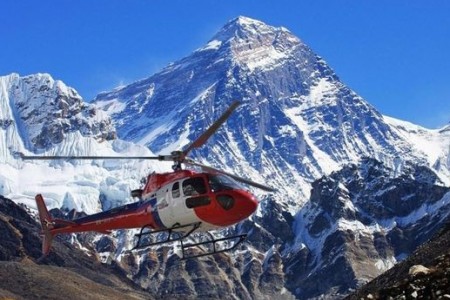
Why to choose EBC helicopter tour?

Safety tips for helicopter tour
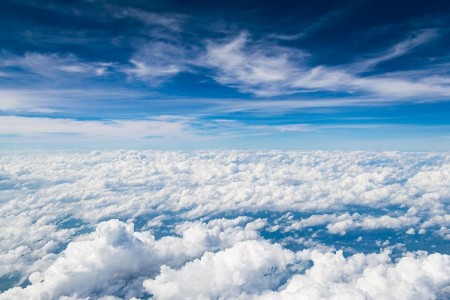
Flying to the top of the mount Everest
Related posts.
- Annapurna Circuit Trek Altitude Sickness Guide
- Annapurna Circuit Trek Weather and Temperature
- How long is the Annapurna Circuit Trek
- How to prepare for Annapurna Circuit Trek
- Annapurna Circuit Trek 15 Days
- Ghorepani Poon Hill Trek Weather
- Poon Hill Trek Cost
- Annapurna Helicopter Tour Cost - A Complete Guide
- Adventure Activities
- Bhutan Tour Guide
- Everest Trek Guide
- Kanchenjunga Trek Guide
- Langtang Guide
- Manaslu Trek Guide
- Mardi Himal Trek
- Mustang Guide
- Peak Climbing
- Uncategorized
- Visit Nepal Year 2020
Index Adventure Pvt. Ltd.

Is Everest Harder than Annapurna?
When it comes to touring adventures, Annapurna Base Camp (ABC) and Everest Base Camp Trek (EBC) are two of the most iconic destinations in Nepal. Various individuals fantasize about vanquishing these marvelous paths, yet which one is really more earnest? How about we buckle under the correlation and find out.
Highlights of Everest and Annapurna:
Annapurna Base Camp Trek Highlights
- Stunning Views The Annapurna Circuit Trek offers panoramic views of the Annapurna mountain range, including peaks like Machapuchare (Fishtail). The different geographies along the way are truly stirring.
- Different foliage trampers can anticipate a rich variety of natural beauty, from rhododendron timbers to snow-covered peaks.
- Sunrise from Poon Hill One of the most famous print spots is the beautiful daytime view from Poon Hill. It’s a magical ride that ought not to be missed.
Everest Base Camp Trek Highlights
- Dramatic Views The Everest Base Camp Trek presents extra dramatic views of the world’s tallest peak, Mount Everest, along with skirting peaks like Lhotse and Nuptse.
- Sherpa Culture Climbers can discover the special Sherpa subculture in the Khumbu region. The location is stuffed with ample Sherpa townlets, including the normal experience.
- Kala Patthar Another iconic print spot is the panoramic outlook of Mount Everest from Kala Patthar. The rough quality of the Everest area is truly surprising.
- Both Mount Everest and Mount Annapurna are redoubtable pinnacles, yet they contrast in their difficulties. We should separate it.
- Everest is the tallest mountain on the planet, remaining at 29,029 feet ( 8,848 meters) over the sea..
- Annapurna is more limited, with a height of 26,545 bases( 8,091 measures).
- An advanced chance of rovers has failed while trying to peak Annapurna further than on any other peak.
Everest has two fundamental courses: the North Edge and the South Col. The North Edge is more customary yet intricate, while the South Col course is fresher and less muddled, however more perilous because of the Khumbu Icefall.
Annapurna offers three primary courses the Northwest Edge, the Southwest Edge, and the Southeast Edge, which are all viewed as muddled.
- Everest avalanches, crevasses, indurating temperatures, high winds, and lack of oxygen.
- Annapurna avalanches, rockfalls, falling ice, glaciers, and crevasses.
Terrain of Everest and Annapurna:
Everest Base Camp Trek
- Steep ascents and descents. Rocky terrain with some technical sections.
- The altitude reaches up to 3420 meters in Namche Bazaar on Day 2.
- Constantly surrounded by knife-like peaks.
- Gyoko Lakes and lesser-trekked passes at ChoLa offer great detours.
- Island Peak provides some of the most stylish views in the Himalayas.
Annapurna Base Camp Trek
- Further gradational ascent and descent.
- Smaller, steeper climbs and gentler descents.
- The average altitude is much lower than that of Everest.
- Different geographies, including gorgeous rhododendron timbers.
- Colorful trail options, some not exceeding 2000 meters in altitude.
- The circuit route allows touring new terrain every day without retracing steps 12.
Best Time to move toward Everest and Annapurna:
Annapurna Circuit
Autumn (October and November) Extensively considered the stylish time for touring the Annapurna Circuit. During this season, the rainfall is generally clear and dry, with affable day temperatures ranging from 15 °C to 20 °C (59 °F to 68 °F) at lower elevations. It’s an excellent time to enjoy stunning mountain views and explore traditional village life.
Spring (April and May) Another great option. The rainfall remains stable, the skies are clear, and temperatures are comfortable. This season is also busy with pedestrians heading to Annapurna Base Camp.
Everest Base Camp
Autumn (October and November) is ideal for the Everest Base Camp journey as well. Clear skies, mild temperatures, and stirring mountain lookouts. You’ll need a minimum of two weeks for the journey to Base Camp and back. Consider adding redundant time to explore the quieter but inversely stunning Gokyo Valley.
Spring (April) Another good choice. analogous rainfall conditions as in the afterlife, but with smaller crowds. Keep in mind that breakouts to Lukla( the trailhead for Everest) can be grueling during the high season due to rainfall disruptions.
The key things that made Mount Everest difficult:
Heat, dust, cold, and shit: The trek itself is nearly two weeks long, and throughout that you’ll be exposed to wide variations in temperature (it can be hot during the day but it’s invariably cold at night) and an environment that’s dusty and where you’re almost certain to pick up an upset stomach at some point. Coping with that over an extended period of time is almost as hard.
Altitude and appetite: Stuff doesn’t taste as nice at altitude. Your taste buds are dulled. And the food that you’re going to eat is going to be carried in from somewhere on the back of a yak or a sherpa, so variety is at a premium. Forcing yourself to eat a rubbery omelet because you know you need the energy is almost the most grueling part of the trip. Take something with a strong flavor to liven things up.
Water. Acclimatization is basically the process of your body excreting buffering chemicals from your bloodstream so your blood doesn’t get too alkaline. It can only do this through your urine. You’ll need to drink 3 liters or more of water each day to acclimate properly; I was drinking 5, but then I’m huge. A good, insulated water reservoir system is a great idea (though on cold days, make sure you blow the water back into the reservoir so it doesn’t freeze in the tube), and I found that hanging it on my chest inside my jacket kept it from getting too cold.
The right kit goes a long way toward making life more comfortable. Good boots and socks, multiple layers (including merino baselayers), a down jacket, a good breathable waterproof, a range of hats for sunny and cold conditions, very warm gloves (down mittens if you can get them), a decent down sleeping bag and silk liner, a self-inflating sleeping mat, good sunscreen, and lots of alcohol hand gel will go a long way towards making the trip easier to endure.
Trekking. Beyond kit, the secret of successful trekking is simple: don’t stop. The temptation when walking at altitude is always to stop when you get out of breath. Don’t. You’ll waste energy stopping, starting, and warming up after you stop, and it will take longer.
Find a pace, however slow, that you can maintain indefinitely, and aim to walk for about half an hour between stops. We got the weakest walker in our group to adopt this approach, and on one of the longest ascents, she went from the back of the group to very near the front.
While both treks offer unforgettable experiences, Everest Base Camp provides more dramatic views of Everest itself, while Annapurna Base Camp offers diverse landscapes and closer views of the Annapurna Range. Choose the one that resonates with your preferences and abilities!
Everest is taller and more complex, Annapurna is more deadly. If you’re unsure of your mountaineering abilities, Annapurna might be a slightly less taxing choice due to its lower average altitude and fewer steep climbs. Ultimately, both mountains require significant preparation, skill, and courage.
The post Is Everest Harder than Annapurna? appeared first on Mom and More .
![Overview: When it comes to touring adventures, Annapurna Base Camp (ABC) and Everest Base Camp Trek (EBC) are two of the most iconic destinations in Nepal. Various individuals fantasize about vanquishing these marvelous paths, yet which one is really more earnest? How about we buckle under the correlation and find out. Highlights of Everest and […] Overview: When it comes to touring adventures, Annapurna Base Camp (ABC) and Everest Base Camp Trek (EBC) are two of the most iconic destinations in Nepal. Various individuals fantasize about vanquishing these marvelous paths, yet which one is really more earnest? How about we buckle under the correlation and find out. Highlights of Everest and […]](https://img-s-msn-com.akamaized.net/tenant/amp/entityid/BB1moeY7.img?w=768&h=1152&m=6)

COMMENTS
By far the most popular trekking season in the Annapurna region. Hikers flock to the region to experience the clean, fresh and vitalised area after the Monsoon period. On the lower reaches of the Circuit the weather is generally warm with an average day temperature of 15 degrees Celsius and night temperatures remain above freezing.
The average midday temperature of the Annapurna Circuit Trek begins to fall, touching approximately 10 C to 5°C. As well as the nocturnal temperature decreases to -5°C. In the course of this period, the regions beyond 4000 m are much colder. Around the beginning of December, the weather will be tolerable.
On the lower regions of the Annapurna Circuit trek, the weather is generally warm. The days have an average temperature of 15 degrees Celsius. The nights are slightly colder at 7-8 degrees Celsius. The higher altitudes are colder. Areas above 4000m of this trek have negative degrees temperature.
The Annapurna Circuit Trek low temperature typically varies from 10°C to 5°C at midday. Furthermore, the overnight low is -5°C. Above 4000 meters, it gets considerably cooler throughout this month. The weather is manageable at the start of the month. The weather turns icy in the last few days of this month.
The weather in autumn (September-November) is milder, with temperatures averaging between 20-25°C (68-77°F). This season is generally dry and comfortable for trekking. Winter (December-February) is the coldest season on the trek, with temperatures ranging from 5-10°C (41-50°F).
The average daytime Annapurna Circuit Trek temperature starts to drop, reaching around 10°C to 5°C. And the night temperature falls as low as to -5°C. The areas above 4000m are even colder during this month. The weather is bearable at the start of the month.
It's one of the world's classic long-distance hiking trails, and still one of Nepal's most popular treks. The Annapurna Circuit, a 12 to 21-day route that begins in the lush green villages of the Himalayan foothills. Taking trekkers over the 5,416m Thorong La Pass and down to the Tibetan-influenced temples and communities of the Mustang ...
The weather and temperature at Annapurna Circuit are quite similar in October and November. The weather is stable and clear with best views of the glistening Himalayas, valleys, hills, and mountains. The lower region in the trek is warmer with daytime temperature averaging around 15 degrees.
Annapurna Circuit Trek Weather In Autumn: Autumn(September to November) is the ideal season for the Annapurna Circuit trek due to its pleasant weather, natural beauty, and cultural experiences. The daytime temperatures range from 15°C to 20°C, providing a comfortable balance for trekking. However, as the sun sets and darkness sets ...
A moderate fall of snow, heaviest on Sun morning. Extremely cold (max -13°C on Sun night, min -16°C on Fri morning). Wind will be generally light. This table gives the weather forecast for Annapurna at the specific elevation of 8091 m. Our advanced weather models allow us to provide distinct weather forecasts for several elevations of Annapurna.
The weather forecast for Annapurna Sanctuary is: Moderate rain (total 10mm), heaviest on Wed afternoon. Mild temperatures (max 7°C on Thu afternoon, min 2°C on Tue night). Wind will be generally light. Annapurna Sanctuary Weather (Days 3-6): Light rain (total 8mm), mostly falling on Sun afternoon. Mild temperatures (max 8°C on Fri morning ...
The average temperature ranges from 18 to 22 degrees Celsius during the daytime, but the nights are colder than the days. The higher altitudes have lower temperatures. You can enjoy bright, warm days at altitudes above 4000m. Best Time For Annapurna Circuit Trek.
Annapurna Circuit Trek Weather in January. January is in the middle of winter, and thus the weather gets freezing. The average temperature varies between 1oC to -10oC. In elevations below 4,000m, the average temperature ranges between 7oC to 12oC. Due to the cold and harsh temperatures, there are fewer crowds in January.
While trekking in Annapurna Circuit in September, you will experience a temperature of - 4 to 5 degree Celsius at Thorong La pass. However, at the lower altitudes, the daytime temperatures are favorable to trek. Nights are colder than the days. At Mustang, the temperature averages around 11-degree celsius.
The temperature of Annapurna circuit trek during autumn is 15 Degree Celsius on average. Reaching a high altitude like Thorong La Pass, the temperature tumbles down quickly. Annapurna Circuit Trek temperature during Spring. Spring has maintained a high standard in terms of Annapurna circuit trek weather and temperature.
Annapurna Circuit trek weather and temperature in November. November is the last month in the autumn season and also the last-best month of the year for the Annapurna Circuit trek. Trekkers get another excellent window to explore the Annapurna Circuit's rugged beauty. Much like October, November presents favorable weather conditions with clear ...
Annapurna Base Camp temperature in April ranges between °8C to 4°C during the daytime. You must add layers as the temperature drops to -4°C, increasing the cold at night. However, the pre-monsoon showers disrupt your trek. The clouds loom over the sky, with mountains often playing hide and seek.
When is an ideal time to trek to Annapurna region ? Wintertime from December to February, freezing temperatures at Annapurna base camp with chances of heavy snow sometimes, where mercury level drops to below - 10 degrees Celsius or more. But most of the day is much clear for views of beautiful mountains and unique landscapes.
April falls in the spring season. The temperature rises up to 20 degrees Celsius / 68 degrees Fahrenheit and falls as low as -9 degrees Celsius / 15.8 degrees Fahrenheit. This is just a moderate range of how the temperature normally is. Keep in mind that the temperature and altitude vary inversely.
Annapurna Base Camp 14 Day Extended Forecast. Weather Today Weather Hourly 14 Day Forecast Yesterday/Past Weather Climate (Averages) Currently: 70 °F. Passing clouds. (Weather station: Kathmandu Airport, Nepal). See more current weather.
The first thing you've to be clear about is why to plan Annapurna Base Camp Trek in March. The temperature averages around 4 degrees in the daytime and drops to -16 degrees at night. The snow on the trekking trail becomes slippery and often makes the hike challenging.
March - the month of flowers, birds, and eye soothing views is among the best times to trek the Annapurna Base Camp. Choose to trek with us. We promise you a delightful trek. +977 9851167996 (Keshab) info@ ... Some Extra Tips to Annapurna Base Camp Trek In March. Weather changes frequently in high altitude areas. Bad weather can hit the ...
These periods offer the most favorable weather conditions, with clear skies, moderate temperatures, and reduced chances of rainfall, warmest season or snowfall. ... Highlights and attractions of the Annapurna Circuit via Upper Mustang Trek. The Annapurna Circuit via Upper Mustang Trek is a true feast for the senses, offering a diverse array of ...
Overview: When it comes to touring adventures, Annapurna Base Camp (ABC) and Everest Base Camp Trek (EBC) are two of the most iconic destinations in Nepal. Various individuals fantasize about ...